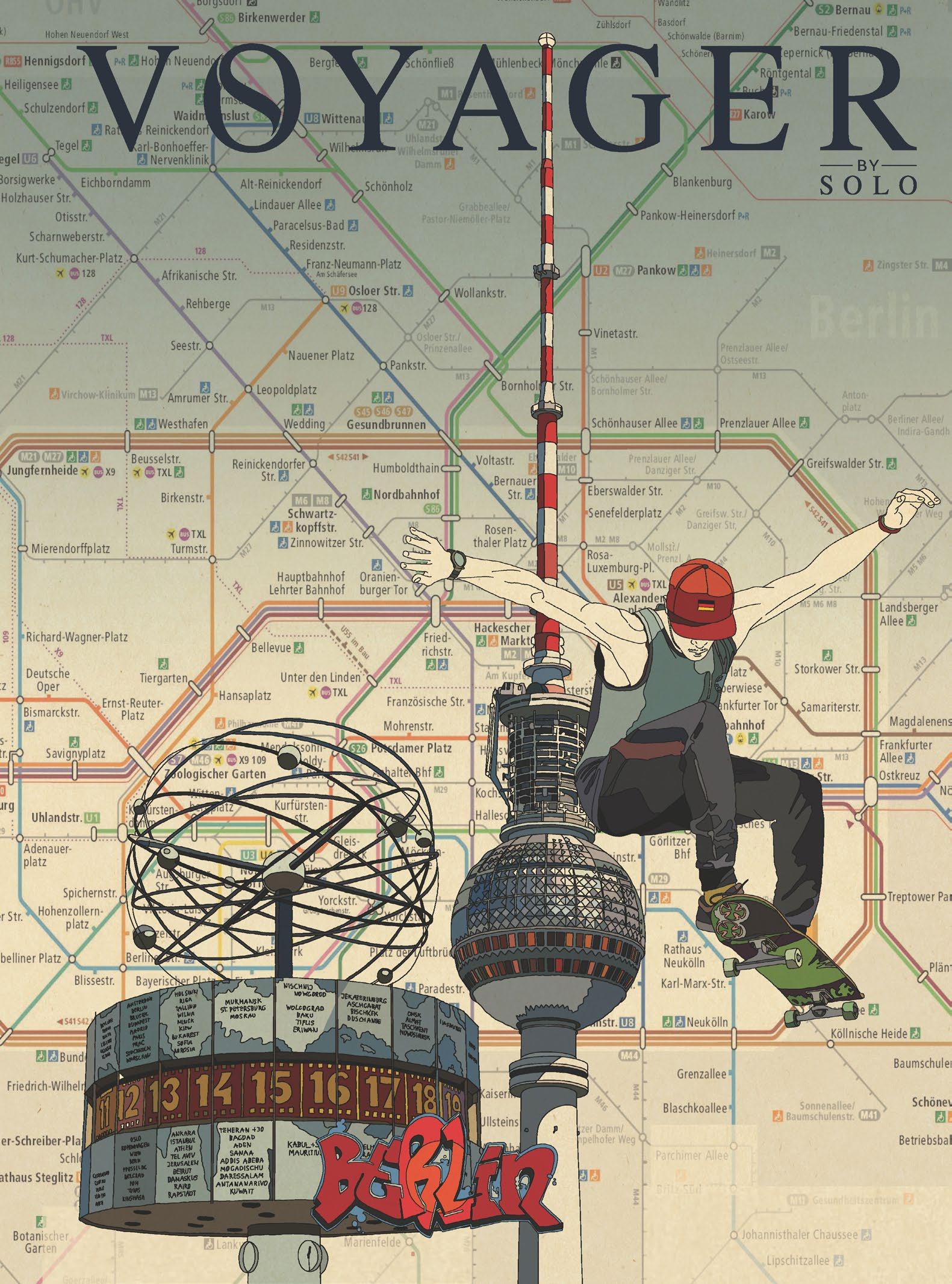
GERMANY WINTER 9/2017
 ROBERT DE NIRO and BENJAMIN MILLEPIED, NY, 9am
ROBERT DE NIRO and BENJAMIN MILLEPIED, NY, 9am

DISCOVER THE CONVERSATION AT ZEGNA.COM #ZEGNACONVERSATIONS
TIME IS THE ESSENCE WE ARE MADE OF

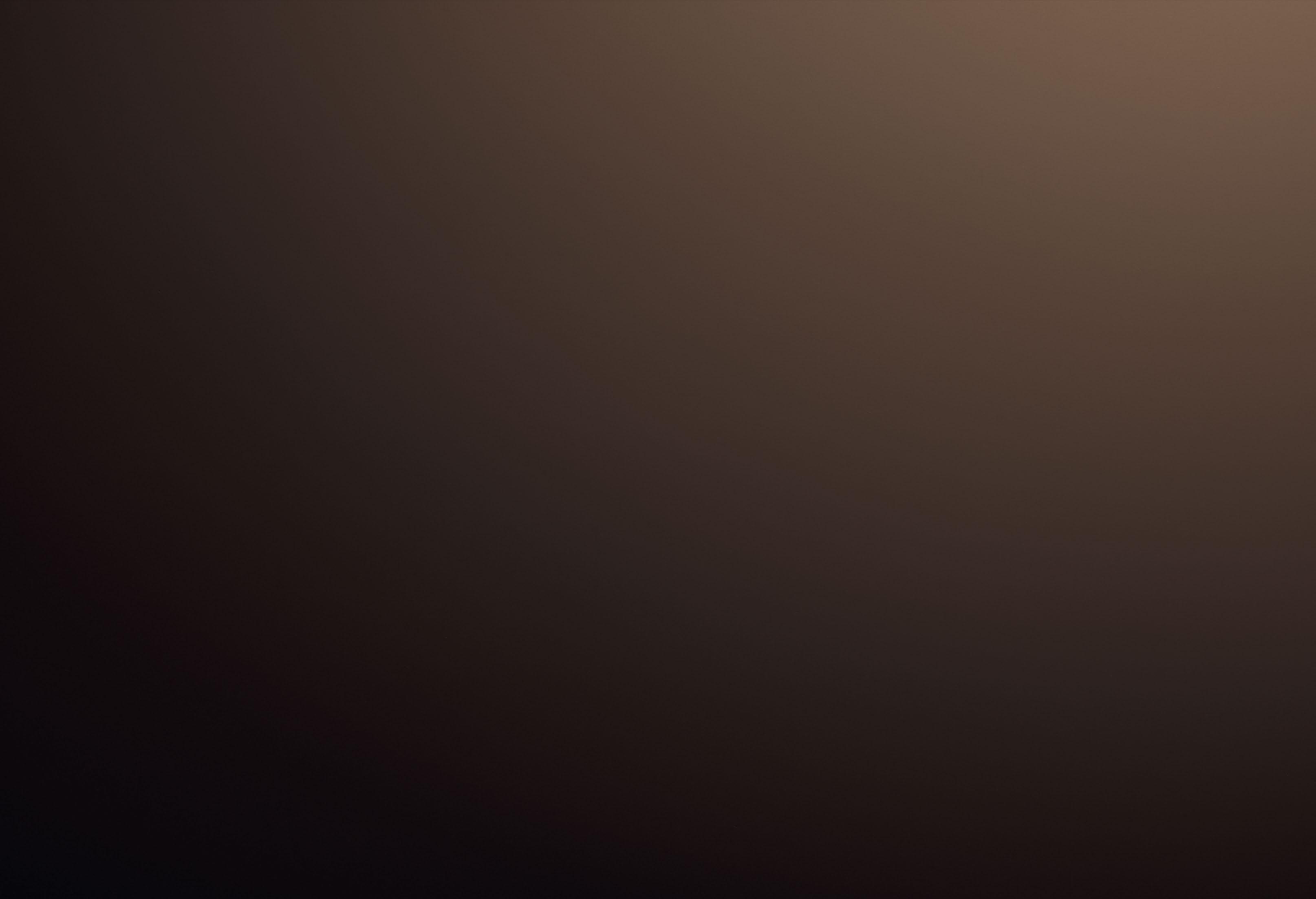
RADO DIAMASTER GRANDE SECONDE

PLASMA HIGH-TECH CERAMIC . METALLIC LOOK . MODERN ALCHEMY.

RADO.COM



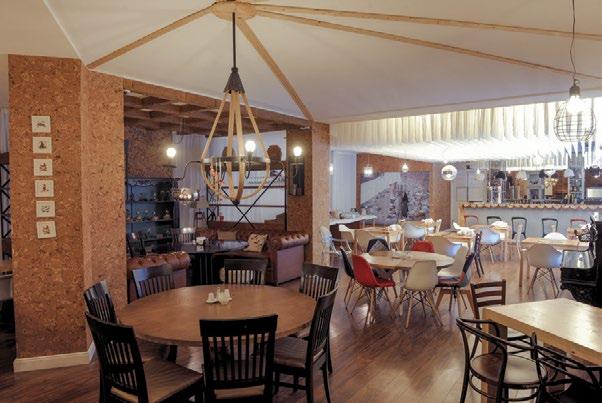




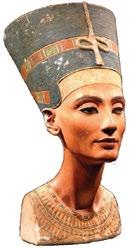
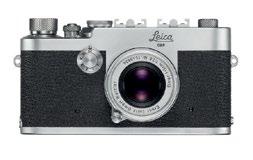


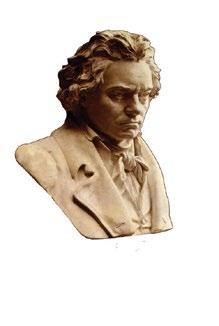

CONTENT BERLIN DISTRICTS / SIGHTS MUSEUMS / HOTELS SELECTED ROUTE TRAVEL/ RESTAU RANTS / CAFES BREAKFAST / LUNCH / MARKETS BARS / CLUBS / SHOPPING GERMANY 52 BERLIN 54 BERLIN MYTHOS 56 SPECIAL EARS FOR THE WAGNER FESTIVAL 60 ADVANCED GERMAN 68 THE LESS THE BETTER 70 BUILDER OF THE FUTRE 74 ELEKTRONISCHE DEUTSCHLAND 78 THE DASSLER SAGA 82 COUNTRY OF UNIVERSITIES 86 ASIAN CUISINE WITH A GERMAN SAUCE 88 GASTRONOMY DISHES / PASTRIES / SAUSAGES / CHEESE THE MIRACLE OF RIESLING / GERMAN BEER OKTOBERFEST 100 CITIES MUNICH / HAMBURG FRANKFURT / COLOGNE / POTSDAM DRESDEN / BADEN-BADEN / BREMEN 14 / 51 102 / 126 BERLINS L mogzaurisaTvis O O 92 / 99


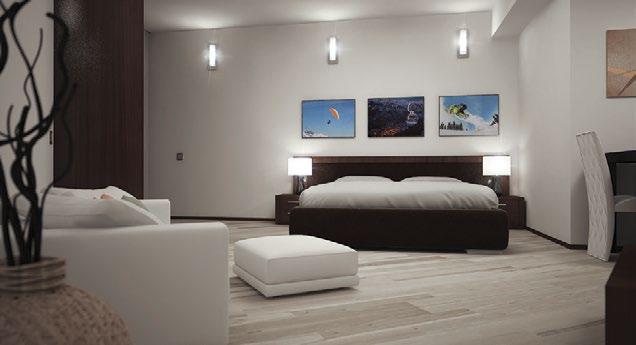

Air saturated with freedom--Berlin’s main attraction; and also, the city’s unique ability to reinvent itself in every era.
Boundless fantasy and loyalty to freedom are always manifest in Berlin. Spend one day in this city and Berlin’s freedom will surround you quietly, as if through the air. You will be able to boldly declare: Ich bin ein Berliner – I am Berliner too. Here you will feel at home.
Berlin will amaze you with many things, from the altar at the Pergamon Museum to the dance “temple” of Berghain. The city that was divided in two for half a century is now a unified cultural phenomenon. It is a unity of past and future, culture and subculture. It is always on the move, creating, never sleeping. Berlin is a unique cocktail of cheap prices, creative artistic scenes, huge urban green spaces and celebrated freedom.
The ever-renewing and changing urban development policy in Berlin turned the city into a world youth center; its enhanced cultural infrastructure and appropriate financing has resulted in an eruption of new creative energy.
Today, Berlin is the best stage for youth from different countries who come to discover and showcase their abilities. This is why selected artists, creative innovators, scientists and new generation businessmen assemble here
along with the talented chefs who have turned the city into a culinary paradise in the scope of just a few years and enriched it with culturally diverse restaurants.
In the XXI century, Berlin has acquired its new face stubbornly and consciously. Very few cities can compare to Berlin in terms of innovation, fullness of life and its organized environment.
You have to find Berlin on your own. Aka Morchildaze, one of our authors says: “it is a great city, with old imperial breadth and plazas, legendary buildings, deep history and characters, amazing museums, old alleys, huge stores, a vast transport network, people of different nationalities; but it is still very different. As if it has a secret urban magic. Tourists are not necessarily drawn to the famous Berlin sites, but to the everyday life of the city. Living in modern-day Berlin is the city’s main attraction”.
Become a SOLO traveler, see the recommendations of Voyager by SOLO the Germany edition, feel the special attraction of Berlin and start your journey into this wonderful country from its capital.
Tea Skhirieli Editor-in-Chief

EDITOR'S NOTE

12years FURNITURE LIGHTING KITCHEN CURTAIN WALLPAPER CERAMIC TILES SANITARY WARE PARQUET DOOR OPENING New Showroom DESIGN AVENUE GEORGIA, TBILISI, S.KANDELAKI ST.№15 TEL: 0322 68 08 08 | WWW.DESIGNAVENUE.GE | INFO@DESIGNAVENUE.GE
Editor-in-Chief
Tea
Skhirieli Designer
Nino Kavelashvili
Illustrations by Maia Sumabdze
 Translation by Lika Barabadze
- Shutterstock GNTB
Translation by Lika Barabadze
- Shutterstock GNTB
9, 2017
Publisher: LTD SOLO
Phone.: +995 32 2 44 44 00
ISSN: 2346-8130
Authors:
Aka Morchiladze
Lasha Bughadze
Salome Dadunashvili
Nino Daraseli
Bidzina Baratashvili
Kakha Tolordava
Zuka Babunashvili
Giorgi Maisuradze
Nikoloz Chkhaidze
Marina Kipshidze
Project Manager / SOLO DIRECTOR
Eka Duchidze
Project Consultant
Nino Gegeshidze
SOLO Brand Manager

Keti Nikoleishvili
Ciuka Kipshidze
Irina Bagauri
Marika Shalikashvili
Nanuka Chavchavadze
Administrative Assitant Giorgi Vasadze
Advertisement Manager
Nazi Goshadze
Advertising: +995 599 330 364 / Published material owned by LTD SOLO. Written Consent of the Company necessary for use of any material published in this magazine.
Photo



TBILISI SOLO LOUNGE MTASTMINDA 11, Chitadze Str.
TBILISI SOLO LOUNGE PALIASHVILI 23, Paliashvili Str.
TBILISI SOLO LOUNGE ABASHIDZE 70, Abashidze Str.
TBILISI SOLO LOUNGE TSINTSADZE 12, Tsintsadze Str.
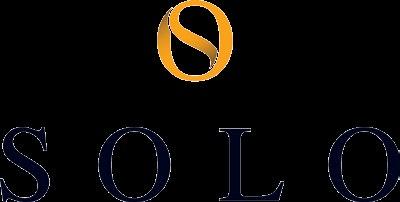
TBILISI SOLO LOUNGE Chavchavadze 29, Chavchavadze Ave.
TBILISI SOLO LOUNGE KAZBEGI 24G Kazbegi Ave.
TBILISI SOLO LOUNGE KAZBEGI 25, Kazbegi Ave.
KUTAISI SOLO LOUNGE KUTAISI 5, Q. Tamar Str.
BATUMI SOLO LOUNGE Batumi 22, Rustaveli Ave.
TBILISI SOLO LOUNGE TSERETELI 73 Tsereteli Ave.
TBILISI SOLO LOUNGE GLDANI 8, Nozadze Str.
TELAVI SOLO LOUNGE Telavi 3, Cholokashvili Str.

www.solo.ge ტელ.: +995 32 2 44 44 00


BERLIN

SALOME DADUNASHVILI
It often rains in Berlin – a monotone, professional rain. In the winter, it gets dark early and if the North Wind is blowing, you might see a vision of the ice queen mounted on a sleigh.
So what?!
Berlin is the city where even the first breath of its free air gives you conscious arrhythmia and you feel that anything could happen. Everything is possible.

It is a strange city, so real and so unreal. You’re walking in what seems to be a post-Soviet, faceless district on a gray spring day. It is a good district, comfortable – trams arrive on time, children play in parks, and passers-by go about their business. Mothers walk their babies in strollers…
You’re walking in a street wet from the raindrops dispersed in the air, passing the bakery, then a BDSM clothing store, then a bank. At the end, you come across a respectable, spotless clean house where average, Euro-standard Germans live. You stop by the post boxes in the yard, full of ads, say hello to the sex worker who always comes to work on time, and mount the stairs that lead to your apartment. The bordello rents its “office” on the first floor. It’s always quiet here, day and night –nobody bothers anyone. Everything is orderly.
Sometimes they say that the camera loves the person. Well, the camera really loves Berlin. This city that was torn apart multiple times, with its rainy autumns, endless winters, late springs and colorful summers, is the biggest muse for film directors. It’s a bit disheveled, but there’s nothing like it.
It is a victim of the longest and cruelest urban experiment in history. Tortured like Dr. Mengele’s twins, it is a city split in two. It had to endure parallel lives on each side of the wall. Berlin did stand, it survived, and the cooped up freedom erupted in the streets like lava. As time passes, Europe is still unable to give birth to a more free area.
16 VOYAGER 9/2017
The glass ball on the cement axis in Alexanderplatz revolves like the Earth. This used to be a symbol of East Berlin’s superiority but it is now a symbol of Berlin’s unity.
The Berlin Film Festival, a symbol of the West, now takes place in the East, and boldly undressed stars stomp the red carpet on the Eastern ground each February.
This city spent so much time constricted by the thin corset of the wall that it will never accept anything but freedom, just like an emancipated woman who will never have her body restrained ever again.
The whole world received a small piece of the wall that pierced Berlin’s heart. The fresh air that flowed in its liberated space became available to all of Europe.
Berlin looks like a free woman. With short-cut red hair, thin lips, well-suited dancing shoes on her toned legs, and unveiled sexuality.
The noise of the tram is the city’s heartbeat. It is fearless, crossing dark parks and entering decadent spaces full of cigarette smoke, where free people wait for it.
Nocturnal Berlin vibrates with the ceaseless rhythms of its clubs. Cement walls reflect the rustle of new music. Hundreds of bodies rhythmically sway in the twinkling lights. Everything here is as it was yet everything’s different.
Berlin is changing. The 1990s wild feeling of omnipotence and ownership of the key that opens any door is slowing down. East looks like the West, West like the East, and both of them like Berlin.
Checkpoint Charley seems like a good selfie chance for many. But on a rainy day, when you walk by a bakery and the leather shorts of a BDSM store, everything seems like it used to be in those crazy days of freedom.
Most importantly, love is still here. Every day, when you leave the house, you will see a red rose stuck to the bordello’s door. Yes, and the inscription: “Sophie, I love you”.
MITTE
City Center and the Main Museums
Mitte is the historic center of the city, where the first settlements appeared in the 13th century on the territory of Nikolaiviertel and Museum Island. Right next to it are Berlin sights dating back to the Royal epoch and the Kaiser period.
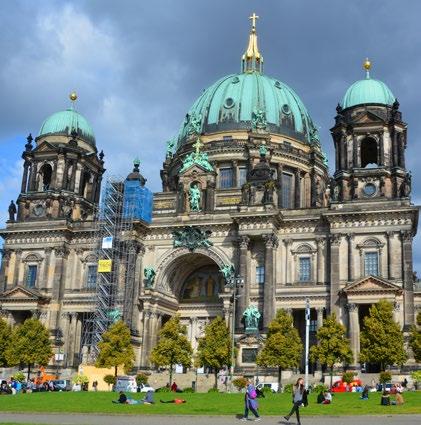



TIERGARTEN Quiet
Public Gardens and Modern Architecture
This district is now part of Mitte and is named after the large forest park, stretching from Zoo station to the Brandenburger Tor. This green area is crossed by Straße des 17. Juni, and borders the Spree River in the north.
It comes as no surprise that during the post-war division of the city, the Soviet Union took this rich part of the city for itself. As a memory of the GDR, Mitte has retained Alexanderplatz and the TV tower.
Here you will also find Haus der Kulturen der Welt, the Reichstag building, the Bundestag, the Schloss Bellevue Konrad Adenauer Foundation, the Bauhaus archive, Gemaldegalerie, Philharmonie and the new Potsdamer Platz – an enormous complex of shops, hotels and cinemas. Today, as in the pre-war period, Tiergarten is a district of embassies.
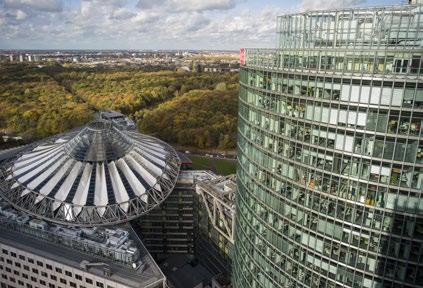
17 VOYAGER 9/2017
DISTRICTS / BERLIN
CHARLOTTENBURG
Intelligent Urban Planning and High-quality Shopping

The exemplarily looked-after Charlottenburg is a worthy example of stability in an ever-changing Berlin.

WILMERSDORF, GRUNEWALD
Rich Precincts and Forest Surrounded by Lakes
This district is located in the south of Ku'damm street and is characterized by tourist and shopping activities. This large settlement is crisscrossed by wide highways. This is why it sometimes
Bismarck turned the three kilometer Ku'damm street into the German Champs-Elysees in 1881 and the dwelling place of the liberal bourgeoisie became the center of luxury.

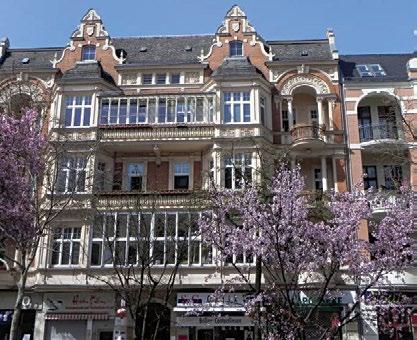
leaves the impression of a suburb. Wilmersdorf was restored after WWII. It's truly a quiet, simple settlement. There are several well-preserved architectural sights here. To the southwest there is a forest and lake district – Grunewald – a settlement of very wealthy people who live in lavish villas hidden behind trees.
It was used as a fake showcase for communist well-being. Some streets are restored, but only the facades. Once a very fashionable district, it is losing its charm, first of all due to an influx of Bobos, people leading a bohemian lifestyle, and secondly the gradual disappearance of the nostalgic atmosphere.
This atmosphere was so evident only 20 years ago that the district fell victim to gentrification; the old residents have sold their houses and moved elsewhere.
SCHÖNEBERG, FRIEDENAU
Residential Area, Literary Space
Schöneberg was located in the American zone, now borders Wilmersdorf and Tiergarten, and is home to the "middle level" Berlin bohemians, who despise almost everything to the east, including Prenzlauer Berg. Schöneberg is an excellent area to live, with lots of interesting places that you can visit.
PRENZLAUER BERG


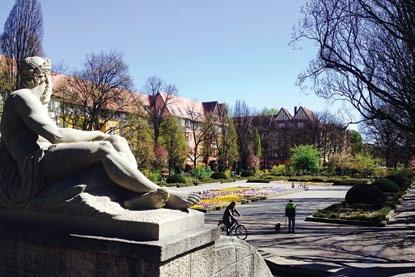
The Fortress of Gentrification and the Bobos (Bourgeois + Bohemian)
Restored from ruins following WWII, and turned into the British zone in the aftermath of the war, Charlottenburg, like no other, can tell you of Berlin's past.

Prenzlauer Berg used to be in the Soviet zone, but has a past associated with less industrialized working class. It was built at the beginning of the 20th century, so the streets and sidewalks are wider than in other districts of Berlin. Prenzlauer Berg was favored by Honecker for his propaganda speeches.
There are almost no chain stores here, but there are lots of vintage and organic product shops here. You will enjoy the many parks, wide, three-lane streets and the architecture.
Friedenau was traditionally favored by writers and its old hotel became a literary haven.

18 VOYAGER 9/2017
Friedenau has a pleasurably provincial look and a small cemetery with the graves of many famous people; you can find those of Berthold Brecht, Marlene Dietrich and Helmut Newton.

FRIEDRICHSHAIN

Modern and Bohemian
Administratively, Friedrichshain and Kreuzberg comprise one district, though they are divided by the Spree River and connect to each other by means of three bridges. Friedrichshain,



in the old East Berlin, still retains parts of the wall; these places are quite sparsely inhabited. There is a large park - Volkspark - in this district, crossed in the middle by Karl-Marx-Allee. It is slowly being flooded by Bobos from the neighboring Prenzlauer Berg, so it is ironically being called "Prenz'l without the kids". There are less buildings here and the liveliest area is by East Side Gallery on the banks of the Spree River- there are traces of the wall here.
NEUKÖLLN
Multiethnic and Scantily Elegant
This is one of the largest districts with the highest population density. Half of the inhabitants are immigrants, mostly Turks, which is why it is also called little Istanbul. This independent area is an exceptional example of the attraction and “benefits” of multiethnicity - the 48 Stunden Neukölln Festival is one of the city's greatest cultural events. Nekölln has several architectural attractions, including the World Heritage site, the prewar Hufeisensiedlung and Gropiusstadt – a work created by Walter Gropius in the 1960s, a true city within the city. An alternative lifestyle roars in the north, in the vicinity of Reuterstraße. Neukölln is considered the most exciting new neighborhood of Berlin.
KREUZBERG

Alternate and Creative
Kreuzberg was in the American zone and was called Hallesches Tor. Following the end of the Cold war, Kreuzberg became a multiethnic area of low-income people, where the first generation of Turkish emigrants settled. The district is torn between the legacy of political radicalism and the popularity of club hotspots. It is one of the most densely populated areas in Berlin. Kreuzberg is associated with doner kebabs, noisy
bars and cheap apartments, but in reality this describes only a small portion of the district. Its title of "student paradise" has long been overtaken by Neukölln in the south, and the night-long dancing takes place across the bridge in Oberbaumbrücke - abandoned factories of the Friedrichshain district.
MOABIT, WEDDING
Administrative Node and Social Diversity
The Moabit district is an island, connected to Charlottenburg, Tiergarten and Mitte through Spree, bordering Wedding. In 1716 French Huguenots came to live here. Before the war, it was the center of German communism, and after 1945, it came into possession of the French, because the famous Paris-Moscow railway went through here.
The historic Hamburger Bahnhof was transformed into one of Germany's largest contemporary art museums. The Berlin central railway station Hauptbahnhof is located here as well.
The local bright-eyed youth will tell you that this is no longer the place it used to be, that everything has turned for the worse, and to see real life, you need to go to Wedding, which the Berlin bohemians are trying adopt.
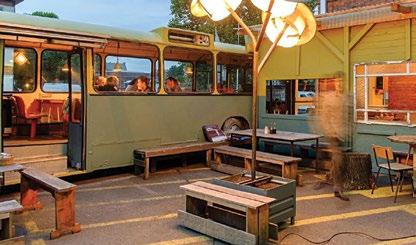
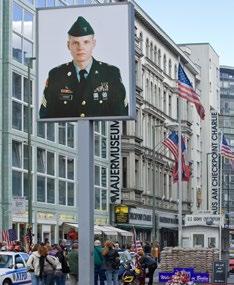
19 VOYAGER 9/2017
DISTRICTS / BERLIN
THERE ARE NO MUST-SEE PLACES IN BERLIN. MORE PRECISELY, THE MAIN SIGHT IS BERLIN ITSELF: THE SUBWAY CARS FULL OF YOUNG PEOPLE COMING OUT OF CLUBS AT 4 A.M.; THE HOT DOG STANDS WHERE CLERKS IN SUITS AND PUNKS STAND IN THE SAME LINE; THE PUBLIC GARDENS IN UNINHABITED AREAS ALONG THE DIVIDING LINE; SUNDAY FLEA MARKETS IN PRENZLAUER-BERG. BUT ONE HAS TO START SOMEWHERE. HERE ARE SOME SUGGESTIONS.
BRANDENBURGER TOR A Symbol of Unification of Germany
The Brandenburg Gate is the most symbolic monument of the city. The triumphal ark, topped by the goddess of victory, Victoria, was built in 1791 to replace a simple city gate. After the defeat of Prussia in the battle of Jena, Napoleon took the sculpture with him as a trophy, but the Prussians retrieved it in 1806. The square in front of the gate was named Pariserplatz, and General Pful, who returned the quadriga to its homeland, was granted the right to enter the city though the arch. Prior to that only members of the royal family had that right.
REICHSTAG

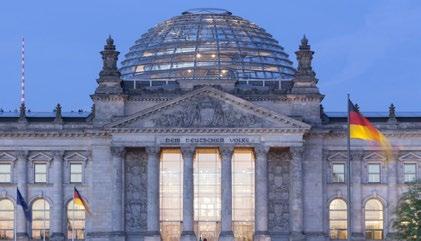
Long-Suffering Bastion of German Democracy
SIEGESSÄULE
The Victory Column
To celebrate Prussia’s victory over Denmark, Austria and France, a famous bronze statue of Victoria, also known as Goldese, was mounted on top of a column by Johann Heinrich Strack. It was featured by Wim Wenders in his film as the angels’ gathering place. The column was moved to Straße des 17. Juni in 1939.

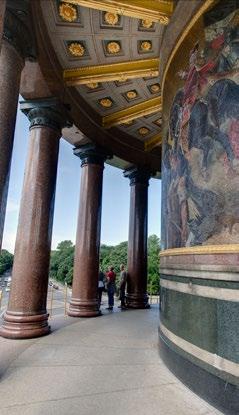

Straße des 17. Juni, Tiergarten
In a divided Berlin, the Brandenburg Gate was captured between the two walls of the division line. The inhabitants of Berlin had such a nostalgia for it that on November 9, 1989, many thousands of people gathered to celebrate here.

The gate has a secret, unknown even to many Berliners – on the side of the arch there is a so-called "Room of Silence", a small space with up to ten chairs where one can contemplate one’s thoughts or just escape the crowds of tourists.
In 1894, an ostentatious building was built for the German Kaiser’s parliament based on a project by Paul Wallot. The whole city was surprised by the new glass dome and the idea of a constitutional monarchy. In 1933, a fire broke out in the building; the communists blamed for starting it were expelled from the Reichstag and the Nazis gained a parliamentary majority. Many historians believe that the building was burned by the supporters of the Führer themselves. In 1945, the attacks of the Red Arm razed an already maimed building to the ground but it had been already
abandoned by then. After the war, it was intended to get destroyed completely, but the thought was revisited.
The Reichstag made a triumphant comeback in 1990 when an official ceremony for Germany’s reunification was held there. Its restoration was undertaken by the British architect Norman Foster who helmed the building with a brilliant new glass and steel dome. Visitors will experience an impressive view when first accessing the ramp and then climbing on to the roof. Tours are only held on days when the Bundestag deputies are on holiday. Entry is free but must be booked in advance.
The dome is open every day – 08.0000.00
Platz der Republik 1
20 VOYAGER 9/2017
Pariser Platz
NIKOLAIKIRCHE
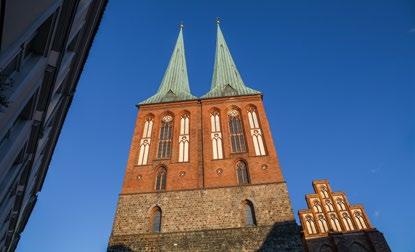
The Oldest Temple
Built in 1220-1230, this temple is the oldest in Berlin. Nikolaikirche was severely damaged during the war bombings in the twentieth century and was rebuilt in the 1980s. The splendid colors of the lines on the arched ceiling are inspired by medieval patterns.
Nikolaikirchplatz, Mitte
OBERBAUMBRÜCKE
Oberbaumbrücke – a bridge between Kreuzberg and Friedrichshain

EAST SIDE GALLERY

A piece of the Berlin Wall became a street art gallery

This is what is left of the wall - a 1.3 km long open-air gallery. The exhibition space comprises 101 political and satirical wall paintings and 118 authors from 21 countries around the world. In the spring of 1990, the Berlin Wall was painted and the remains of this gloom construction became the manifestation of the city’s newly found freedom. Much has been erased, though Dmitri Vrubel’s "Brezhnev kisses Honecker" is still in place.
Mühlenstraße, Friedrichshain
SAMMLUNG BOROS
Boros Collection -

Installations in a Nazi bunker
One true Berlin eccentricity is this bunker that was built in 1943 for 3,000 people and at various times after the war housed an exotic fruit warehouse and a techno club. The bunker was bought by German media magnate Christian Boros in the 2000s. He set up his living quarters in a glass penthouse constructed on the roof of the building, and turned the lower floors into an exhibition space for his modern art collection. Book your tickets online. Admission price: 12€ Reinhardtstraße 20
HOLOCAUST-MAHNMAL
The Holocaust Memorial, designed by the American architect Peter Eisenmann, consists of 2,711 stone tiles of different heights and sizes that create an openair labyrinth. The harrowing exposition of the underground information center tells the story of the Holocaust. There are no inscriptions on the tiles.
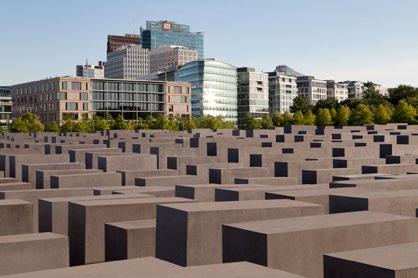
Cora-Berliner-Straße 1
This is Berlin's most fascinating square, and it also hosts a theater designed by Schinkel, currently known as Konzerthaus. On each side of the building there is a German and French temple

For club life fans, this is a bridge between Watergate and Berghain. At night and during holidays people drink and party on this bridge. Before Berlin was reunited, the Oberbaumbrücke was a border point and was formerly a customs gate. In order to scare smugglers, a wooden log pierced with arrows was left to float in the river (Oberbaum means "an upper log"). The current bridge with its post-neogothic brick towers and battlements was built in the 19th century.
From here, one can view the port warehouses, factory buildings and the "Molecular Men". The "molecular human " is a gigantic trio made of punctured aluminum set up in the middle of the Spree by sculptor Jonathan Borofsky. The Spree River is 400 km long and flows through Berlin. A floating swimming pool is attached to the banks of the river.

(Deutscher Dom and the Französischer Dom). In the summer, open-air classical music concerts are held here, and in the winter it hosts a Christmas market.
Gendarmenmarkt, Mitte
21 VOYAGER 9/2017
GENDARMENMARKT
CHRISTMAS MARKET SQUARE
SIGHTSEEINGS / BERLIN
Memorial of the Holocaust Victims
UNTER DEN LINDEN

Boulevard of Linden
Once this was the road the rulers took to hunt in the Tiergarten. In the middle of the 17th century, when the city grew towards the south, Friedrich Wilhelm ordered a lane of linden trees and a boulevard to be built for romantic walks.

At present, it is an absolutely nonromantic street with banks and hotels located along it but you should walk down it at least once to honor the history.

TIERGARTEN
The Main Park of the City
Berliners are very lucky to live in a city with a huge park at its center. The former hunting grounds of the Kurfursten (Tiergarten means "garden of wild beasts") was opened to the public in the 18th century.
BERLINER DOM
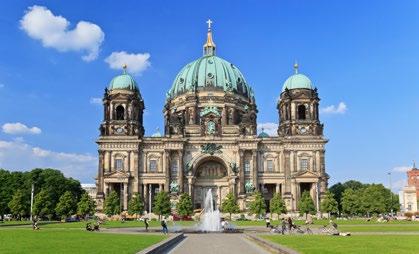
The Main Protestant Cathedral
Do not confuse it with the German Temple (Deuscher Dom), which is located in Gendarmenmarkt. The temple was designed by Julius Carl Raschdorff and was constructed in 1894-1905. Am Lustgarten, Mitte
KAISER-WILHELMGEDÄCHTNISKIRCHE
The Photogenic Ruins
HELMUT NEWTON FOUNDATION



Museum of Photography Genius
A large part of Helmut Newton’s (19202004) life was spent in London, Paris and New York in the company of beautiful nude women.
The park is not characterized by any special botanical peculiarities. Some of the corners are reminiscent of untouched groves, even though most of the trees were cut down for heating during the war. But there is a wonderful 30-kilometer long trail here featuring small rivers and ponds. In the section nearest to the Reichstag, one can find a statue of a Soviet soldier and the Palace of the Republic.
This church, built in honor of the first emperor of Germany, was turned to ruin by British aviation during the war. After the war, the decision was taken to take the building apart and build a new cathedral in its place the Berliners protested. A compromise was found: after the preservation of the remains of the old temple, a new church and bell tower were built nearby in a modern design. The Berliners called them jokingly the "powder case" and "lipstick". The walls of the new building are made of layered blue glass and it is lit up from inside in the evening. The "powder case" contains the well-known "Stalingrad Madonna" - a sad face drawn by a German military doctor, Reuber, on a piece of map while he was in a trench near Stalingrad.
Open: every day - 09.00-19.00; Admission is free.
Breitscheidplatz

His fetishistic works are considered to be part of a golden archive of 20th century photography. However, Newton financed his personal museum himself, which was later given as a gift to Berlin, the city which he and his Jewish parents had to leave in 1938 following the attacks of the "Crystal Night". The building, which used to be an officers’ club, currently hosts his personal belongings, letters, cameras and library. There is a reconstruction of his working cabinet here as well.
Open: every day at 11.00-17.00.
Admission price: 10 €
Jebensstraße 2
COMMENT:
„Danke“, „Bitte“: Two short but very important German words. "Danke" means "thanks". If you add "Vielen" (very big), your thanks will become more official, as in the case of "Danke sehr" - it would be nice to use the latter when leaving a store or restaurant. The most polite way to say thanks is "Danke gern" (my deepest appreciation), which is also used frequently. As for the word "bitte", it means "please" and for a more polite form "sehr" or "schön" is added. This word combination is used to answer "Danke sehr" or "Danke schön" and means "you’re welcome".
22 VOYAGER 9/2017
SIGHTSEEINGS / BERLIN


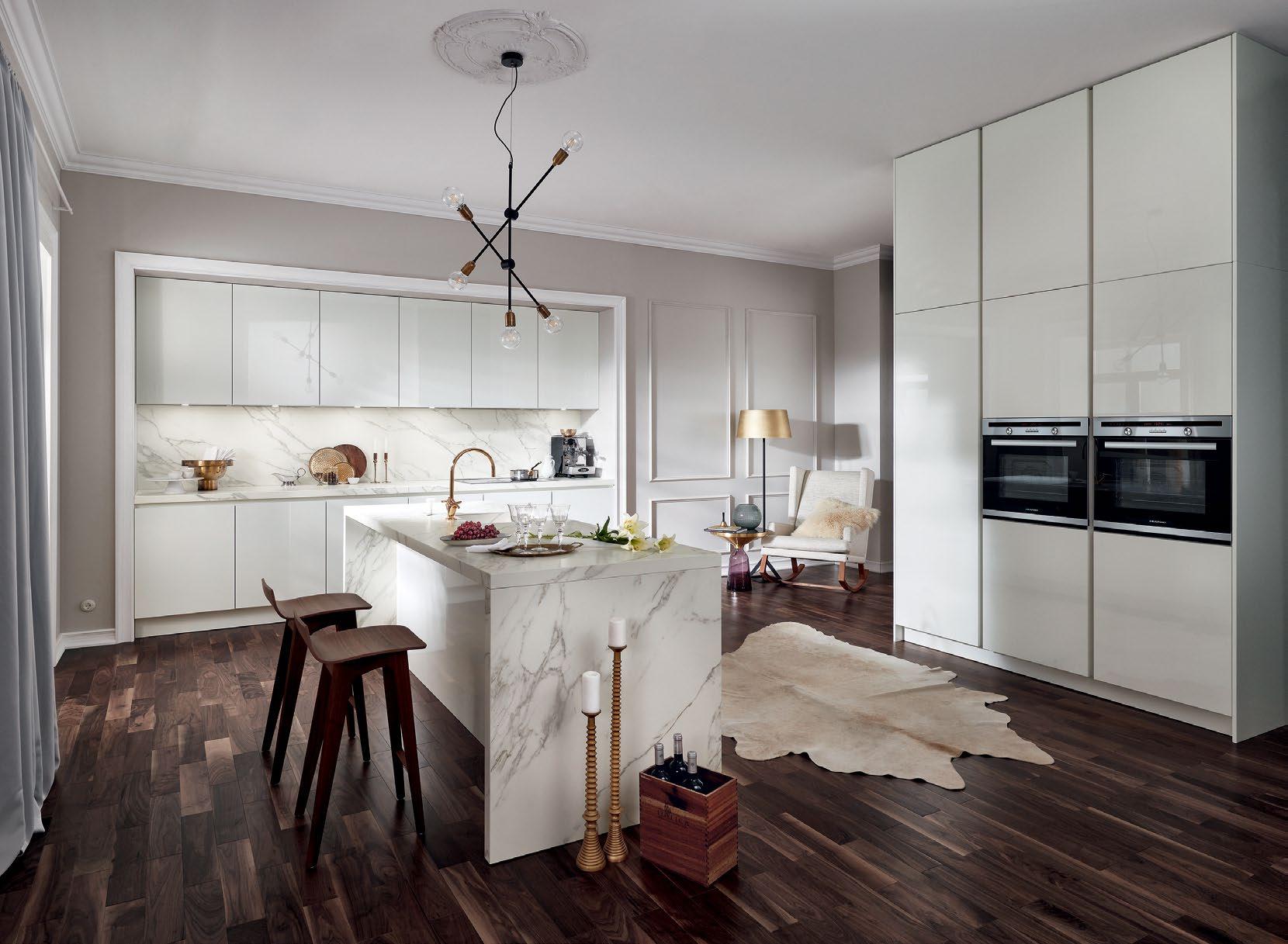
POTSDAMER PLATZ

A Glass Babylon
Travelers who come here are trying to find the true center of Berlin, but what they find is wi-fi and coffee chains under the glass roof of the Sony center. They are too late – in the 1920s Potsdamer Platz and its neighbor Leipziger Platz were indeed the main places where the city’s heart used to beat but the war and the wall changed everything there.
BERLINER PHILHARMONIKER
Home of One of the World’s Best Orchestras
In 1963, the building designed by architect Hans Scharoun created true furor. “Clothed” in gilded aluminum, this postmodern circus tent houses an avant-garde concert hall, with a stage placed in the middle.
FERNSEHTURM
Germany's Tallest Building
In 1993, Sony and Daimler-Benz started the biggest construction of the century. Potsdamer Platz and its surroundings became a quarter of ultra-modern skyscrapers. To view it in full, you should visit the Kolhoff brick tower observation deck.
During the "Berlinale" days, it is especially crowded here since the main film screenings take place in the Theater am Potsdamer Platz. potsdamerplatz.de
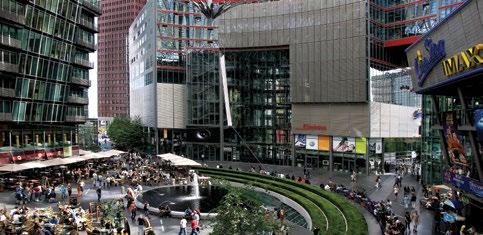
Society could not come to terms with the fact that the great Berlin Philharmonic Orchestra was to play in this "abrakadabra" but the acoustics of the building won the skeptics over. When a similar chamber music hall (Kammermusiksaal) was built by its side, nobody expressed any dissatisfaction.

This mecca of classical music is visited by music lovers from all over the world, so you should buy your tickets in advance, though one can listen to the orchestra even without a ticket: "lunchtime concerts" are held in the foyer on Mondays; they continue for less than an hour and you can walk in directly from the street to attend them.
Herbert-von-Karajan-Straße 1
prey of hungry humans. However, the area, including the historical pavilions, was quickly restored. This is a wide open green space, and the approach to the animals is extremely humane. The zoo is rightfully regarded as one of the best sights in Berlin. Giraffes, elephants, small hippos, lemurs and numerous exotic animals await you.
This stunning monument with a sphere and column is a TV tower and is a recognizable trait of Berlin, as much as the Eiffel Tower is of Paris. Ferseturm is 368m high and is the tallest building both in the city and in the country. It was built in 1969 on the 20th anniversary of the GDR’s establishment to seek approval from the country’s Western neighbors. The sphere attached to its tip indicated the success of Soviet space satellites. There is an observation deck in the sphere, from which one can see for tens of kilometers around. There is also a revolving restaurant here, which makes a full turn in an hour. Open: every day - 10.00-00.00
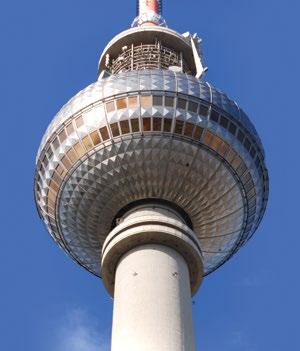
Admission price: 13€ Panoramastraße 1A
ZOO The Oldest Zoo
The zoo garden near Tiergarten was opened in 1844 when a royal concord received a group of naturalists, including Alexander von Humboldt. The zoo was in a dire state during WWII: fewer than 100 residents survived out of 4,000 - many animals escaped, died or became the


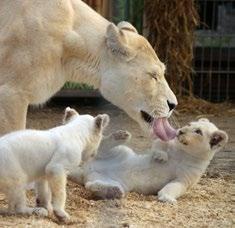

Open: everyday _ January-February, November-December - 09.00-16.30; March, October - 09.00-18.00; April-September - 09.00-18.30
Admission price: 14.50 €, including visit to the aquarium - 20 € Hardenbergplatz 8
24 VOYAGER 9/2017
SIGHTSEEINGS / BERLIN

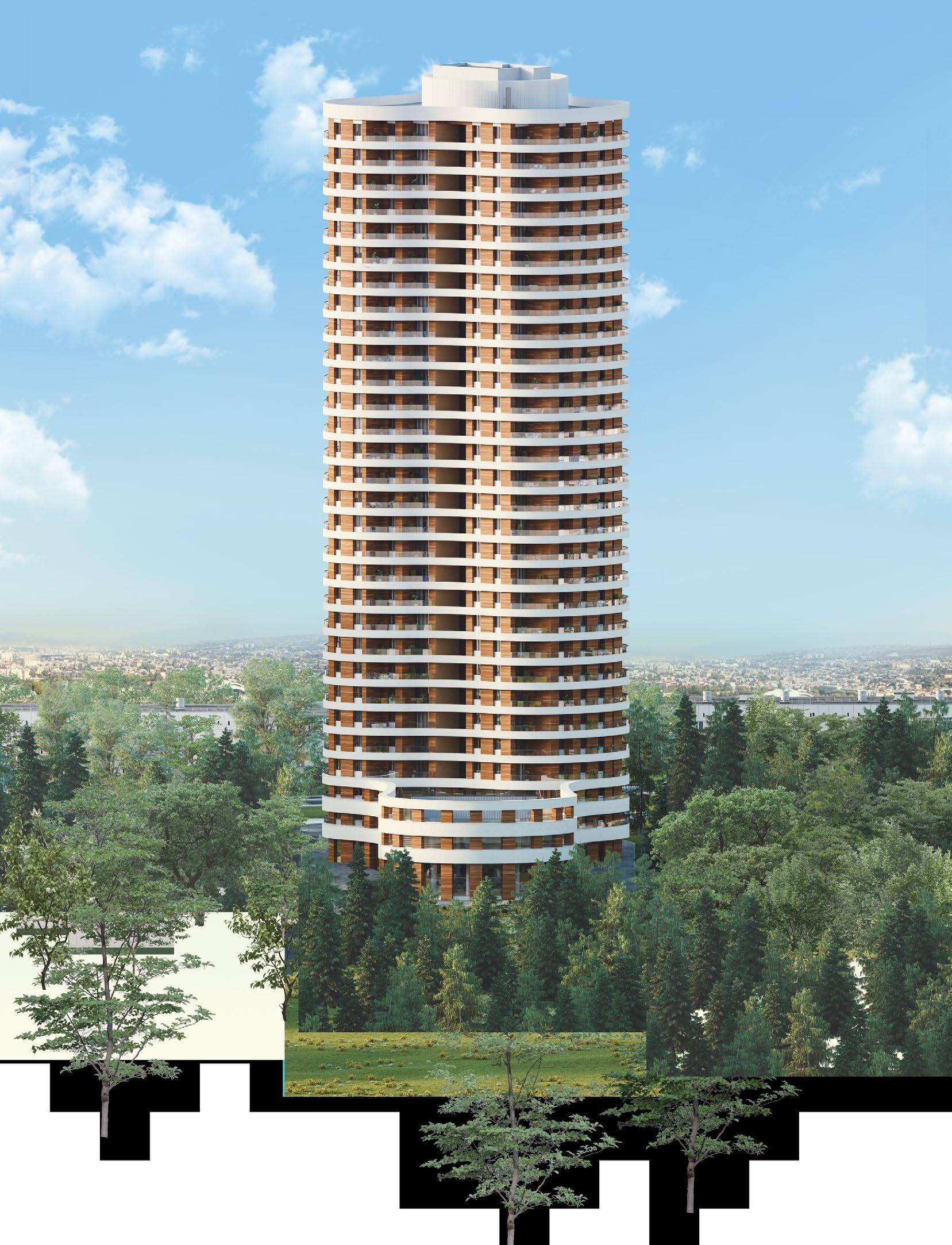

IMAGINE 2950 ₾ From LANDSCAPING EVENT HALL KINDERGARTEN SECURE AREA Open park with secure access points. LOBBY An ideal place for business meetings with a dedicated concierge service. A colorful environment and caring teachers for the tiniest residents of Tbilisi Gardens. Perfect place for noisy parties and huge events. 21 000 m2 of green area to relax. All day gym with experienced trainers. Olympic-size and kids swimming pools. FITNESS CENTRE POOL IN THE CENTER OF THE CITY All in one place First New York Skyscraper in Tbilisi
THE MUSEUM ISLAND
The structure of the Museum Island is one of the best and most convenient structures of any museum district, according to experts. This structure unites five museums: Old Museum, New Museum, Pergamon Museum, Bode Museum and Old National Gallery.

The "Treasure Island" located on the Spree river holds one of the most important art collections in the world. The history of the island is an excellent example of what a collaboration between a scientist and an ambitious ruler can achieve. Nobody knows what would have happened if one ambitious archeologist - Aloys Hirt – had not dared to propose an idea of creating a museum to King Frederick William II in 1797. The project began in 1810 and educated German society received a chance to visit and look at the carefully selected art pieces.
A great reconstruction was initiated on the island in 1822; the construction of bridges, channels, and most of a museum based on Karl Friedrich Schinkel's project began. The public commission was helmed by no other than Wilhelm von Humboldt himself.
The first construction – the Old Museum (Altes Museum) –was opened in 1830, followed by the current New Museum (Neues Museum) in 1859. The Old National Gallery (Alte Nationalgalerie) was added to the island in 1876 and in 1904 they were joined by the Bode Museum. The phenomenon that is the Museum Island was adorned with the Pergamon museum in 1930, which established Berlin’s place among the other capitals of enlightened Europe. During World War II, the Museum Island was heavily damaged and its final reconstruction could only be completed after the reunification of Germany. The collections that were divided during the division of Berlin were reunited as well and were redistributed to various locations. On Museum Island, one will mainly find archaeological collections and pieces of 19th century art.
ALTES MUSEUM
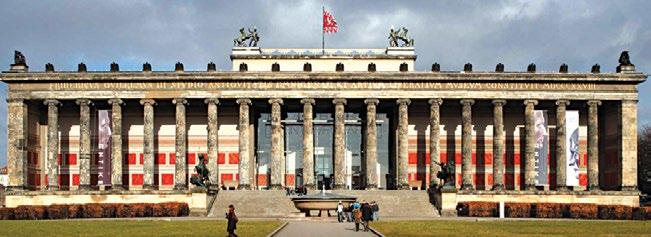
In the Old Museum, you can see antique artifacts, sculptures, gold and silver jewels, and other treasures obtained during archaeological excavations. The main floor hosts an ancient Greek collection in chronological order covering the period of 10th-9th century BC. Sculptures, jewelry, an impressive collection of reliefs – all of these were added to the new exposition in 2011. The museum's numismatic collection is particularly rich, containing 1,300 coins.
On the upper floor, there are examples of Etruscan and Roman art. It is worth noting that the Etruscan collection is one of the richest outside Italy. The real treasures of the Roman exhibit are considered to be the portraits of Julius Caesar and Cleopatra.

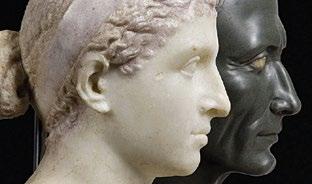
NEUES MUSEUM
The New Museum is home to two very important collections. The Egyptian and the papyrus collection clearly show the changes that the Egyptian and the Nubian culture went through on the path of their development in the span of 4 millenniums.

The true jewel of the collection is an example of the Late New Kingdom’s sculpture art, the so-called "green Berlin head" dating back to 350 BC. The famous bust of Nefertiti, which often serves as a reason why people visit Berlin, will induce Egypt lovers into full nirvana. This piece of art, dating back to the Amarna period, which became well known due to the mastery of the sculpture, as well as the Queen’s refined beauty, is an important part of the collection. The new museum displays materials obtained from archaeological excavations in Europe and Asia dating as far back as the beginning of the Stone Age period. Among them are archeological findings by Schliemann in Troy and Cyprus.

26 VOYAGER 9/2017
The Troy Gold, which was obtained by Schliemann during his archeological explorations, is only represented by copies (following WWII, the originals were taken to Moscow and as of now the Pushkin Museum has no plans to return them). In general, the New Museum came out to be unluckiest of all – it was so badly damaged during the war that it reopened only in 2009. That is why its exposition design is very modern. For instance, scenes from prehistoric times in the Stone Age artifacts halls are brought to life by means of video visualization.
Thanks to the activity of German archaeologists, Berlin holds tremendous archaeological materials found in Mesopotamia, Syria and Anatolia. An excellent example of this is the reconstruction of the Ishtar Gate and Babylon's ritual procession road dating back to the rule of Nebuchadnezzar II. No less important are the oldest documents of human written history inscribed on clay tablets. These samples of cuneiform script from Uruk are approximately 4,000 years old. The collection of Islamic art is one of the most impressive in Europe. The decorative art masterpieces and archeological materials cover the period of the 7th – 19th centuries. In this case as well, one of the most impressive elements of the collection is a reconstruction of the Mshatta Khalifa palace façade, dating back to 740 AD. The meticulous art of stone carving represented here is inimitable. The so-called "Aleppo Room", completed in 1600 AD, will stay in your memory with its richly painted, bright colored wooden panels.
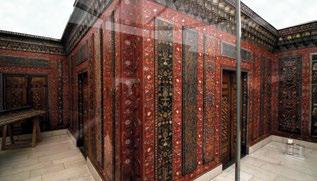

ALTE NATIONALGALERIE
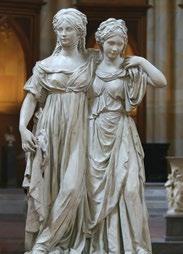
The Old National Gallery contains pieces of Romantic and Impressionistic art. A special point of the gallery's pride is one of the best collections of Adolph Menzel's works in the world. The principal part of the collection was donated by the Prussian banker Johann Heinrich Wilhelm in 1861.
PERGAMONMUSEUM
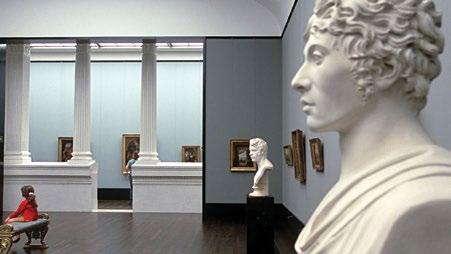
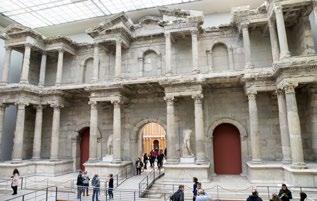

Pergamon Museum is truly one of the jewels of the Museum Island, not only due to the artefacts stored in its collection but also thanks to their sheer scale. This is an amazing opportunity to view antique architectural structures in an almost untouched state in the space of a museum. The museum collections include pieces from Greece, Asia Minor and Islamic cultures.
Thanks to the reconstruction of the Pergamon Temple, the Market Gate of Miuletus and the Ishtar Gate, viewers get the full impression of travelling in time and space. Constructed with glazed bricks and adorned with image of winged lions and gryphons, the Babylon walls leave a glorious impression on viewers. The Pergamon Temple Altar, which dates back to 180-160 BC, is a masterpiece of Hellenistic culture. The conflict between the Olympic gods and giants is even more impressive when viewed in the space of this museum due to the amazing proximity of the sculptures.
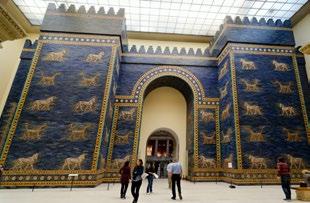
The collection of the Old National Gallery is considered historic, so no newly purchased art pieces are added to the collection. The exception to this rule was another piece by Menzel, "The Petition", which was a very special addition to an already distinctive collection. The gallery's exposition starts with the paintings of the Goethe period and frescoes of the "Nazarenes". The "Nazarene Movement" was formed in Vienna in 1809. Their purpose was to revive the spirituality of Christian art. The movement became popular and German romanticists moved to Rome. In the gallery, you can view the frescoes created by them for the Casa Bartholdy in Rome.

Other important pieces of the collection are: One of the versions of Arnold Bocklin's famous "Island of the Dead", works by Paul Cezanne, Gustave Courbet, and representatives of the Barbizon school.

27 VOYAGER 9/2017 MUSEUMS / BERLIN
Neues Museum
ALTE NATIONALGALERIE
Impressionists and German paintings of the 19th century.
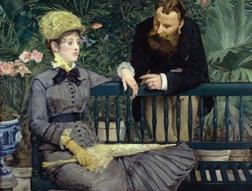

This building, constructed in the style of an ancient Greek temple in 1861, was designated for modern art - the German painting of that time. Interestingly, the Old National Gallery was the first to buy pieces of Impressionist art. The first Claude Monet painting acquired in 1896 was soon joined by numerous paintings of other like-minded artists. At the end of the 19th century, there was a big scandal in the gallery: the director was let go because he purchased the “Tahitian Women” by Paul Gauguin for the museum, and the Kaiser considered this painting to be immodest. Nowadays, many visit the museum to view the works of the Impressionists (Cezanne, Manet, Degas, Renoir).
NEUE NATIONALGALERIE
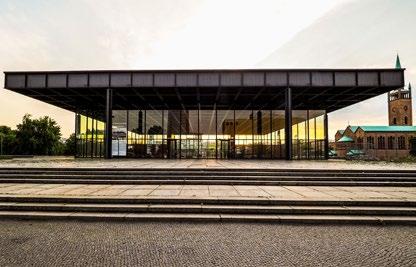
Cult building of modernist architecture
The building, currently closed for reconstruction, is the last work of such scale by the architect Ludwig Mies van der Rohe. After the construction of Potsdamer Platz, the building merged into a new environment and became another symbol of united Berlin.
Neue Nationalgalerie is a piece of contemporary art itself. The gallery’s collection covers 20th century art and is now displayed in several museums: Alte Nationalgalerie, Friedrichswerdersche Kirche, Museum Berggruen, Sammlung Scharf-Gerstenberg and Hamburger Bahnhof - Museum für Gegenwart.
HAMBURGER BAHNHOF — MUSEUM FÜR GEGENWART


New art in an old building
Among Berlin’s railway stations, the most respectable and best preserved is the Hamburg Station (1846) which did not “host” trains for very long. It soon became an exhibition space; in the early 20th century, it was first transformed into a transport museum, and in the 1990s turned into the art gallery of the newest art – that created after 1960. The permanent collection includes works of such notable artists as Andy Warhol, Robert Rauschenberg, Anselm Kiefer, Cy Twombly, and etc. An entire wing of the museum is dedicated to installations, drawings and recordings of performances by Joseph Beuys.
Open: every day - 10.00 am -06.00 pm
Admission price: 14€
Invalidenstraße 50-51
GEMÄLDEGALERIE
The best collection of old art
The painting masterpieces of the 13th – 18th centuries are displayed together here. Here you can see Kranach, Durer, Holbein. Only Vienna or Munich can compete with Berlin’s art gallery in this regard.

BODE-MUSEUM

European sculpture and coins from all around the world
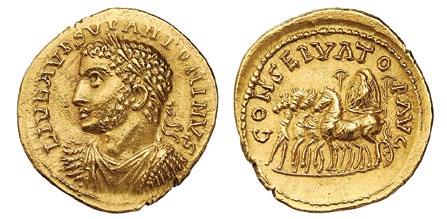
This museum, named after the famous art historian Wilhelm von Bode, preserves the sculptures of the Renaissance period (among its masterpieces are Donatello’s "Madonna Pazzi", and marble sculptures by Canova). The Byzantine Art Collection comprises works from the 3rd-15th centuries. The most
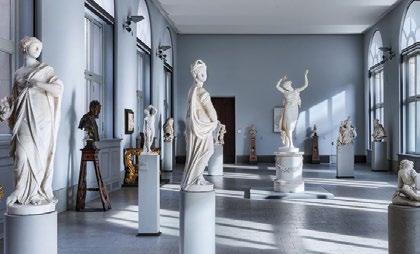
impressive items are those created for religious purposes, including miniature masterpieces made from ivory and mosaic icons. Right here are the early Christian Roman sarcophaguses. The numismatic collection includes 4,000 coins and medallions, as well as items used for money at different times, typographic prints, and medals.

Open: every day - 10.00 am - 06.00 pm.
Admission price: 10€
Am Kupfergraben
The two large sections comprise 72 halls – The Italian Renaissance from Giotto to Titian, selected paintings by Dutch and Flemish masters, including the hypnotic portrait of a girl by Petrus Cristus, the “Netherlandish Proverbs” by Bruegel the Elder, and 16 paintings by Rembrandt. There also are two works by Vermeer and Caravaggio’s “Amor Victorious”.
Open: every day 11.00 am - 06.00 pm.
Admission price: 10€
Matthäikirchplatz
28 VOYAGER 9/2017
JÜDISCHES MUSEUM
It is hard to find another country that understood the burden of its mistakes so well after being defeated in a war that they started than Germany. The best illustration of how Germany interpreted the shameful fascist years is not only its modern political stance but also the Jewish Museum, which is one of the most important sights of Berlin. The idea of creating such a museum was born in eastern Berlin but it was finally implemented after the reunification of Germany.

The museum, which was to reflect the history of the Jewish nation, show the trials of the German and, in particular, the Berlin Jews; it stirred a lot of de -

THE TIN-LINED ZIGZAGGED CONSTRUCTION, ATTACHED TO A 18TH CENTURY COURT CHAMBER, IS A PRODUCT OF THE AMERICAN DANIEL LIBESKIND’S IMAGINATION.

bate. Today, the expositions presented here reflect the history of forceful resettlements of Jewish communities on the territory of Germany from antiquity to modernity. The museum was opened in 2001 with a concert by the famous pianist and conductor Daniel Barenboim.
In a way, it is a successor of the Jewish Museum, which was located in Berlin and was destroyed by the Nazis in 1938; virtually nothing survived from that collection.
The museum building consists of several sections. The main collection is located in a building constructed by the American architect Daniel Libeskind. His parents, both Polish Jews, were Holocaust survivors.


The walls themselves add emphasis and acuity to this exposition, reflecting hundreds of years of the Jewish community’s life in Germany.
The overall structure of the museum symbolizes the peculiarities of Jewish-German relations: dashed lines, open cuts, empty spaces. The culmination is a claustrophobic tower of the Holocaust – a cold concrete "sack" where a only a few visitors can bear to spend more than two minutes.

Open: Monday - 10.00 am -10.00 pm, Tuesday - Sunday - 10.00 am -08.00 pm.

Admission price: 8€
Lindenstraße 9-14
29 VOYAGER 9/2017 MUSEUMS / BERLIN
The most avant-garde museum building
ADLON KEMPINSKI
This hotel, distinguished by its style and elegance, is located at the heart of Berlin near its calling card - the Brandenburg Gate. It has been welcoming guests since 1907.


The hotel is distinguished by its hospitality and good service.
The three restaurants located in the hotel can satisfy even the most fickle of guests, including the two-Michelin-star Lorenz AdlonEsszimmer, and a stylish Japanese-Thai Sra Bua, led by Tim Raue.
DAS STUE
Das Stue, which housed the Danish Embassy in the 1930s, has retained its past grand look thanks to the Spanish designer Patricia Urquiola. Today there are numerous reasons to stay in this hotel – its dazzlingly white spa, rooms with a door onto Tiergarten, its three-story reading hall or the local concept Michelin-star restaurant with a menu created by Catalan chef Paco Pérez.
All the sights of Berlin are within minutes of the hotel, and the rooms are equipped with binoculars so you can explore the inhabitants of
the famous zoo from the comfort of your room. The drinks list of the hotel bar includes rare and unusual whiskey and cognac

SIR SAVIGNY HOTEL
Unforgettable views can be seen perfectly from each room of this hotel. The rooms are equipped according to the latest demands of the modern urban environment, starting with handmade furniture and ending with a reading table and wall-mounted lamps. Resting
Adlon Spa is truly an earthly paradise for those who want to relax and get healthy.



Standard room price: starting at 240 €
Unter den Linden 77
in this truly royally wide bed is a genuine pleasure. Modern and very aristocratic at the same time, this hotel is inimitable in its refinement; the hotel’s chef is also very distinguished; his meat dishes are made from ingredients delivered directly from Aberdeen. Room price: starting at 200 €
K antstrasse 144, Charlottenburg
THE DUDE
Such a genuine combination of minimal space and luxury is quite rare! There are 27 rooms in the hotel but it is always full. The building is a typical 19th century urban structure and fully reflects Berlin’s light humor.
All of the rooms have a distinctive retro style – metal beds or old style washing-stands and bathrooms. Thanks to the daily home cooking, there is no strictly defined time for breakfast. As for lunch or dinner, the
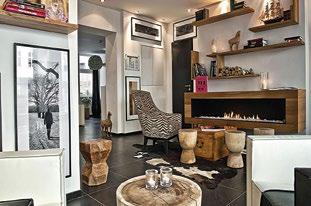
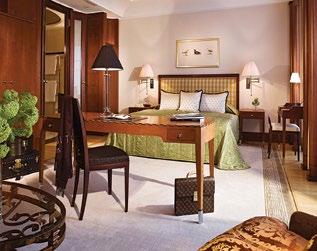
brands that you will not find anywhere else in the German capital.
Standard room price: 230 € Drakestraße1,Tiergarten
Brooklyn Beef Club operating on the first floor will offer you delicious steaks with whiskey or rare wines. If you go for whiskey, there are 180 varieties of this drink here.
Standard room price: starting at 230 €
KöpenickerStrasse 92, Mitte
30 VOYAGER 9/2017
THE 25HOURS HOTEL BIKINI
This hotel stands out due to the diversity characteristic of the German capital itself. The 25hours Hotel Bikini is located in the western part of Berlin and is buzzing with life like a beehive day or night.


In this cosmopolitan space created by designer Werner Aislinger, everything is built upon contrasts between nature and culture.
Thanks to its excellent restaurant, bar, open terrace and unforgettable views across Berlin, this place is not only popular for lodging but is also considered the best place for business meetings.
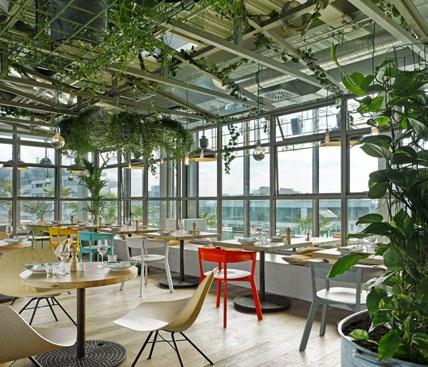
The so-called Haya Molcho conceptual approach enables you to taste a little bit of everything and a wide variety of dishes from different cuisines that naturally find a spot on the same table.
MONKEY BAR
It is a true pleasure to sit on the open terrace of The Top Floor Monkey Bar.
SOHO HOUSE
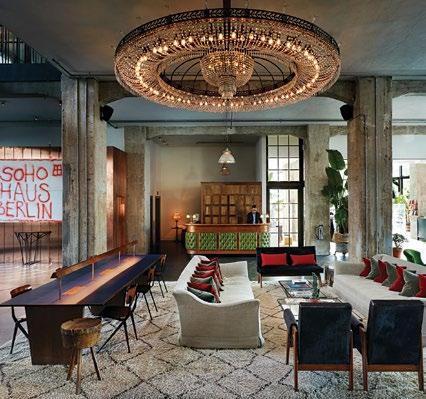
The hotel has 65 rooms of various sizes and styles and 20 exceptional apartments. The top floor hosts an outdoor swimming pool, a beautiful bar, a restaurant and a dance floor.
This building, decorated in 1920s style and overlooking one of Berlin's busiest
NENI RESTAURANT
NENI is a culinary mosaic that combines influences from Persian, Arabic, Jewish, Turkish, Spanish, German and Austrian cuisine.
intersections, was turned into the city’s distinctly luxurious hotel in 2010. It has a notable history: originally a trade center owned by a Jewish family and taken away by the Nazis, it was later overtaken by Communists. Today it’s the most fashionable area of the Mitte district, placed in a masterfully combined atmosphere of the old and the modern.
In the close vicinity, you will find Berlin’s best concept store, a small cinema and a reading hall equipped with a bar and the famous Cowshed Spa known all around Berlin.
Soho Berlin is the first and largest project of its management group outside of the United Kingdom.

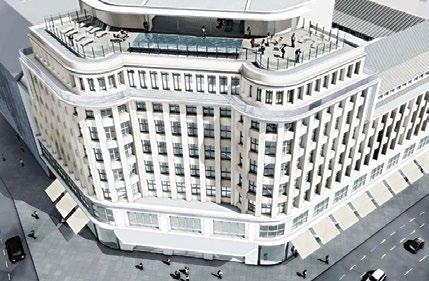
Here guests are offered a wide choice of spirits and the best wines from different countries. The local DJ and diverse program of live music is known all over Berlin. You should make reservations in advance.

WOODFIRE BAKERY
The whole building is soaked in the aroma of freshly baked bread and buns. The bakery also sells fluffy buns, hand churned butter, cheese made of pure milk, and homemade jams. Standard room price: starting at 145 € budapester str. 40
The first hotel under this name was opened in 1995 in the Soho District of London; today it has 18 branches worldwide.
Room price: starting at 250 € Torstraße 1
31 VOYAGER 9/2017
HOTELS / BERLIN
SUGGESTED ROUTE
Berliner Dom (Am Lustgarten) _ The main Protestant cathedral is the very building from where you should start exploring Berlin, especially since 2017 marks the 500th anniversary of the Reformation. Before moving on to the Museum Island, you can lie down and relax on Lustgarten – the favorite meadow of the Berliners, located in front of the cathedral.
Neues Museum (Bodestraße 1-3) _ If you only have one day to get to know the city and want to select just one museum to visit, without doubt visit the "New Museum" to see the so-called "Berlin Green head" –the famous bust of Nefertiti. Make sure to go by Plato’s manuscripts as well.
After that, take a walk towards GendarmenmarktBerlin's most beautiful square. Enjoy the harmonious architectural ensemble with a concert hall at its heart, surrounded by German and French cathedrals. You may get lucky and find yourself amidst an open-air classical music evening concert.
Continue on to the Holocaust-Mahnmal: the aboveground part of the Holocaust victims memorial consists of 2,711 concrete tiles cover an area equal to three football fields. This monument is gruesomely magnificent.
In a short distance from here, you can follow Ebertstraße to find yourself in the front of Brandenburger Tor (Brandenburg Gate), the main sight of Berlin. After the fall of the Berlin Wall, this became a symbol of German unity.
TAXI FROM THE AIRPORT
Neither of the city’s two airports (Tegel, Schönefeld) is particularly far from the city center, so it's wise to take a taxi, especially if there are two or three of you travelling together. You can pay by card in all taxis. It is not obligatory to tip, but they will not refuse it if you do. The driver will most definitely come out of the car and open the trunk so that you can take your luggage.
From Tegel: 10 km, 20-30 minutes, 20-25 €
From Schönefeld: 22 km, 40-50 minutes, 35-40 €
TRAIN FROM THE AIRPORT
There is no railway line from Tegel Airport to the city center, but Schönefeld does have a railway station, from which you can travel by Airport Express to RE7 and RB14 lines, as well as S-Bahn's S9 and S45 lines.
On the Airport Express, RE7 and RB14 – The journey lasts 30 minutes, and leaves every 20 minutes from 04.40 am to 11.20 pm; Price: 3.20 €.
S-Bahn S9 (to the city center) or S45 (Südkreuz) - 45 minutes, leaves every 20 minutes, from 04.00 am to 12.30 am; Price: 3.20 €
BUS FROM THE AIRPORT

Continue on towards the Reichstag (Platz der Republik 1) – the tormented bastion of German democracy was restored by British architect Norman Foster who adorned the building with an effective, glass and steel dome. You can go up into the dome and enjoy a magnificent panorama of the city.
Zoo (Hardenbergplatz 8) – to get to the old, celebrated German zoo continue on through the Tiergarten. The zoo was opened in 1844 and is still considered one of the best in the world.
Bikini Berlin (Budapester Str. 38-50) _ The best place for Berlin style shopping. The non-traditional concept of this trade center sets it apart from other shopping centers of the German capital. Here you will find brands like: Samsøe & Samsøe, Am + Aspesi, Artek Conceptstore, Ikomo, Labo.Art, Manila Grace, Kraft, Goldfisch, Lnfa, Mabba, Mammut, Vans, Closed, Carhartt, Teufel, Gant, as well as the newest collection of a very popular brands of eyewear, Mykita. Monkey Bar (Budapester str. 40) _ It is a singular pleasure to sit at the Monkey Bar's open terrace at the end of a day in Berlin. It is located on the top floor of The 25hours Hotel Bikini. Here you will find a wide choice of the best cocktails and wines. The local DJ and wide selection of live music is known all around Berlin. You can order your dinner in the bar from a delicious menu of the adjacent restaurant, Neni.
Since Tegel Airport does not have a train service, you can take the TXL Express bus which goes to Alexanderplatz (with several stops on the way). It travels for 40-45 minutes, leaves every 7-20 minutes, from 04.30am to 12.00 am; Price: 2.60 €
TAXIS IN BERLIN
In Berlin there are 7,000 taxis and all of them are beige. The sign attached to the top of the car is easily visible even from a long distance as it changes colors. There are many categories of taxi in the city; you can easily stop one in the street. When Berliners travel alone, they sit next to the taxi driver to emphasize the equality between them. When paying the fare, they round up the amount following it with "Das stimmt so", which means: "Keep the change". There is no additional charge for luggage.
Starting price: 4€, Average price: 8€-15€.
Tipping: Round up the final fare or add 1-5 €.
U-BAHN AND S-BAHN
Berlin is thoroughly covered by a transport network called U-Bahn. There are a total of 173 stations across its ten lines. The S-Bahn's 328-kilometer network has 166 stations on 15 lines including an orbital line which circles the center of Berlin. Work schedule: from 04.00 am to 01.00 am, once every 4-15 minutes; Ticket price (U-Bahn / S-Bahn) - Zone AB: 2.70 €, Daily ticket: 7 €; Berlin CityTourCard: 17.50 € -39.50 € (from 48-hour to a 6-day ticket).

32 VOYAGER 9/2017
AMPELMÄNNCHEN
Traffic lights appeared in East Berlin in the 1960s. Legend has it that the designer was inspired by a photograph of General Secretary Honecker wearing a straw hat. And so the Ampelmännchen or the traffic light man appeared.


After the collapse of the wall, they decided to replace it with regular traffic lights, but a public movement emerged to protect the Ampelmännchen.
As a result, this attractive traffic light symbol regulates the flow of traffic throughout the city to this day. It is a symbol of the so-called Ostalgia (sadness over GDR; from “Os” - East). The traffic light men are a perfect souvenir: there are designated shops (www.ampelmann. de) that sell bags, pants and magnets with this symbol.
This is a wonderful solution when you cannot decide what to bring back your friends as a souvenir from Germany.
COMMENT:
From 7 am to 11 am, you should greet everybody with "Guten Morgen" (Good Morning), after that and until 3 pm - "Guten Tag" (Good Day), and after 5 pm - "Guten Abend" (Good evening). At any time of the day, say goodbye with "Auf Wiedersehen" (Until we see each other again).
"Gute Nacht" is used as a goodbye among family members and close friends, as well as the Italian word "Ciao"Berliners often say it. And "Tschüß!" means "see you!"
THE BROWN BEAR
Since the medieval period the Brown Bear has been Berlin’s talisman. Once a heraldic symbol, it is currently placed on the official flag of the united capital. It is used in advertisements, artistic projects, and even in cinematography - the main prize of the Berlin Film Festival is a Golden Bear.
WATER PUMPS
Berlin has a continental climate with cold winters – temperatures often fall as low as -15°C. The average temperature in the springtime is about 10°C. Sometimes, a few days before Easter, there is an early spring in Berlin, with the temperature rising to 25°C. During the heat of the summer months, the thermometer can show up to 35°C. Autumn is much more pleasant but ends suddenly at the end of October. Sunrise and sunset: March - 06.30 am - 06.30 pm, June05.00 am - 09.30 pm. Time zone: GMT/UTC+1 GMT/UTC+2 (in the summer)
• Being late. Berliners are very punctual and expect the same from others. Most importantly, if you call and warn them in advance of being late, they will count it as a sign of respect and will appreciate it.
• Spending money lavishly. Berliners tend to be stingy when it comes to money and watch price differences carefully.
• Excessive shyness. You should be able to defend your opinion. Berlin is a kind of urban jungle, and your shyness may be interpreted as cowardice. There's no place for cowardly people here. With this in mind, they may consider it a weakness to apologize for a minor thing. The Prussian legacy and strength continue to dominate in Berliners.
Old-style water pumps are very interesting to examine; you will encounter many of them in the streets, especially in the western part of Berlin. These historic and popular relics are still working and the Berliners use them beautifully.

• Snapping your fingers to call a waiter. This is considered extremely rude as well as calling the waiter "Fraulein!" or "Jungherr!" You can simply say "Hallo!" and wave your handthe waiter will definitely see you.
• Cancelling a meeting at the last minute. Locals are very resolved. Cancelling a business meeting at the last minute is an irrevocable mistake.
• Violation of rules of standing in a line. This is an unheard of behavior and a "deadly sin".
• Smoking where it is not allowed. Berliners are heavy smokers and have successfully passed the law against tobacco use. There are plenty of places that are "tolerant" towards smokers.
33 VOYAGER 9/2017
SUGGESTED ROUTE / FROM THE AIRPORT / BERLIN
CONSIDERING
HORVÁTH
ARTISTIC LEGACY
2015.
This restaurant has a long history: it has been receiving guests since 1918; sparkling laughter and deep philosophical talks takes place in a cozy atmosphere of wooden panels. People like Andy Warhol, Rainer Werner Fassbinder and Otto Sander, and David Bowie during his Berlin period favored this place. In 2005, the restaurant was completely renewed by Edith Berlinger, Eddie Berlinger and Dietmar Schweitzer and was named after the Austrian poet Odon von Horvath.
In 2010, Sebastian Frank became the chef and, thanks to his mastery, the restaurant gained universal recognition in just over a year. Franck became the owner of the restaurant, which has been considered one of the best in Berlin since then.
Chef Menu: 99.129€; Open: Tuesday-Sunday –6:30 p.m. -19:30 p.m. Closed on Mondays.
Paul-Lincke-Ufer 44A
BIEBERBAU VEGETARIAN
The most delicious dishes of German vegetarian cuisine are presented in a 2015 Michelin star restaurant that makes an unforgettable impression on guests.
Lunch for two: from 75 €; Open: Monday-Friday – 6 p.m.-12 a.m. Closed on Saturdays and Sundays.
DurlacherStraße 15
NOBELHART&SCHMUTZIG INSPIRED BY NORDIC CUSINE
The bar, which surrounds Micha Schaefer's cuisine, is the ideal stage for their ten-course tasting menu. The food is inspired by Nordic cuisine and local ingredients. The dishes are cooked with wines made by the restaurant owner and host Billy Wagner. He is considered one of the best sommeliers in Berlin.
Every guest here is offered a suitable menu. In 2015, the restaurant received a Michelin star.

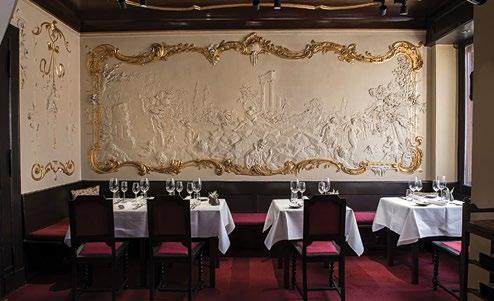
Chef Menu: 95€
Open: Tuesday - Saturday – 6:30 p.m. – 2 a.m.
Friedrichstraße 218
FRÜHSAMMERS RESTAURANT MODERN EUROPEAN
This fashionable restaurant is situated in a historic mansion owned by the "Grunwald Tennis Club". The best of Eastern and Mediterranean seafood is presented by a 2015 Michelin Star Chef, Sonia Frühsammer. The restaurant is known for its great choice of wines. Lunch for two: starting at 75 €

FlinsbergerPlatz 8
LOKAL LOCAL INGREDIENTS
This Berlin restaurant was the first in the city to use all possible ingredients.


Special attention is paid to local food. This simple and cozy restaurant with a perfect seasonal menu and light atmosphere will instantly conquer your heart. Even six years after its opening, it remains a good example of modern German cuisine.
Open: every day – 5 p.m. to 12 a.m
Linienstraße 160
BOCCA DI BACCO ITALIAN
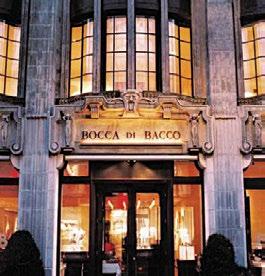
This Italian restaurant, which is a gathering place of the rich and famous, offers guests a great choice for the best cuisine and Tuscany delicacies. The enoteca is rich, featuring more than 500 wines of famous Italian winemakers. Please reserve a table in advance.

Lunch: Starting at 22 €. A La Cart: Starting at 36 €.
Open: Monday-Saturday – 12 p.m. – 12 a.m.
Weekends and holidays – 6 p.m. – 12 a.m.
Friedrichstraße 167/168
34 VOYAGER 9/2017
THE BEST SERVICE AND EXCEPTIONAL ENVIRONMENT, IT WAS AWARDED A SECOND MICHELIN STAR IN
RICHARD FRENCH
The menu of this restaurant features the best French dishes. The monthly, so-called prix fixe menu is French–influenced as well. It offers a variety of dishes. The restaurant received a Michelin star in 2015. It offers an outstanding modern environment and an elevated mood. We especially recommend the place for vegetarians.
Lunch for two: 60€; Open: Tuesday - Saturday – 7 p.m. – 12 a.m. closed on Mondays and Sundays.
KöpenickerStraße 174
EINSUNTERNULL CLASSICAL GERMAN
The restaurant owner is constantly looking for new culinary approaches. The Einsunternull took its place in the “Culinary Hall of Fame" with the arrival of Chef Andreas Rieger. This is a modern, fashionable restaurant, which has a built-in glass kitchen. Rieger uses only high-quality ingredients to create a truly unique taste and curious culinary masterpieces. Ivo Ebert, an experienced sommelier and restaurant owner, will personally choose wine pairings for each dish. The menu consists of such unusual dishes that it is difficult to attribute it to any particular cuisine.
BANDOL SUR MER FRENCH
A feast fit for a king takes place in the center of the city, on the constantly crowded Torstrase.
This is a French restaurant which fascinates with the most delicious flavors. Here you can enjoy such classical dishes as foie gras or homemade soup. Tables are placed in the street in the summer and diners can watch people pass by.
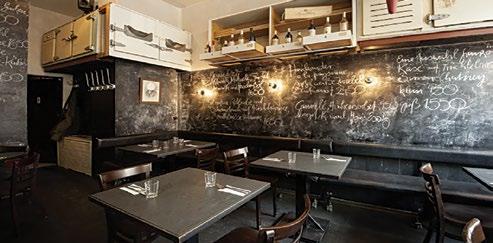
In 2015, the restaurant was awarded a Michelin star. Lunch for two: 55€;



Open: Thursday - Monday – 6 p.m. – 1 a.m.
Closed on Tuesdays and Wednesdays.
Torstraße 167
Lunch: Tuesday-Saturday – 12 p.m. – 2 p.m.
Dinner: Monday-Saturday – 7 p.m. – 10:30 p.m. Closed on Sundays.
Price: 3-course dinner –starting at 30 €, 10-course dinner – starting at 119 €


HannoverscheStraße 1
For those who love delicious snacks and quality drinks, there are two different spaces: a wonderful wine bar awaits guests on the first floor, while the second floor is home to the Michelin star restaurant, renowned for its Mediterranean dishes. The open veranda, hidden in greenery, is one of the best places in the whole of Berlin.
Here you will find more than 800 kinds of wines, which probably resulted in a second Michelin star for owner Marco Müller. Muller’s cooking is also distinguished by his continuous quest for novelty and memorable scents.
Lunch and a glass of wine for two: 60€
Open: Tuesday-Saturday – 4 p.m. – 11 a.m.
Closed on Sundays and Mondays.
Chausseestrasse 8
FISCHERS FRITZ
BEST FISH
This restaurant is known among gourmands for the best fish and seafood. With its historical Gendarmenmarkt view, this restaurant has a very special feeling. Chef Christian Lohse has received two Michelin stars.

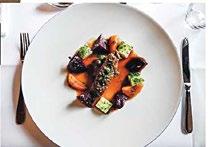
Open: Monday-Friday – 06: 30 p.m. -11 p.m. Saturdays and Sundays - – 06: 30 p.m. -11:30 p.m.
Dinner- 06: 30 p.m. -11:30 p.m.

Dinner and a glass of wine for two: starting at 100 €
Charlottenstraße 49

35 VOYAGER 9/2017
WINE BAR
RUTZ
RESTAURANTS / BERLIN
LORENZ ADLON ESSZIMMER EUROPEAN
Hendrik Otto, the owner of two Micheline stars, says: "My main desire is to create different feelings caused by my own recipes, to offer diners a trip to the world of taste ...

5-CINCO BY PACO PÉREZ AVANT-GARDE
This restaurant opened in the hotel Das Stue. It offers the highest quality dishes that are very avant-garde, varied and have unforgettable fragrances. Cinco will equally satisfy all five of your senses; this is the result of the mastery of the Spanish Chef Paco Pérez.

Open: Tuesday-Saturday - 06: 30 p.m. -10 p.m. Closed on Sundays and Mondays.
Drakestraße 1
PAULY SAAL GLAMOR OF THE 1920S
The celebrity Chef Arn Anker is a rising star in Berlin. His culinary style focuses on details, a conceptual style of cooking and seafood. The restaurant's space, with huge ceilings and a massive sculpture of a rocket makes an incredible impression.

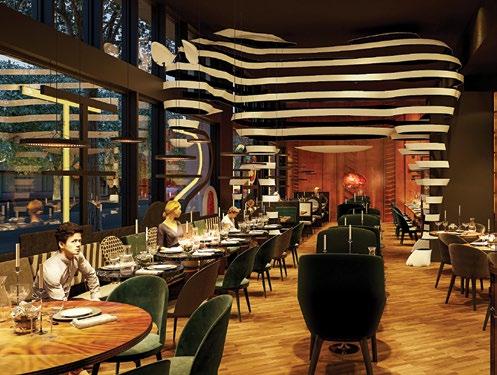
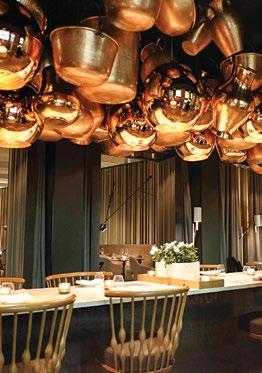
It features more than 600 wines from all over the world, so you will get an extravagant gourmet experience in Pauly Saal.

Lunch for two with a drink: 80€; Open: Lunch – 12 p.m. – 2 p.m. Dinner – 6 p.m. - 9:30 p.m.
Auguststr. 11-13
MOGG
THE BEST MEAT
Mogg is located in the impressive building of the former Jewish girls' school. The New York Times regarded it worthy of New York restaurants due to its best meat dishes. Also, we recommend tasting the delicious brioche with truffles and eggs. Lunch for two: 55€; Open: Everyday – 11 a.m. -10 p.m.
Augu ststr. 11-13
At the same time, all of my culinary creations are very personal: I recall not only the sensory memories, but it's the old recipes conveyed by family or friends. Consequently, I believe that it is of crucial importance to obtain accurate ingredients and I select the suppliers with great caution."

Lunch for two: starting at 75 €;
Open: Tuesday - Saturday – 7 p.m. – 10:30 p.m. Closed on Sundays and Mondays.

Unter den Linden 77
SEMMLER - DAS RESTAURANT CLASSIC
Markus Semmler, who has been among the best chefs for 17 years, has been leading his own restaurant since 2011 (Sempler - Das Restaurant). Classic cuisine is its trademark. Four times a week, guests are invited to a several-course dinner. The dining hall has a very cozy, domestic environment and is decorated accordingly, for example with grandmother's old china cabinet.
Open: Tuesday-Saturday - 5 p.m. - 10 p.m. Closed on Sundays and Mondays.
Sächsische Str. 7
36 VOYAGER 9/2017
I RECOMMEND THAT YOU DARE AND TASTE THE WHOLE 22-COURSE MENU. PRICE OF THE CHEF’S MENU: STARTING AT 90 €.
BRASSERIE COLETTE FRENCH
Tim Raue, Germany's most famous chef, transforms even traditional, classic dishes into completely new creations in his French-style restaurant Brasserie Colette. Croque Madame with truffles, perch poached in lard and lobster with melon are especially delicious. The atmosphere is cozy with vintage cabinets lined along the wall.
Open: everyday – 12 p.m. – 3 p.m. 6 p.m. – 11 p.m.
Passauer Str. 5-7
COMMENT:
The 6,500 restaurants and cafés in Berlin mean that you don’t have to make a reservation unless you’d like to dine in one of the most popular places. The average Berliner dines at 6 p.m. Thirty-year-old Berliners, who finish work later, gather at the bar first, and have a quick dinner later. Middle-aged and middle-class Berliners like to dine out and spend more time looking for tasty and nutritious food.
GRILL ROYAL BEST STEAK
This restaurant is a favorite destination of the stars in Berlin, and here you can look for George Clooney when he visits the city. The huge and elegant hall next to the Spree River is hidden under the bridge. It offers German, American and Japanese aged steaks. There’s nothing like them in Berlin.
Lunch for 2 persons: 75€; Open: every day – 6 p.m.-11:30 p.m.
Friedrichstr. 105b
REINSTOFF - EDISON HÖFE BERLIN CREATIVE
This restaurant has two Michelin Stars and 18 Gault & Millau points. It is located in the historic Edison building, where Germans made the first gas light bulbs a decades ago. In this distinguished environment, the chef Daniel Achilles and economist Sabine Demel opened a restaurant for gourmands. Berlin is inconceivable without it.
FACIL
MEDITERRANEAN CUISINE
This restaurant is a favorite of Berliner gourmands. It is located in the hidden internal courtyard of the Mandala Hotel.
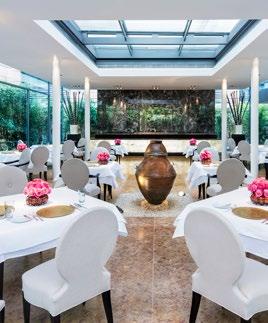
The peculiarity of the historic building, the location in the heart of Berlin and the never-ending fantasy of Daniel Achilles (the best chef of 2014) has turned this into the best restaurant in Berlin.
Five-course menu: 1starting at 110 €;
Open: Tuesday-Saturday – 7 p.m. – 12 p.m. Friday and Saturday Lunch - 12.00 p.m. 1:30 p.m.
schlegelstraße 26c
LE PETIT ROYAL FISH
Le Petit Royal, adorned with contemporary art, is a branch of the well-known Grill Royal in the Mitte district and thanks to its French bistro menu it equally attracts art lovers and food enthusiasts. Fresh fish and the best wines are emphasized here.
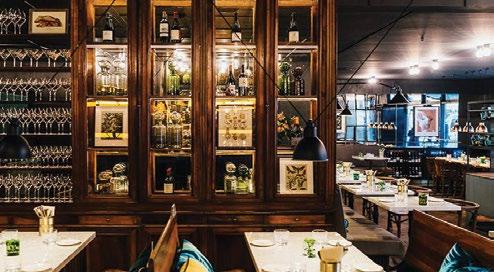



Lunch for 2 persons: 50€;
Open: Monday-Saturday – 6 p.m. – 11 p.m.
Grolmanstraße 59
The young though already distinguished chef Michael Kempf presents delicious Mediterranean cuisine in the restaurant’s glass hall. His work is so tasty that critics have already distinguished it with two Michelin Stars.
Lunch for 2 persons: 75€;
Open: Monday-Friday –12 p.m. – 3 p.m. Closed on weekends.
PotsdamerStraße 3
DATA KITCHEN DIGITAL SERVICE
Data Kitchen features a completely new, digital method of ordering with one click of a button - no waiting and no waiters!

Open: Monday-Friday –9 a.m. – 5 p.m. Closed on weekends.
Rosenthaler Str. 38
37 VOYAGER 9/2017
RESTAURANTS / BERLIN
ZUR LETZTEN INSTANZ
TRADITIONAL GERMAN
According to historical sources, Zur Letzten Instanz has had the same location since 1621, making it the oldest restaurant in Berlin. Despite the fact that any new culinary directions pick up easily in the German capital, traditional Berlin cuisine is still relevant. Pork leg with fried peas, Berlin-style calf liver and meat-and-potato
dishes are the classics that have been made in German kitchens for centuries. Since the 17th century, Zur Letzten Instanz, the oldest restaurant of Berlin, was known for hosting people like Napoleon and Goethe.


Open: Everyday – Monday: 5 p.m. – 1 a.m. Tuesday – Saturday: 12 p.m. – 1 a.m. Sunday: 12.00 p.m. –10 p.m.
Waisenstraße 14-16
OH-PANAMA
MODERN GERMAN
The two-story restaurant offers modern German cuisine.
9 KATERSCHMAUS
MODERN GERMAN
This cult restaurant was once part of Berlin's legendary nightclub Bar 25, which closed in 2010. After reopening, Holzmarkt became part of a project that covers not just culinary but artistic and music directions. The restaurant took the niche in the creative life of the city, where so-called clubbers lose the feeling of time and space. The restaurant is located by the river.
It is better to visit it during the daytime - especially in the sunny weather. The food is light and the kitchen mostly produces vegetable dishes, but the dinner menu offers classic German dishes too.
Open: Monday-Sunday – 12 p.m. – 4 p.m. 7 p.m. – 10:30 p.m.
Holzmarktstraße 25
The building has a contrasting interior: while the second floor has high ceilings, large windows and columns, the first floor offers a cozy and intimate atmosphere. The yard has a special charm in summer, while the restaurant Tiger Bar offers the best cocktails and the highest quality beer.

Open: TuesdaySaturday – 6 p.m. –11 p.m. Closed on Sundays and Mondays.
Potsdamer Straße 91
COMMENT:
Bars, cafes, small restaurants and shops do not always take cards, so it's better to have a certain amount of cash. In small cafes, it is enough to round up the sum and leave the change as a tip. A restaurant tip is 5-10%. Do not leave a tip when the owner of the institution serves you.
PRATER
THE OLDEST BEER GARDEN
From 1837 onwards, guests have been enjoying beer at tables placed under the chestnut trees.
Sausage, pretzels and potato salad are served with beer. In the evening, when the string lights are, on the place looks like a fairy tale.
Open: everyday – 12 a.m. -12 p.m. Closed in bad weather. Only cash payments accepted.
Kastanienallee 7-9
CAFÉ AM NEUEN SEE BIRGARTEN
Berlin's biggest beer garden (1,500 seats) is located in the center of Tiergarten, in Neuen See. The combination of wooden tables and fashionable white chairs, candles and elegant tablecloths is especially cozy on cold, cloudy days.

When it's hot, the cool Bavarian beer feels like rain in the desert. The menu is small, but you will find tasty foods in the pizza section, perfectly suited to beer.

Lichtensteinallee 2, Tiergarten
Street food is not only an Asian tradition. In XII century Regensburg, kitchens were arranged on trucks and builders were offered cooked meat.
Drei im Weggla is a traditional German street food - three Nuremberg sausage slices in a bun. Unlike fast food, street food is associated with communication and tasty food, so there are many markets where street food is available until midnight.
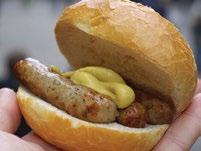
38 VOYAGER 9/2017
893 RYŌTEI
JAPANESE
Ryotei's kitchen has a special conceptual vision. The dimly lit hall is decorated with velvet and marble. You are offered so many delicacies that it’s hard to make a choice amidst these fireworks.
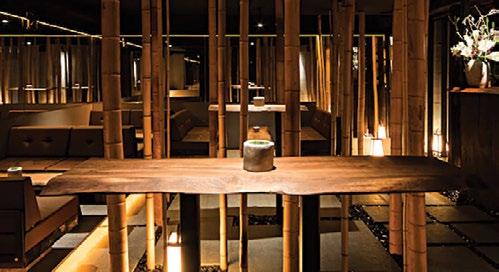
Therefore, to avoid disappointment, you have to make a simple decision: visit often. The food in the restaurant bears the mark of Duc Ngo, the legendary Berliner Chef, who has already created cult Berlin restaurants Kuchi, Cocolo Ramen and Madame Ngo. The delicious sushi and a great choice of sake are worth mentioning.
The prices of the dishes range from 5 to 32 €, one bottle of sake--35 €.
Open: Tuesday-Friday – 6:30 p.m. - 11:30 p.m.
Closed on Sundays and Mondays.
Kantstraße 135
KAME JAPANESE CAFE AND BAKERY
Kame is the first Japanese café-bakery in Berlin, opened in Charlottenburg. Instead of familiar rolls or cheesecakes, here you can try various onigiri (rice balls). You can buy these exotic delicacies every day from 9 am to 7 pm.

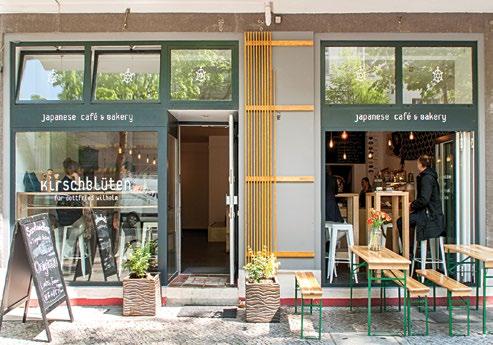
Leibnizstraße 45
MADAME NGO VIETNAMESE-FRENCH
The main menu features the most unique soups and visitors often come to taste them. The secret of making the most delicious broth is the following: don’t be stingy with meat and bones.
For example, chicken raised on natural French food is used to prepare one of the soups, Pho Ga, and only German beef is used for Pho Bo.
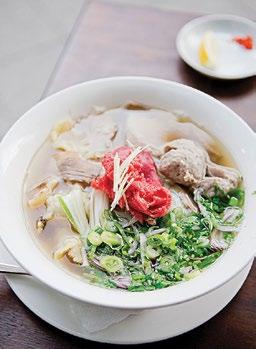
The recipe calls for no more and no less than 20 kg bones for every hundred liters of broth.
The result is wonderful: the soup has an incredible taste and a fragrance to the last spoonful. The meatchicken or beef - really melts in your mouth. Also try a baked cabbage bun.
The prices of dishes range from 11€ to 19 €. Open: everyday -11.30 a.m.-12 a.m.
Kantstraße 30
ZENKICHI IZAKAYA
Zenkichi, a little secret under the House of Small Wonder, is a huge labyrinth of hidden dining rooms, which directly lead to Japan. In this izakaya, you can enjoy fresh sashimi, fatty cod and the most delicious tofu in the city. There is no other place in Berlin that offers such a variety of rare dishes.
Open: every day – 6 p.m. – 12 a.m.
Johannisstr. 20
VOX ASIAN
This restaurant offers mixed Asian cuisine to guests. Diners can watch chefs and cooks busy in the open chrome kitchen. Cocktails are a great choice in the restaurant bar menu too.
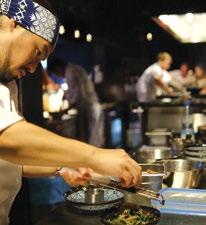
Open: every day – 6:30 p.m. - 11:30 p.m.
COMMENT:
Berliners are extremely punctual. If you are invited to a dinner, you should be exactly on time. Hosts forgive several minutes of tardiness. You can’t use no parking or a traffic jam as a valid excuse.
If you’re planning to have a dinner in a restaurant and you have made a reservation in advance, do not be late.

39 VOYAGER 9/2017
RESTAURANTS / BERLIN
Marlene-Dietrich-Platz 2
KaDeWe
Imagine two football fields filled with food: around 100 cooks, 40 bakers and pastry chefs await you on the upper floor of KaDeWe, behind more than 30 shop windows.
The most delicious dishes can be found in the oyster bar and German sausage grill.
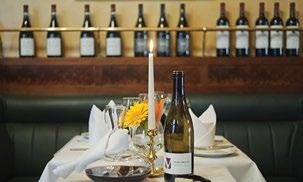

Open: Monday to Thursday 10.00am to 8.00pm, Friday 10.00am to 9.00pm and Saturday 9.30am to 8.00pm.
Tauentzienstr. 21-24
MANZINI
This nostalgic bistro in the Wilmersdorf artistic quarter is a popular place for artists and writers. Manzini has become very popular and has now opened a second branch at Winterfeldtplatz, but it still hosts loyal guests at the original address. Getting breakfast here is a wonderful choice and you can find a place to sit easily. For the late night dinner you should reserve a table in advance. It is definitely worth trying local tasty dishes, especially the Wiener Schnitzel, which will make an indelible impression on you.
Open: Every day 8.00am1.00am
Ludwigkirchstraße 11
BENEDICT
Here you can choose the special eggs benedict with Mimosa cocktail or a coffee. There is a great selection of delicacies in this location - Texan breakfast or fried bacon and cheese sandwich, definitely with eggs. Taste bakes with avocados, pancakes, yoghurts, porridge, and fresh fruit. Even the regular fresh-baked bread is very tasty in this loud café, immersed in moods from different epochs.
Open: Every day, 24 hours.
Uhlandstraße 49
ROOFTOP GARDEN RESTAURANT KÄFER
The Bundestag is the only parliament building in the world that houses a restaurant that can be visited by everyone. It is located in a greenhouse on top of the building, with a breathtaking view of Berlin. It offers mainly German dishes prepared from local ingredients only.

Open: Every day, 9.00am to 4.30pm and 6.30pm to 00.00am.
Platz der Republik 1
COMMENT: GROSZ
Breakfast or Fruhstuck is the main meal of the day. Berliners spend a lot of time on it – they begin at 6am because most of them must be at work at 7am. The more creative people whose work starts from 9.30, don’t have breakfast as early, but Fruhstuck is a part of everybody’s routine. It doesn’t matter if you have it at home or outside - many cafés and restaurants will offer you a breakfast menu that will last until noon.
From 11.30 there is a small lunch break. Most Berliners have their lunch on the go, such as a sandwich from one of the city’s 2,800 sandwich bars. Anyone who allows themselves to sit down will only have a soup, salad or other light dish.

All the restaurants that are open at this time offer a Mittagsmenu – a fast, hot and light lunch. Germans devote little time to lunch and do not spend more than €15 on it.
ENGELBERG
When visiting Engelberg, you have a chance to enjoy the true German breakfast which traditionally consists of fermented bread, rolls, numerous kinds of sausages, cheese and spreads. The secret of Engelberg is as follows: one is offered the best products from each part of the country, which you can enjoy on a beautiful patio.
Open: Monday-Friday 10.00am to 6.00pm and Saturday-Sunday 9.30am to 7.00pm.
Oderberger 21.
The cult Grosz Cafe and Restaurant located in Haus Cumberland, constructed in 1911, is a true gastro emporium, offering special breakfasts. Despite always being booked, the doors are open even to those who come in just to drink a coffee and read a newspaper. Open: Every day 9.00am to 11.00pm

Kurfürstendamm 193/194
NUR GEMÜSE KEBAB

MUSTAFA’S GEMÜSE KEBAB
The clearest proof that the best doner kebab in Germany, invented in Berlin in 1972, is made here, is the line that starts from the Mehringdamm Square and lasts for two hours on average.
Open: 10.00 am - 2.00 pm
Mehringdamm 32
Those who do not have time to stand in line should consider another tasty kebab place as an alternative option. Nur Gemüse Kebab offers a wonderful chicken kebab. Everything is fresh here - from grilled food to the finest meat. Kebabs are offered with eight different sauces (curry, avocado, humus, chili, etc.).
Open: 10.00-14.00 Hermannstraße
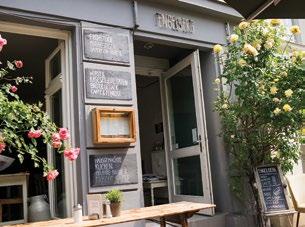
40 VOYAGER 9/2017
113
ROGACKI
This legendary place in Western Berlin, dating back to the 1930s, offers the finest meat dishes, sausages and smoked seafood. A fast lunch with German sausages is their specialty. You can enjoy the smoked freshwater trout or eel. Both of them are freshly caught in lakes around the city.
Wilmersdorfer 145-146
MARKTHALLE NEUN

The hall of the most beautiful open market, the undisputed center of Berlin’s culinary frontier, is home to the city’s most famous butcher (Kumpbel & Keule), American style barbeque (Big Stuff), Italian bakery (Sironi),
THE BIRD
This is Berlin's most famous New York style steakhouse. It is no coincidence that The Bird offers the most celebrated burger in the city. If you decide to taste the steak here, you should reserve a table well in advance. Steak is sent from the United States and is then dry aged for 30 days.
Am Falkplatz 5
BURGERMEISTER
Ordering a cheeseburger in the middle of a busy street in the former public toilet building under the Schlesisches Tor U-Bahn station, might not sound like gastronomic bliss, but the long line of people in front of Burgermeister suggests otherwise.
There is another branch in Kotbusser Tor.
Oberbaumstr. 8
HACKESCHEHÖFE
This is one of Berlin's most interesting crowded places that you should visit for its modern look and special atmosphere, if nothing else. A combination of several different bars, restaurants and clubs turns this space into the main center of nightlife in Berlin.
A 27,000 sq.m. space between Rosenthalerstrasse and Sophienstrasse, it also includes several cultural institutions, cafes, shops, cinemas and residential buildings. The space around OranienburgerStraße is the best

COMMENT:
What do people eat in Germany? Lots of vegetables, not much fruit and a lot of meat. The wide variety of products has its disadvantages: many Germans suffer from obesity and type 2 diabetes. On the one hand, meat provides the body with proteins, vitamins and microelements, but on the other hand,
smoked fish company (Glut & Späne) and a home brewery (Heidenpeters). In addition, Marthalli Neun holds weekly "street food Thursdays" and a monthly "breakfast market" (every third Sunday). These are the best street fairs in Berlin today.
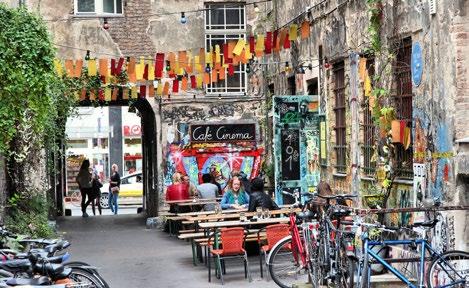

Eisenbahnstr. 42-43
place to spend an unforgettable evening. There are numerous restaurants here, but this place mostly has lots of bars and night clubs. A good time could be spent in cinemas and in the Chamäleon theater or one of the many art galleries. Everything has a sense of novelty here and is distinguished by a modern style.
There is nothing better than to sit in a street café and watch the Berlin nightlife – especially since, be it bar, café, cinema or a regular theater, all are open till the morning.
RosenthalerStraße 40/41
consumption of large quantities of meat causes an excess of cholesterol and fatty acids in the body. German nutritionists recommend that a healthy diet should include no more than 300-600 grams of meat per week, less wholegrain bread, less alcohol, more fruit and mineral water, and less sugar.

41 VOYAGER 9/2017
BREAKFAST / LUNCH / MARKETS / BERLIN
CODA DESSERT BAR
After gaining popularity in New York and London, so-called "dessert bars" have finally taken off in Berlin as well. Coda Dessert Bar was the first such enterprise in Germany, and it soon became a real paradise for those with a sweet tooth. Three-time Michelin star winner Rene Franck is known for his unique pastries. Thanks to inexhaustible fantasy, hard work and bold decisions, he creates such wonders as black chocolate cake with plum, hazelnuts and chicory. These desserts are best paired with the bar’s equally remarkably cocktails.
Friedelstraße 47
FASSBENDER & RAUSCH
Here, traditional chocolate products are presented in completely non-traditional formbe it in the shape of the Brandenburg Gate, Emperor Wilhelm Cathedral or Reichstag. In this temple to chocolate, desserts exceed all sweet-tooths’ expectations. The store offers a wide variety of European candy. Its café and restaurant are famous for novel pastries and the chocolate menu.


Charlottenstraße 60
1900 CAFÉ BISTRO
The 1900 café, filled from floor to ceiling with antique furniture, lamps and carpets, offers an unusual delicacy in the afternoon. You will definitely want to try their old-fashioned tarts made with plum, apple, blackcurrant and brown sugar. Everything is handmade here, and the sizable portions are delicious.
Knesebeckstraße 76
ZEIT FÜR BROT


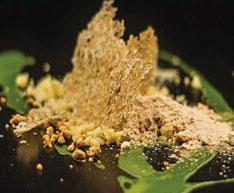
Get ready to stand in line in front of Zeit für Brot because the whole of Berlin talks about this venue’s cinnamon bread. Visiting Zeit für Brot is worth it just for German breakfast - stulle (wholewheat bread rolls with ham and cheese), a large cup of coffee and the glorious local bread.
Alte
Schönhauser
4
DU BONHEUR
You might even plan a visit to a French bakery while in Berlin. Du Bonheur's eclairs and pastries are distinguished by their exquisite textures and aromas and are irresistible to those who love good food even slightly.
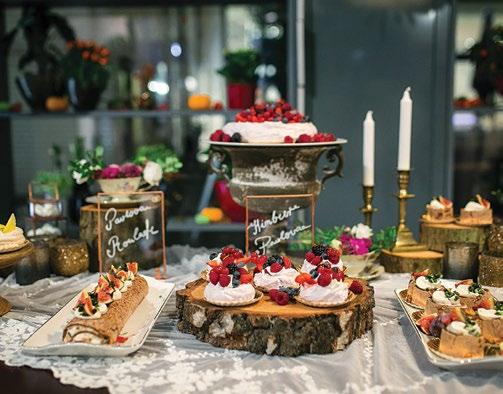
Brunnenstr. 39
THE STORE KITCHEN
This impressive fashion and design store conceals a modern restaurant with several British chefs who prepare delicious dishes in modern British and Ottolenghi style cuisine.
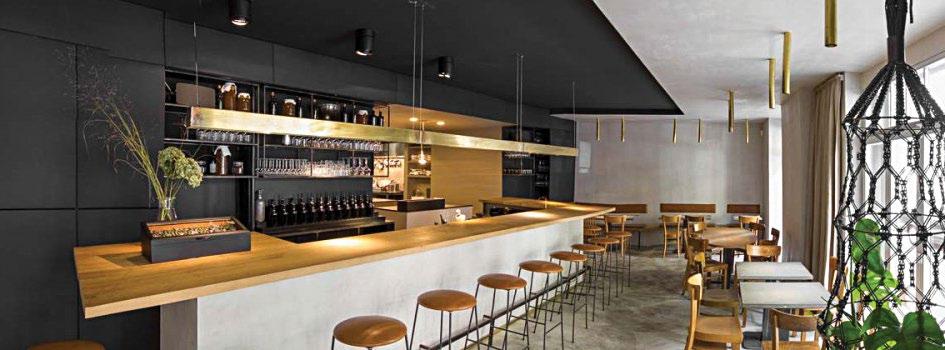
At lunch, this restaurant will surprise you with the best vegetarian dishes in Berlin, and on the weekends meat and seafood is added to the menu.

Open: Monday-Saturday - 10.00 a.m. - 07.00 p.m. Closed on Sunday.
Torstraße 1
SMOKING IS ALLOWED IN MOST BERLIN BARS (IN SOME PLACES AFTER 9:00 P.M.). IN RESTAURANTS, YOU CAN SMOKE ONLY ON TERRACES. A PACK OF CIGARETTES COSTS €5-7.
42 VOYAGER 9/2017
CAFES / BERLIN
RECOMENDATION
“RED CAFÉ DINING”
A NEW RESTAURANT AND SPECIALTY COFFEE

Specialty coffee – should not be confused with gourmet of premium coffee. The beans are cultivated in ideal microclimates and soil. They deliver a unique aroma and flavour to the finished product. Conditions like this mainly exist along the equator in places such as Colombia, Ethiopia, Brazil, Indonesia and Vietnam. The raw coffee beans are shipped from these microclimates to locations such as UK, New Zealand, USA, Japan and now including Georgia.
To fully reach our taste buds, coffee must go through several important steps: roasting, grinding and brewing are the stages of making good coffee, these are the phases coffee undergoes just a few minutes before it is served.
You can enjoy specialty coffee like this made from a blend of coffee beans delivered from various countries such as Rwanda, Honduras, Guatemala and Ethiopia in the new “Red Cafe Dining” restaurant at Marjanishvili Street.
Each cup of specialty coffee can offer contrasting flavours and aromas. Similar to growing grapes for wine making, coffee beans take on flavour profiles from its surroundings.
Whether filter brewing or pouring shots from Red Café’s Black Eagle espresso machine, these methods can make the coffee superior to traditional methods. Adding perfectly tempered milk to espresso, adds natural sweetness and can give delicate scent creating essence of milk chocolate and hazelnut flavours among other notes.
Apart from their great coffee, “Red Cafe Dining” offers its customers a new menu with distinctive concepts; traditional Georgian dishes prepared in a modern style. A combination of appetizing local and European cuisine, specially developed by Jared Bryant, a London based consultant invited by “Red Cafe Dining”, with the help of Georgian specialist...
THE “RED CAFE DINING” NETWORK IS A SUBSIDIARY OF REAL ESTATE DEVELOPMENT AND ASSET MANAGEMENT FIRM "REDIX GROUP’S" HORECA NETWORK, WHICH CURRENTLY HAS 3 BRANCHES IN TBILISI: VAZHA-PSHAVELA AVENUE 71, LEONIDZE STR. # 2 (FREEDOM SQUARE) AND MARJANISHVILI STR. # 8.

ADVERTISEMENT
BAR TAUSEND
You will definitely find the name of Bar Tausend in the recently created list of the best bars in Berlin. It is still on the list of exceptional places in Berlin


thanks to its location, if nothing else. The bar is hidden under the train tracks at the Friedrichstrasse. When you find the bar doors, you must ring a bell and the host will invite you in. The decor is very refined and creative. A large, eyeshaped mirror will immediately draw your attention. There are even mirrors on the ceiling here. Excellent bands, DJs and artists perform at Bar Tausend. You will feel vibrations while enjoying a cocktail – this is a train passing above you.
Schiffbauerdamm 11
SCHWARZE TRAUBE
The bearded owner of the Kreuzberg's bar became a legend of Berlin after his cocktails brought him the title of "Germany's Best Mixologist" in 2013. This is a very small cocktail bar – you have to knock on the door to get inside.
REINGOLD
In an ostentatiously decorated bar, guests are comfortably seated in leather armchairs and enjoy snacks and cocktails. This place is a mix between modern style and old-fashioned charm. There are many seats by the long bar, though the hall is always full as this is the best bar in Mitte. At the end of the week, DJs play live sets with a mix of jazz, swing and hip-hop.
Novalisstraße 11
IMMERTREU
You will find the best cocktails in this carefully hidden bar. The design is minimalistic, the hall dimly lit, with red curtains and bronze illuminations. On the local cocktail menu, you will find both creative drinks and classic choices. Your drink will be served in a vintage glass.
Christburger Str. 6
BAR MAQUÉS
There are no drinks on the menu –instead the bartender will deftly prepare a cocktail to match your tastes. Or you can order a gin and tonic –there are more than 100 kinds of gin on site. Due to its exceptional quality, the cocktails in this bar are relatively expensive by Berlin standards. It is a small, cozy place with just a few tables, a friendly atmosphere and truly unique cocktails.
Graefestraße 92
GREEN DOOR
Huge lumps of ice and old glasses perfectly fit the local dishes. There is no menu here – the waiter will just ask what aromas you prefer and the owner will prepare a cocktail for you.
Wrangelstraße 24, Kreuzberg
TIGER BAR
The famous representative of the culinary world of Berlin, Ludwig Cramer-Klett opened his own bar, Tiger Bar. It quickly became a true treasure for those who love to drink at night.

Potsdamer Straße 91
BUCK & BRECK
To get into this beautiful bar, you have to ring a small bell attached to the door. If they allow you in, prepare yourself for the most exclusive and outstanding cocktails in Germany. Both classic and innovative drinks are perfectly represented here.
Brunnenstr 177, Mitte
Cocktail lovers have been served here since 1995 and are offered more than 500 different kinds of drinks. As for the name, it is obviously an echo of the "prohibition law" in the United States when a green-colored door indicated a place where one would be able to buy an alcoholic drink.
Winterfeldtstraße 50
PAULY SAAL BAR

This bar is especially attractive for those who want to experience the "golden age" atmosphere of the 1920s. You can also try the best that local chef Arne Anker can offer at much lower than restaurant prices – and you won’t have to wait too long either.

Auguststrasse 11-13
LIMONDIER
They respect traditions in this cocktail bar. The bar is decorated in the style of the 1920s. The most distinguished drinks are Negroni and Paloma. The strangely named Fog Cutter or Spiced Figs Swizzle are also remarkable. Refined and subtle glasses are cooled to -27 °C before drinks are poured into them, so they stay cold for a long time.
Nostitzstraße 12
44 VOYAGER 9/2017
BARS / BERLIN
Cocktail Price from 8€

BERGHAIN
Legendary Techno Factory
This club is located in an old power plant. It is celebrated for two things: marathon music events that last until the next afternoon, with some of the guests leaving the club half-conscious; and mythical, Cerberus-like face control, which does not allow every third-person in the queue to get in. You will find a long list of advice on the internet on how to get into Berghain ("dress casually", "do not look at your phone", "speak German") but the “science” is still unclear as to what the criteria are that the stern men on the door use to rate the public.

Panorama Bar is located on the upper floor of Berghain, recognized as one of the best nightclubs in the world. The emphasis is always on house music and all the variations of this genre. In contrast to Berghain's hard-core techno,
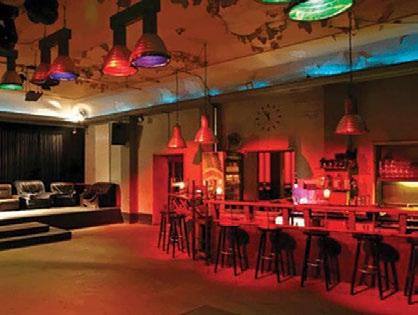

a large square bar and a DJ booth with a dance area on the opposite side. The interior of OHM includes ceramic tiles and wooden benches are located along the walls.
more melodic and relaxing music plays here. This is the ideal place to relax. You can order a drink, rest and return to Berghain's main dance floor afresh. However, if you're a true fan of house music, you’ll find it difficult to leave this atmosphere behind. It's hard to get into Panorama Bar for logical reasons: you must first pass Berghain's face control –enough said!
Säule
This is another addition to Berghain, which opened this year. Here you will hear techno and house music. Säule is a space where more "dark" experimental electronic music takes place. Säule was wrapped in mystery from the beginning. Thanks to the music, this place still remains mysterious to this day.
Entrance fee: 10-18€
Am Wriezener Bahnhof, Friedrichshain berghain.de
OHM
The Different Space
Like its famous neighbor, Tresor, OHM is a notable club for people interested in (not just) electronic music. It is located in one of the rooms in Kraftwerk, an industrial factory built in the 1960s. The third quarter of the club consists of

OHM is mainly focused on experimental, noise, techno, electrical, house, and so on, though this short list of genres does not actually reflect the diversity of the club's program. One evening you may have a three-hour noise and atonal performance and a jazz-fusion band playing the next day. The small size of the club and the intimate situation creates a pleasant mood.
It should be noted that everyone can get into OHM (+18). There is no "dress code" at the door or request for any kind of verification.
The club's program is also open to other art fields and often includes regular parties that include music, visual installations and performances.
ZUKA BABUNASHVILI'S RECOMMENDATION:
Travelers to Berlin should definitely visit this place, even if they are not usually interested in such entertainment - many times I’ve left this space amazed by new observations, emotions and sudden surprises. Almost all of the events cost 5 to 10 €, which is much cheaper than other places.
Köpenicker
Str.
70
www.ohmberlin.com
46 VOYAGER 9/2017
Panorama Bar
TRESOR
Techno Music Veteran
Tresor opened in a bombed building in 1991 in the unpopular neighborhood of Potsdamer Platz. Detroit techno shook its almost-collapsed ceiling.


Soon the club moved to a darker building an abandoned power plant. Now, the children of those who danced to Jeff Mills sets in old Tresor dance in the new one.
Entrance fee: 10-18€
Köpenicker Straße 70
ARENA CLUB
The Birth of the Techno Era
Arena Club, located on the Spree River, perfectly embodies early Berlin subculture and the time of techno music’s birth. It is part of a huge complex called Arena Berlin. It is located in a vintage former boiler room.

Large space, wooden dance floor, glass blocks, colorful club lighting and industrial elements combine with the best electronic music, creating a great atmosphere. Arena Club is visited by worldwide techno fans. They spend the night dancing and they always come back.


Red Robin, Ellen Allien and Format B –just a small list of the famous artists who
LOOPHOLE Experimental Electronic Music
Neukölln's alternative charm – a ragged suburbia atmosphere and the cries of hipster souls – are concentrated in the Loophole night club. Groups of artists, musicians, music lovers and hipsters dance at the club in the former bordello building. The repertoire is constantly changing: experimental electronic music, black metal, diffuser, rough, alternative sound saxophones, kitsch rhythms etc.
SAMEHEADS
Best Electronic Music
This is simultaneously a bar, club, gallery and fashionable boutique. Some days it also hosts film screenings, though grab your warm clothes – films take place in a cold basement. Every Thursday visitors exercise their minds on quiz day. During the week, Sameheads is a cafe and bar while at the weekend it becomes a club. The interior is a mixture of kitsch and different design concepts - it is casual and pretentious at the same time. The music is diverse: you can dance to disco tunes or the rhythm of experimental music. Life is vibrant in the club and the best electronic music is played.
Entrance fee: 10-15€
Richardstraße 10, Neukölln
Brudinale is an alternative to the Berlinale that takes place here annually. It could be said that this is a punk version of the famous international film festival with its jury, nominations and awards. The club parties are unforgettable – the guests never stop dancing (with short breaks in a soft, cozy room). The dress code is not pretentious - simple or hipster clothing is appropriate for the occasion.
Entrance fee: 10-18€
Boddinstraße 60
perform here. We can tell you about the club's face control criteria: forget jeans or sports shoes; dress “smart casual”. The club can hold up to 500 people.
Sign in: 10€
Eichenstraße 4, Treptow
://ABOUT BLANK
Two Dance Floors and a Small Forest
:// about blank is a great complex that combines different spaces, and in general is an unusual club. The outer area is open from spring to autumn - a huge garden with two dance floors and a small forest.
Beds and couches are scattered across it. A variety of parties takes place here – you will definitely find an event that is perfect for you.
The garden closes as winter approaches and the club gets a new atmosphere. Inside, there is a dark dance space – it is hot and guests sweat to the rhythm, while on the second dance floor there is a lighter, friendly place where all genres of music are performed.
:// about blank is as difficult to get in to as Berghain. These two clubs have almost the same face control laws – so be ready!
Entrance fee: 2-10€
Markgrafendamm 24
47 VOYAGER 9/2017
CLUBS / BERLIN
GLITTERY BERLIN, LIKE ALL OTHER EUROPEAN CITIES, HAS BIG SHOPPING CENTERS AND ALL THE FAMOUS FASHION HOUSES, BUT UNLIKE OTHER CAPITALS, THERE ARE SHOPS HERE THAT YOU CANNOT FIND ANYWHERE ELSE, SO YOUR PURCHASES WILL ALWAYS BE DIFFERENT AND ORIGINAL. BERLIN IS THE MOST DEMOCRATIC EUROPEAN CITY. SHOPPING SUPPORTS THIS IDEA AS WELL—PEOPLE OF DIVERSE TASTES AND FINANCIAL MEANS FIND ITEMS THEY LIKE. THE AFFORDABLE PRICES, ORIGINAL STYLE AND DIFFERENT ATMOSPHERE ARE THE MAIN CHARACTERISTICS OF BERLIN.
Here are the best, latest collections of The Row, Proenza Schouler, Balenciaga and Ann Femeulemeester. In addition to the boutique, you can visit a café, a beauty salon, a library and a bar where they serve delicious juices.




THE CORNER
This conceptual shop appeared on the fashion scene 10 years ago. Today the brand is represented by three stores, two of which are symbolically named

THE STORE
It's hard to think of a simpler name for the shop, but this store does not need much noise. The main idea here is to offer beautiful things for a beautiful life: exclusive clothing, accessories, unique magazines, tables, aromatic candles. Stop by if you love the world of fashion.
VOO STORE
The space in which the famous conceptual Voo Store is located was the site of an old knife-grinder store. Currently it is the most fashionable hipster Kreutzer district and is equally interesting for fashion, art and design lovers. Here you will find clothing, shoes and accessories - sunglasses, jewelry, watches and home décor. The Voo Store features products of modern and interesting brands such as: Acne, Stine Goya, Do Not Shoot The Messenger, Wood and Vintage Designs.
Oranienstrasse 24, Kreuzberg
BIKINI BERLIN
The 50-year-old Berlin modernist monument of Bikinihaus and the non-traditional concept of shopping centers distinguishes Bikini Berlin from all other shopping centers in Berlin. Here you will find the following brands: Samsøe & Samsøe, Am + Aspesi, Artek Conceptstore, Ikomo, Labo.Art, Manila Grace, Anna Kraft, Goldfisch, Lnfa, Mabba, Mammut, Vans, Closed, Carhartt, Teufel, and Gant, as well as the most popular sunglasses and the latest collection of Mykita.
Budapester Str. 38-50
The Corner East and The Corner West. Although the wall has been destroyed for 20 years, East and West Berlin have different styles and tastes. In The Corner East, look for young and avant-garde designers, while the more bourgeois The Corner West has unique brands of world brands. The Corner Men targets men - it features the best of the latest gadgets, clothing and fashionable accessories.
ANDREAS MURKUDIS
Andreas Murkudis, the owner of the eponymous space, dedicated 15 years of his career to art: he managed the Berlin museum - Museum Der Dinge. Later Andreas got interested in commerce and decided to open his shop in a former typography building, in the center of Berlin, on Potsdam Strasse. Nevertheless, his artistic past still has a strong hold over him.
The items selected by him every season look as if the owner assembled a museum collection: you can buy the works of young artists, along with renowned luxury designers.
Potsdamer Strasse 81
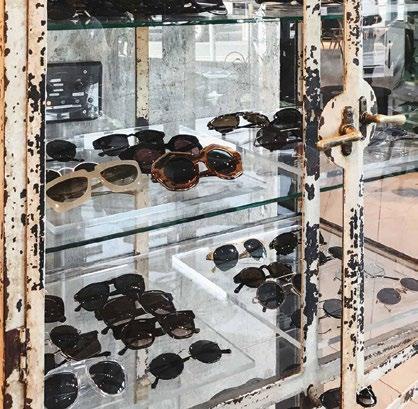
48 VOYAGER 9/2017
Torstrasse 1, Mitte
Französische Strasse 40, Mitte
KaDeWe
The KaDeWe's doors were opened in Berlin in 1907. Like London’s Harrods and Paris’ Galeries Lafayette, Kadewe is considered one of the world's most important department stores.

Marlene Dietrich, Billy Wilder, Liz Hurley, Robbie Williams, Princess Beatrice and Princess Eugenie of York, presidents, politicians - Kadewe has always hosted popular people.
A love for transformation, innovative designs, international trends, cosmopolitanism, original performances and New Year installations makes visits unforgettable.
KaDeWe features the best brands and exclusive clothing from all over the world. Here you can see the new trends, acquire desired items, or dine in the famous Feinschmeckeretage –the biggest food court in Europe.
Open: Mondays and Fridays – 10 a.m. - 9 p.m.
On other days – 9:30 a.m. – 8:00 p.m. closed on Sundays.
Tauentzienstraße 21-24
Kurfurstendamm, shortly known as Ku'dam-ada, is the main address for shopping in Berlin, along with Tauentzienstrasse.
Tauentzienstrasse is a storehouse that features many international names, including Niketown and Uniqlo. Big names such as Bulgari, Chanel, Louis Vuitton, Valentino and Gucci are located on Kurfurstendamm, between Uhlandstrasse Boulevard and Abenauerplatz.
The more relaxed streets by Uhlanbstrasse house modern boutiques of famous brands that have been around for over one hundred years. One cannot underestimate the importance of these brands in the fashion and design world.
Kurfurstendamm's parallel Kantstrasse is the second major shopping street in Berlin's Charlottenburg-Wilmersdorf neighborhood. It also hosts many interior designers' studios. Suarezstrasse can be regarded as an antique trade center, while Stilwerk features furniture and fashion designers such as Bang & Olufsen, Bulthaup and Ligne Roset. Shopping fans will encounter many colorful stores, galleries and restaurants on Savygnyplatz.
Gendamermenmarkr also hosts one of the world's most popular shopping centers, The Corner Berlin, where there are many shops, boutiques, exhibition galleries and cafés. Here you can see new fashion designs next to famous designers, as well as different accessories, cosmetics, etc.
Mitte's relatively comfortable and cozy streets house a lot of interesting galleries and clothing shops. Mulackstrasse and Gipsstrasse have turned into a mini-Soho.
Comment:
FRAU TONISPARFUM
JIL SANDER
JIL SANDER shop has a new design in Berlin. The interior harmonizes with the brand's collection: the constructed elements, clean lines and modern style are JIL SANDER's visual identity and aesthetics. Décor plays on contrasts between natural and synthetic tissues, especially with rubber. Excellently designed lighting creates a quiet, intimate atmosphere.

Kurfürstendamm 185; Jilsander.Com
Stephanie Hanssen, inspired by her grandmother's fragrances, finally made a long-time dream come true—she open a perfumery boutique and named it Frau TonisParfum in honor of her grandmother. This seemingly uneventful space is mainly occupied by shelves full of glass bottles, with a white interior design that creates a sense of nostalgic beauty. As for the scent: for example, Vial (No. 37) was inspired by Marlene Dietrich's favorite fragrance, Sminta (No. 20) and is reminiscent of Chanel No. 5. Those who wish to buy something else can choose from many other fragrances. Zimmerstraße 13
TRADITIONALLY, SALES TAKE PLACE IN SUMMER AND WINTER. SUMMER SALES START ON THE LAST MONDAY OF JULY AND WINTER SALES ON THE LAST MONDAY OF JANUARY AND LAST FOR TWO WEEKS. REDUCED PRICES ARE LABELED: REDUZIERT, TRADITIONAL % AND THE WELL-KNOWN SALE. THE SUMMER DISCOUNT IS CALLED SOMMERSCHLUSSVERKAUF AND THE WINTER WINTERSCLUSSVERKAUF.

49 VOYAGER 9/2017
SHOPPING / BERLIN
STATISTICS
357 340 SQ.KM IS THE AREA OF GERMAN TERRITORY. IT IS THE FOURTH LARGEST IN THE EU, AFTER FRANCE, SPAIN AND SWEDEN.
GERMANY IS THE MOST DENSELY POPULATED STATE IN THE EU (82.3 MILLION INHABITANTS).
20.3% OF THE POPULATION (16.4 MILLION) ARE OF IMMIGRANT DECENT, OF THEM 9, 2 MILLION ARE GERMAN CITIZENS, 7.2 MILLION ARE FOREIGN NATIONALS.
4 NATIONAL MINORITIES ARE RECOGNIZED AS THE INDIGENOUS PEOPLES OF GERMANY : DANES (50 000), FRISIANS (60 000), LUSATIA SORBS (60 000), AND GERMAN ROMA (70 000).
GERMANY’S 2016 GDP IS 3 144 MILLION EUR INFLATION- 1.8%, ECONOMIC GROWTH - 0, 6% UNEMPLOYMENT - 3, 9% INCOME PER CAPITA - 38 114 € destatis.de
BY 2030, GERMANY'S GDP WILL INCREASE TO 160 BILLION EUROS.
1-BEDROOM RENT PER MONTH (CITY CENTER)
2 BEDROOM APARTMENT MONTHLY UTILITY PAYMENTS WI-FI / CABLE TV PER MONTH
AREA 892KM 2
2500 PARKS
140 THEATERS AND CONCERT HALLS
3 593 000 POPULATION
900 BARS
4650 RESTAURANTS
175 MUSEUMS
190 CLUBS AND DISCO CLUBS
130
CINEMAS
GERMAN ECONOMY IS THE FOURTH LARGEST IN THE WORLD.
THE LARGEST DISTANCE FROM NORTH TO SOUTH IS 876 KM, AND FROM THE EAST TO THE WESTERN BORDER IS 640 KM.
NORTH SEA, DENMARK AND THE BALTIC SEA BORDER GERMANY TO THE NORTH , POLAND AND CZECH REPUBLIC TO THE EAST , AUSTRIA AND SWITZERLAND TO THE SOUTH , AND FRANCE, BELGIUM, LUXEMBOURG AND THE NETHERLANDS ON THE WEST
PRICES
1 CUP OF COFFEE / TEA
1 CUP OF BEER
1 BOTTLE WATER
numbeo.com
MONTHLY GYM PASS
AVERAGE SALARY PER MONTH NET THE TICKET AT THE MUSEUM
TAXI (1 KM)
3-COURSE DINING MENU FOR 2 PERSONS IN THE RESTAURANT
CINEMA
25€
8€ FROM 40€
2€ 8,50€ COCKTAIL
FROM 2050€ FROM 9€
0,80€ FROM 5€
BERLIN
BREAD 1 BOTTLE OF WINE FROM 230€ FROM 750€ 6€ 27€ 2,61€ 3€ 1,28€
TICKET 1 PACK OF MARLBORO
50 VOYAGER 9/2017


ABOUT 80,000 MEN IN GERMANY ARE SHORTER THAN 1, 50 M, AND 70,000 WOMEN – HIGHER THAN 1, 90 M.
BY 1990, 15% OF GERMAN CHILDREN WERE BORN OUT OF WEDLOCK. BY 2010, IT WAS 33%.
IN 2016, 7.75 MILLION OF GERMAN POPULATION IDENTIFIED AS VEGETARIAN, 900,000 –AS VEGAN.
THE AVERAGE WALLET OF ADULT GERMAN HOLDS 103 EUR CASH. CELL PHONE AND INTERNET PAYMENTS TEND TO GROW STEADILY, BUT CASH IS STILL GIVEN AN ADVANTAGE - FIVE OUT OF FOUR TRANSACTIONS ARE MADE BY CASH TRANSFER.
IN 1902 THERE WERE 605,000 TROOPS IN THE COUNTRY, AND THE NUMBER OF MILITARY SERVICEMEN IN 2015 IS 177, 069 (AMONG THEM 28,284 WOMEN).
THE GERMANS
Thomas Müller is the most common German name.
THERE ARE 72 MILLION BIKES IN THE COUNTRY; 30% OF HOUSEWIVES USE BICYCLE AS A MEANS OF TRANSPORTATION IN BIG CITIES.
ON AVERAGE, EACH GERMAN WALKS 1.5 KM PER DAY.
ADOLESCENTS AGED 10-17 SPEND 37 MINUTES FOR AVERAGE DAILY EXERCISE.
GERMANY HAS MORE THAN 80 NOBEL PRIZE LAUREATES.
IN TERMS OF INVENTIONS, GERMANY IS "CHAMPION OF EUROPE". 360 900 SCIENTISTS/ RESEARCHERS WORK IN THE COUNTRY.
THERE ARE 117 BILLIONAIRES IN GERMANY, 8% OF THE PLANET'S WEALTHIEST PEOPLE.
GERMANY IS A GREEN COUNTRY, A THIRD OF ITS TERRITORY IS COVERED BY FOREST. MORE THAN 2% OF ITS TERRITORY IS COVERED BY LAKES, RIVERS AND OTHER WATER RESERVOIRS.
IN 2020 GERMANY WILL HAVE 1 MILLION ELECTRIC CARS.
26% OF THE COUNTRY’S ELECTRICITY IS RELEASED BY RENEWABLE ENERGY SOURCES. SUCH SUPPLIES WILL GENERATE 80% OF THE ELECTRICITY NEEDED BY 2050. GERMANY IS THE WORLD'S MOST ECOLOGICALLY CLEAN COUNTRY.
THE LENGTH OF THE GERMAN ELECTRICAL WIRE IS 1.79 MILLION KILOMETERS; THE HIGH VOLTAGE COULD CIRCLE THE EARTH'S EQUATOR 45 TIMES.
THE ANNUAL TURNOVER OF THE ORGANIC PRODUCE IS 7.6 BILLION EUR. 23,500 FARMS OCCUPY 6, 3% OF AGRICULTURAL LAND.
GERMAN CLIMATE IS MODERATE: IN JULY THE AVERAGE TEMPERATURE IS 21.80 C, AND THE MINIMUM IS 12. 30 C. AVERAGE TEMPERATURE MAXIMUM IN JANUARY 2.10 C, MINIMUM IS -2.80 C.
THE SUN SHINES 1 670 HOURS PER YEAR IN GERMANY.
GERMANY WAS THE FIRST COUNTRY TO IMPLEMENT DAYLIGHT SAVING TIME IN 1916.
53 VOYAGER 9/2017

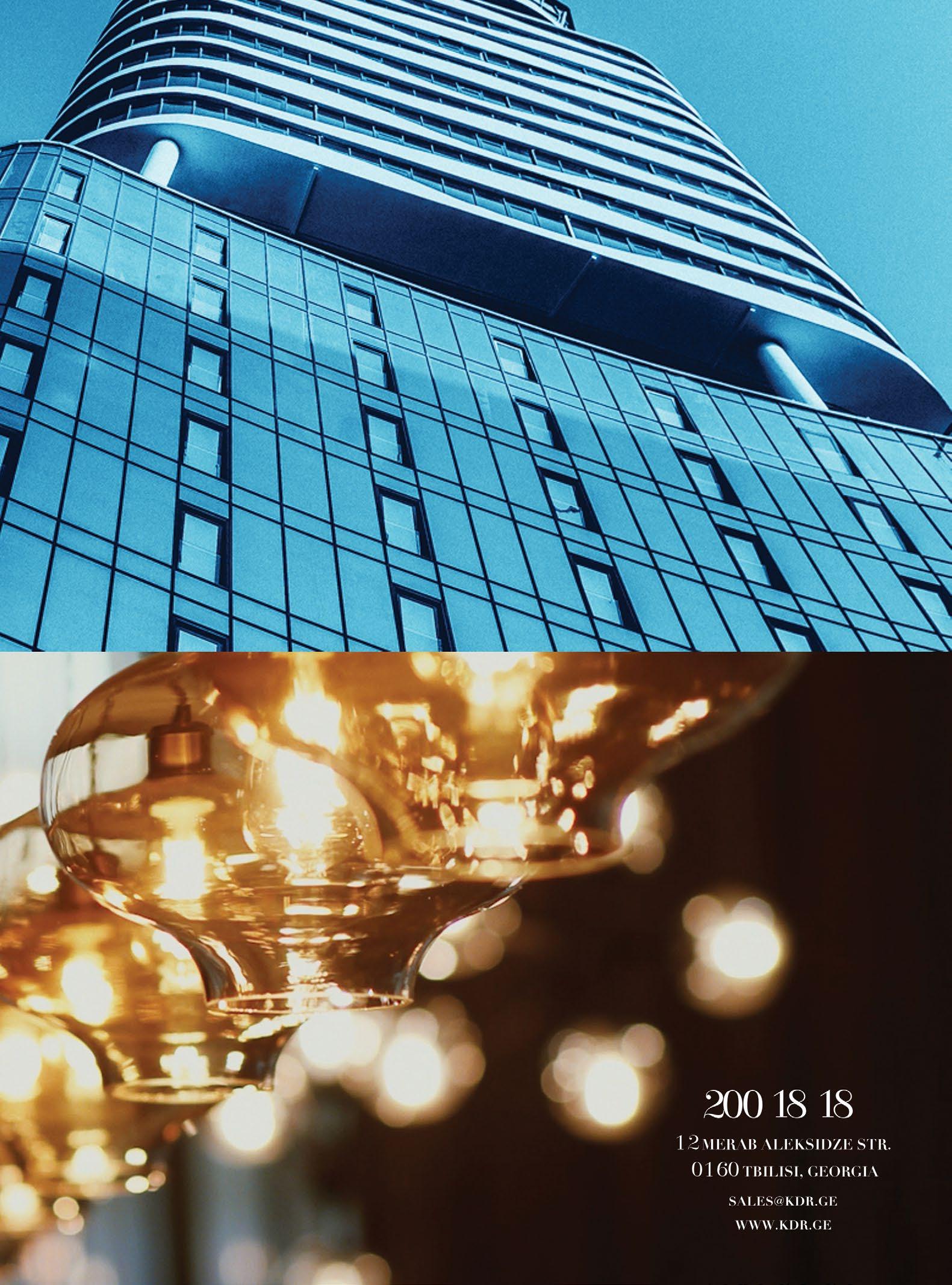
VERY GERMANY AKA MORCHILADZE
Today, Germany is Europe’s leader – a country of philosophers, premium cars, artists, leading scientists, strong villages and sturdy cities, reigning world champion football players, dark beer, big portions, order, construction, long roads, stinging cold, long work days, and timeless universities.

At least, that’s what they say. It is true that no other country in the EU is so rich, the fact confirmed by titles of the daily news about Chancellor Merkel, her decisions, a well-tuned, affluent
system, income flowing in, and so on. Germany is an attractive county for those seeking a better future, but non-EU nationals might find it very difficult to legally live and work in Germany. Nonetheless, thousands of Georgians have been living there for the last 25 years and many more travel back and forth or have visited at least once. Thus, Germany does not feel unfamiliar. In addition, education is free in Germany, and many Georgian students travel there. Any attempt to say something new or unknown about the country is futile.
COUNTRY 56 VOYAGER 9/2017
Germany is perhaps the most open country in the EU and maybe even among all European countries. This may not be apparent in its legislature, not that it has more linient laws for the foreigners; still, Germany is the most open country, not only because it has opened its doors to millions of refugees, but because it is interested in foreign cultures, in a very natural, characteristic way. While in Europe, everybody seems content with their own, sometimes unaware what to do with it, Germany is the polar opposite. Germans translate the most number of foreign books, I believe ten times more than the English. Germans organize the most exhibitions of foreign artists and constantly invite foreign creators into their country, giving them scholarships and art studios and demanding nothing in return except that the artists continue doing their work.
The scale is unprecendented in Europe, thought it has been operating for so long that we can even call it traditional.
Even if we skip such mundane things, so to speak, we still know that Germany is a great country, big and deep, rich and impressive. It is a very large and diverse country. In the course of history, almost every land, kingdom, county and even the cities developed independently. These included the free cities of the Holy Roman Empire, Hanseatic cities and so on. Every city is uniquely solid. Nothing is temporary in Germany. I think nor has it ever been.
Everything is carefully considered and built to last forever, whether in Hannover, Passau, Weimar, Augsburg, seemingly sleepy Mannheim, engraving-like Aachen, completely destroyed in 1945 and rebuilt Dresden, coldsea-kissed Hamburg, quiet and wealthy Stuttgart, strong Munich and open Berlin. Everything is eternal, and sometimes one wonders whether the Nazi-destroyed Germany got back on its feet after WWII due to the Marshal plan and such or due to this solid uniqnuess,this great treasure that the German mind planned and the German hand has created for centuries?
Do you know what I mean?
This mental richness and wealth, which is probably abundant in other countries as well, is still somehow impressive in Germany. Germany’s biggest treasure is its library of thousands of German thoughts, which become global ideas. The shelves of this library contain a range of works, from Kant to Heidegger, Goethe and Von Kleist to Thomas Mann and Doblin, all gazing out. The German gaze, the real German gaze,the country’s attitude towards the world, is well exemplified in a portrait of Hegel by Jakob Schlesinger, painted at the end of Hegel’s life. This is Germany. This is Germany’s strength and thought and the strength of its thoughts.
Germany is contemporary and developed, but you will feel the past not only via the architecture. There are moments when you find yourself in the middle ages. For instance, during holidays in markets. Here, according to the geography, you can buy farmers’ wine in big bottles. But the biggest medieval feeling comes with the public holidays in the fall.
This all-encompassing long feast is reminiscent of Brecht plays, the thirty-year war, rebel Michael Kohlhaas, the reformation and Franz Moor, and then you tart toasting and shaking your painted humpen, unafraid to spill beer. Most importantly, you can enjoy beer by the liter, white Bavarian sausage and warm coleslaw, eternally remembering old Germany.
What can I say? Germany is Germany. The strength behind this word is substantial, the mind behind the strength is impressive, and the images –numerous.
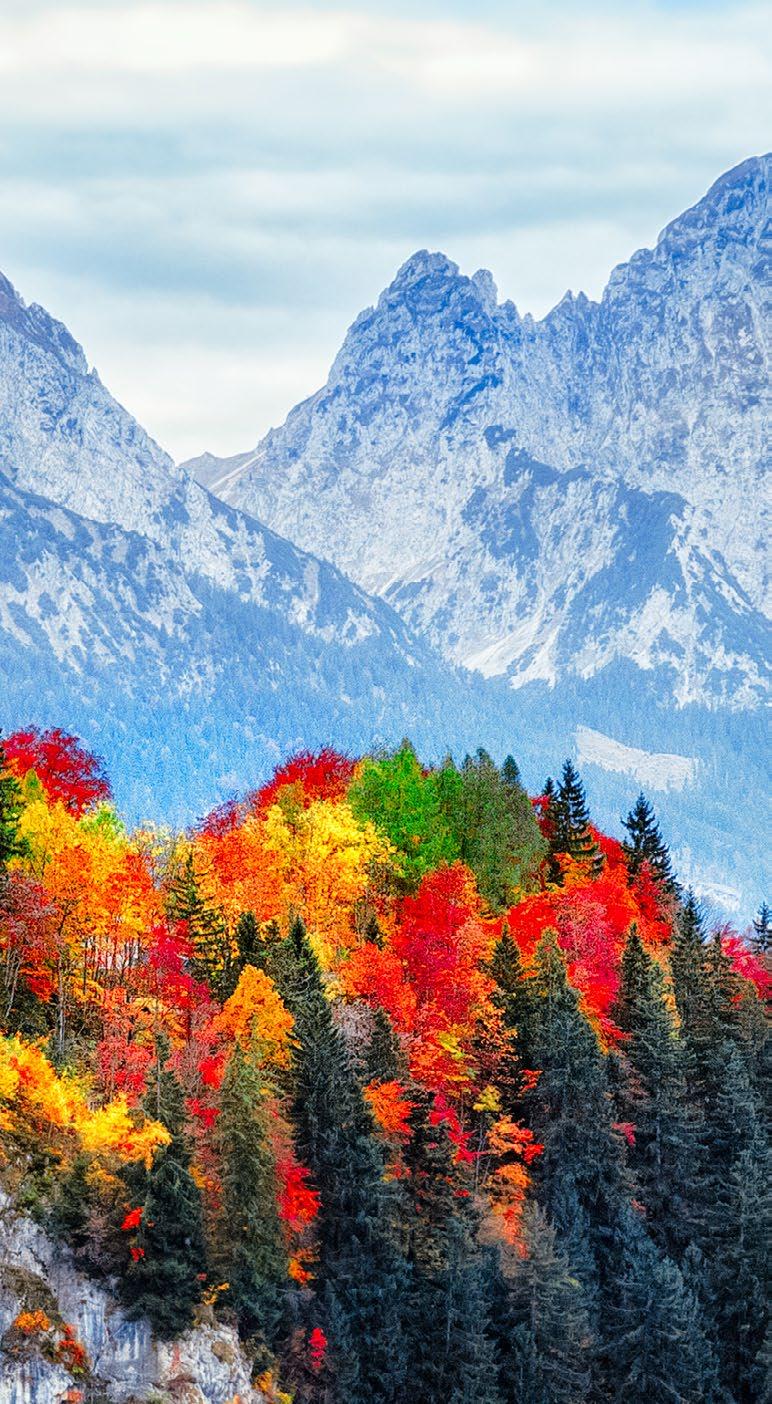
57 VOYAGER 9/2017
BERLIN – UNIQUE FREEDOM
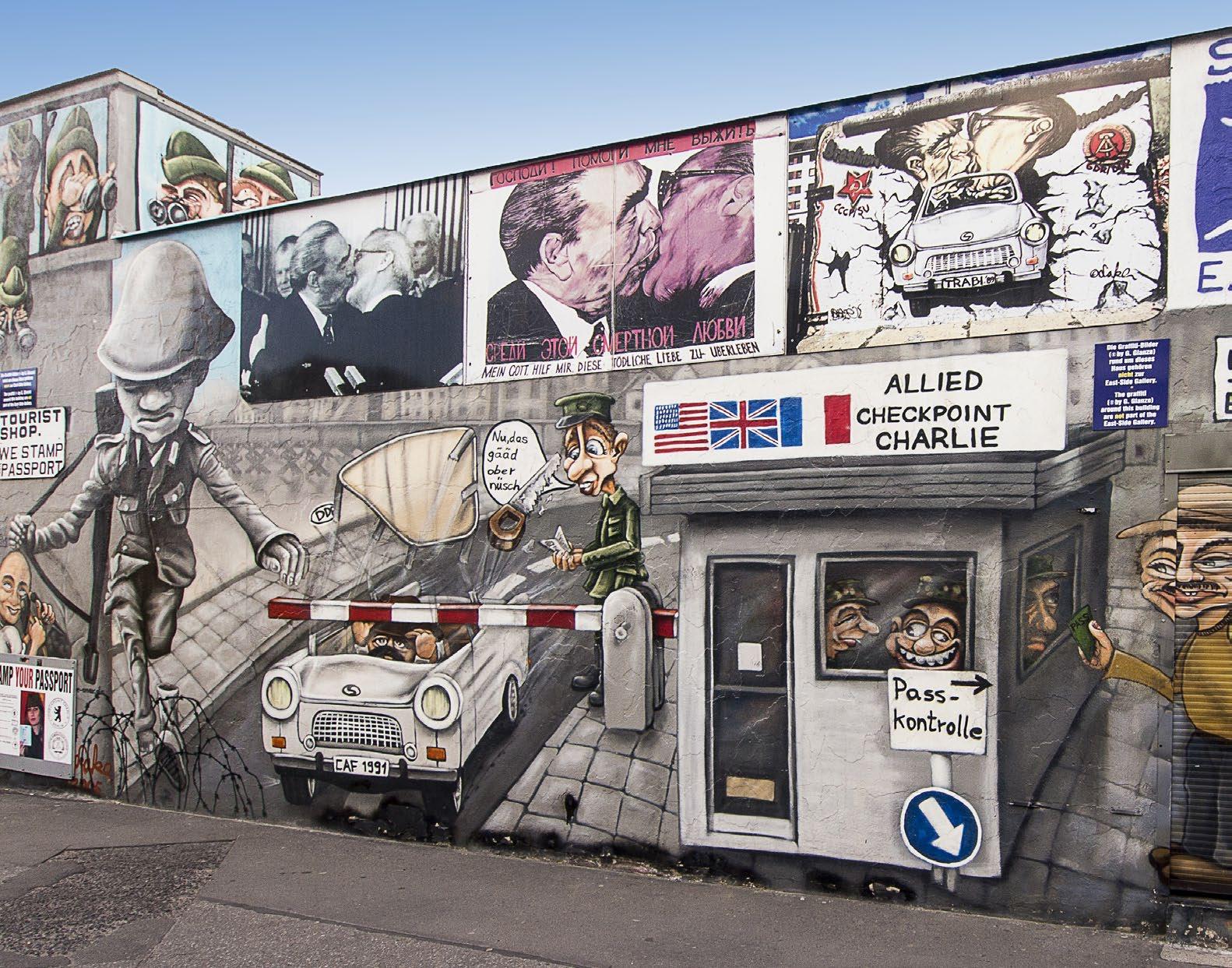
This is Berlin – pleasant and humane. The most important thing in this city is freedom. The most important thing in Berlin, whether you come by train or fly on a plane is the feeling of freedom that quietly surrounds you, as if in the air. This feeling of peace comes via the guard who knowingly rolls up the tobacco, the unimpressive bags and luggage lined up in the bus, or the overwhelming majority of young people – this is not surprising as Berlin is a city of youth – though that’s not the reason for its freedom.
The city, split in two by the infamous wall for almost half a century, has a grand history. This history has the monumentality and uniqueness of other European capitals, though the modern Berlin does not aspire to such things. Somehow Berlin, destroyed during the last big war and divided into four, just like the rest of the Germany, developed in an exceptional way and its movement and breath does not remind you
of anything found in the other European capitals. Today it is fashionably known for its leftism and entertainment for young people, though it has to be noted that both were present here before Hitler. In fact this story of freedom began right after WWI. However, it was short-lived, since those who then owned Berlin and attempted to own the world loved neither one nor the other.
To know what you will see in Berlin, you should first know what you won’t see here. You won’t find men dressed in thousand-pound suits with briefcase in one hand and a sandwich in the other, running like crazy after a train to arrive in the City of London on time. Neither will you find three hundred men queuing for taxis, characteristic of Parisian stations, or street thugs trying to pick out foreigners in the crowd and give them a golden ring to involve them in a famous fraud. You won’t find the carefree clerks of Athens, mopeds stuck in the traffic
CITY 58 VOYAGER 9/2017
AKA MORCHILADZE
like in Rome, the mood of midnight Madrid or summer siestas, the expensiveness of Copenhagen, the silence of Zurich, the wetness of Brussels or the snapped tourism of Amsterdam either. All of these belong to other big cities.
Berlin is a big city – a great city – with old imperial breadth and plazas, legendary buildings, deep history and characters, amazing museums, old alleys, massive shops, expansive transportation and people of different nationalities – but it is still very different. It is as if it has a secret urban magic. Tourists are not necessarily drawn to the famous Berlin sites but to the everyday life of the city. Living in a modern-day Berlin is the city’s main attraction and every little story, tobacco kiosk, flat schnapps bottle, Chinese card store, Italian cafe, Berlin doner shop, jacket bought for cheap, boxful of watches on the flea market and journey through a bookstore has a distinctive taste and smell. Its mundane city noise is not something that our ears are accustomed to.
The famous and exemplary greenness and comfortable, relaxed and organized way of life in the city, and its tranquil
pace, as well as the quick pace of the city and the comfort of the buildings erected after the world war, not forgetting the beauty of the buildings that were not destroyed, all yield to the distinct sound of church bells – something that is often swallowed up in cities this big by life or by blaring car horns. Planning and building a city is not just about creating an attractive façade but tailoring the city to its people and providing a pleasant existence.
Since its unique freedom is the main thing in Berlin, not surprisingly everything has a distinct taste and everyone has to look inimitable. We should know that dressing up has nothing to do with it. Berlin is the least dressed-up city. Now they claim that its casual look has become its main trend and attraction, though the city really does not spend much time thinking about that.
Yes, many things originated here. Berlin has a specific laborer-student soul right here, and the best thing about this soul is that it is very urban – it befriended art, and rarely is there something sweeter for a person who appreciates such things. This soul has been around for more than one hundred years and today it is developed and adjusted to the whole city life. It demonstrates a very good unity of German cities’ immortal working–class soul and politics and technology as well as German story-telling and thousands of other things.
The resulting mix is unique in the world. It is hard to display riches in Berlin and it would be a faux pas to try. There was a time when there was nothing to display. In general, the city is led by the laborer-student soul – no diamonds shine here. So many things are for free here too, which is unimaginable anywhere else. Please, come, see, look, everyone! The fifteen-yearold city slogan – Poor but Sexy (“Berlin ist arm, aber sexy”) –still fits the place. In addition, it is a city open to music, art and nightlife, where parks look like forests and the famous German cars don’t bother you.
Berlin’s freedom is not a freedom supported only by legislature. This can be found in Liege, Birmingham, Odense, SaintNazaire and Huelva. It is more created by everything and everyone: common people, people with taste, clerks, characters, art, the big war which destroyed all of these... and probably thoughts about the future. The latter is perhaps just the end of the amazing Berlin soul creation, but nothing would exist without it and it would not be so attractive without it.
Years ago, when the wall was demolished, many cards were sold near Alexanderplatz with transparent capsules labelled “Berlin Air”. I don’t know if such things sell well. Theses souvenirs later appeared in many other cities and countries and became a cliché image. Though at that place and at that time, it was real. It meant that the air of the united Berlin was the air of freedom.

59 VOYAGER 9/2017
BERLIN MYTHOS
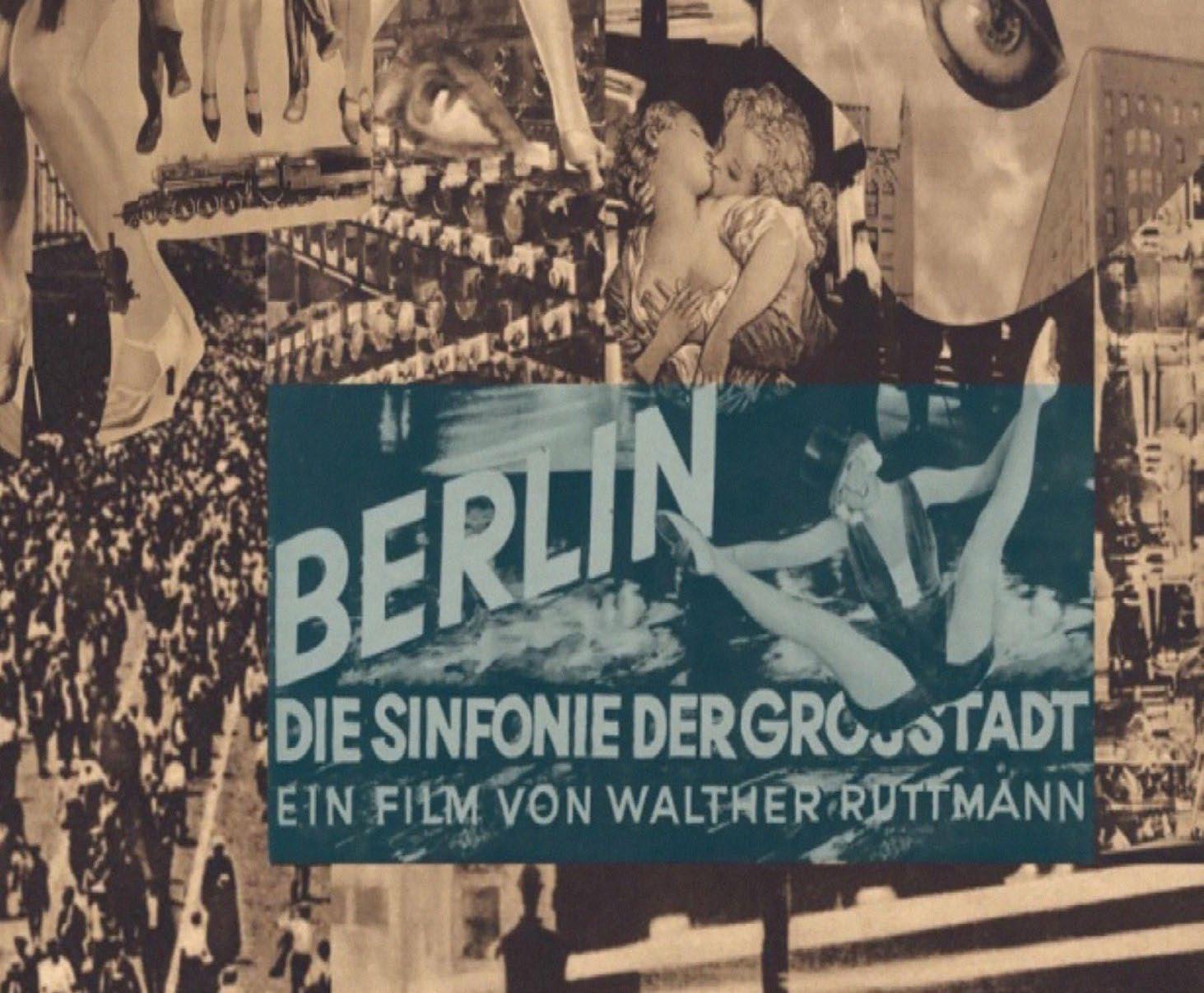
MAISURADZE
According to an old interpretation, mythos is something that has never happened but is always happening. The magic power of mythos is determined by a paradox: mythos does not depend on real events. It creates own reality, which becomes more alive and believable than the facts. Facts create history, making it possible to remember the past, while mythos creates eternity that always exists in the present. No realism can take the magic away.
Berlin mythos was created in the 19th century, an era of rationalism. It was devoid of the epic and heroic content, neither did it encompass important events. According to one account, in 1870, when recently united Germany became an empire, Chancellor Otto Bismarck was against making Berlin the capital. He claimed that Berlin was not a city but a refuge
for apes. This was due to the cultural diversity and various revolutionary forces in the city. Berlin mythos was crafted by contrasts: a center of imperial power, with military and police apparatus, and at the same time a revolutionary underground with students who sought to change the world, radical theatre and a most immodest bohemian crowd.
STYLE
GIORGI
60 VOYAGER 9/2017
When Berlin became the empire’s capital, siegessaule (victory column), a huge pillar with the goddess Nike on top was erected in Tiergarten, a gigantic park in the center of the city. Statues of famous German writers, artists, scientists and politicians were erected there. The newly united Germany deemed itself a county of poets and thinkers. This 19th-century designation was altered by Friedrich Nietzsche, a German philosopher who predicted a world-scale catastrophe as a result of German nationalism and imperialism. His sentiment was shared by Karl Kraus, an Austrian publicist, who witnessed the Third Reich and a world war, initiated by Germany. They claimed that Germany was a nation of judges and executioners.
The park, home to statues of the most prominent representatives of German culture, is the biggest cruising area in Europe – a place where people meet for anonymous sex. Jean Genet’s “Funeral Rites” tells a love story between a Gestapo executioner and a 15-year-old Hitler youth member in 1935 Berlin, a time when homosexuality was punishable in Nazi Germany. Their romance begins in Tiergarten.


Sexual freedom is the hallmark of Berlin. The notion of sexual revolution originated here. Its leader, psychoanalyst Wilhelm Reich, began a political movement in Berlin, aiming to educate the public, especially the underprivileged. Reich believed that free of repressive sexual morals and old wives tales, people would avoid neuroses and perversions and, as a result, authoritarian ideologies and regimes based on violence and hatred would lose support.
Berlin was synonymous with sexual decadence during the Weimer Republic (1918-1933). At this time, Germany’s capital became the center of the world’s nightlife. It attracted lovers of fun and carnal adventures from all over the world. This period was described in multiple literary and film works, a good example being Christopher Isherwood’s “Good-bye, Berlin” as well as “Cabaret” by American director Bob Fosse, based on the same book. Belin’s bohemian crowd did not attract only those thirsty for sexual freedom but also the most revolutionary-minded, socially conscious artists. Bertolt Brecht and Kurt Weill created the “Threepenny Opera” and “Rise and Fall of the City of Mahogany”. Berlin was one of the centers of European modernism.
61 VOYAGER 9/2017
SEXUAL FREEDOM IS THE HALLMARK OF BERLIN. THE NOTION OF SEXUAL REVOLUTION ORIGINATED HERE.
When Hitler and the Nazi party came to power in 1933, the mythos of Berlin as an artistic and free promised land was over. Under the Third Reich, the capital became the center of world-wide suppression. An unprecedented action took place that year: students, poisoned by Nazi ideology, burned books unacceptable to the regime. Among those books burned in the university yard were classic literary and philosophical works of German authors. The Nazis began destroying everything that was unique in German culture. Firstly, they attacked cafes and clubs, then wrecked German modernist works of art. Hitler’s plan was to destroy the city and build a new one in its place, called Germania.
A two-part city emerged as a result of WWII. The wall, built in 1961, turned Berlin into two radically different cities: East Berlin was under Soviet influence, the center of power of the Democratic Republic of Germany, while West Berlin became
an island of political, cultural and social freedom. To keep West Berlin populated, the Federal Republic of Germany established incentives for the Berliners. This prepared ground for the mythos of Berlin as a city of youth, leftist activists, emigrants and alternative culture. The Berlin of that time seemed more like a mythical place than a 20th-century European city. Polygamous communes were often established in West Berlin in unoccupied houses – abandoned dwellings where people lived without paying rent. These communes were free of worries about limitations, work stress, success and career.
West Berlin became a center of utopic freedom, where everything was allowed - sex, drugs, everlasting fun and a life free of all bourgeois rules. Here you could be poor, but happy. The culture created in this city was a flourishing counterculture. The Berlinale film festival was founded in 1951 and managed to hold on to its status as the biggest independent film festival until the end of the century. The wall was destroyed in 1989. West Berlin’s spirit then spread to East Berlin. Abandoned buildings were taken over, not only to live in but as art spaces, galleries, theaters and clubs.
By the end of the last decade of the 20th century, before Berlin took back its title as Germany’s capital, it was known as the world capital of techno music and clubs. Techno music culture originated in the western industrial/post-industrial world. In the beginning, it was thought of as a means of entertainment and self-expression for youth, and it used abandoned factories as a source of inspiration. Berlin was an ideal environment for this counter culture. With the wall gone, whole chunks of East Berlin were abandoned. Techno clubs opened up in former warehouses and factory buildings. One of the first clubs opened in the Nazi Germany treasury building. It is still functional and is called Tresor.
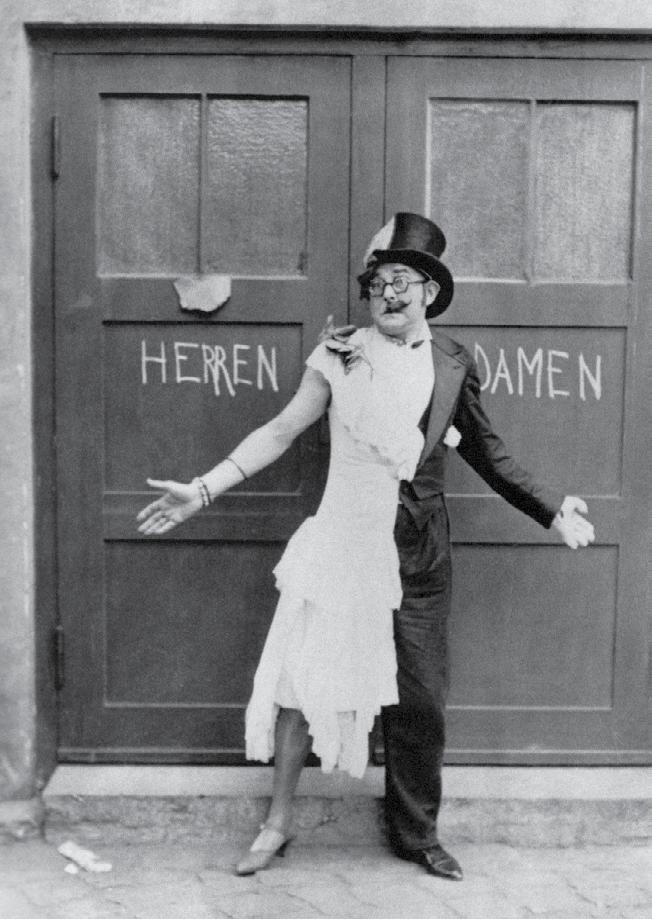

STYLE
62 VOYAGER 9/2017
AT THIS TIME, GERMANY’S CAPITAL BECAME THE CENTER OF THE WORLD’S NIGHTLIFE. IT ATTRACTED LOVERS OF FUN AND CARNAL ADVENTURES FROM ALL OVER THE WORLD.
Love Parade was the world’s first techno parade. The inaugural edition took place in 1989 in West Berlin, where 150 people danced to loud techno music that poured from speakers mounted on trucks. The organizers claimed that the parade had a political manifesto, though their only message was ecstatic body movements. Ecstasy, amphetamine, speed and MDMA accompanied the parade. Coupled with traditional marijuana, this created an alternative psychedelic culture. By 1999, Love Parade counted 1.5 million participants. Berghain was opened in 2006, one of the biggest and most popular techno clubs in the world. Drug, alcoholic and sexual endeavors are not only allowed but also ideally organized in this four-story giant. The pleasure is offered before the desire is formed. However, this seems merely an imitation of extravagant 1990s Berlin culture.
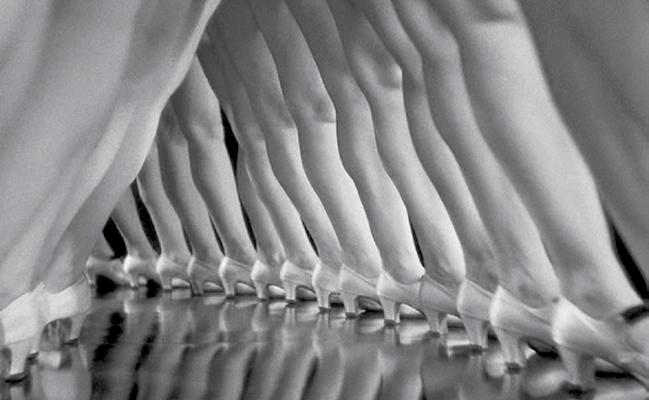
In general, Berlin is now an imitation of itself 20 years ago, when the city became the hipster promised land. Techno
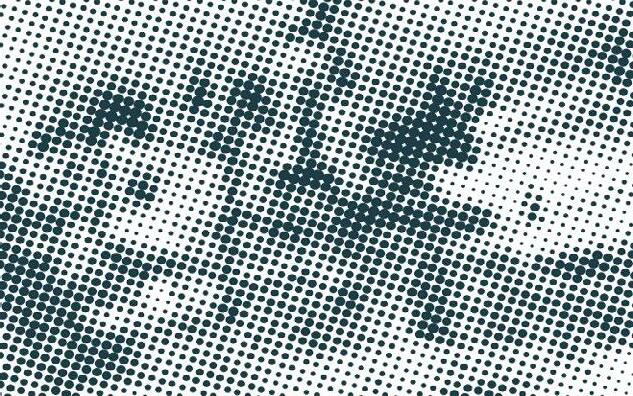
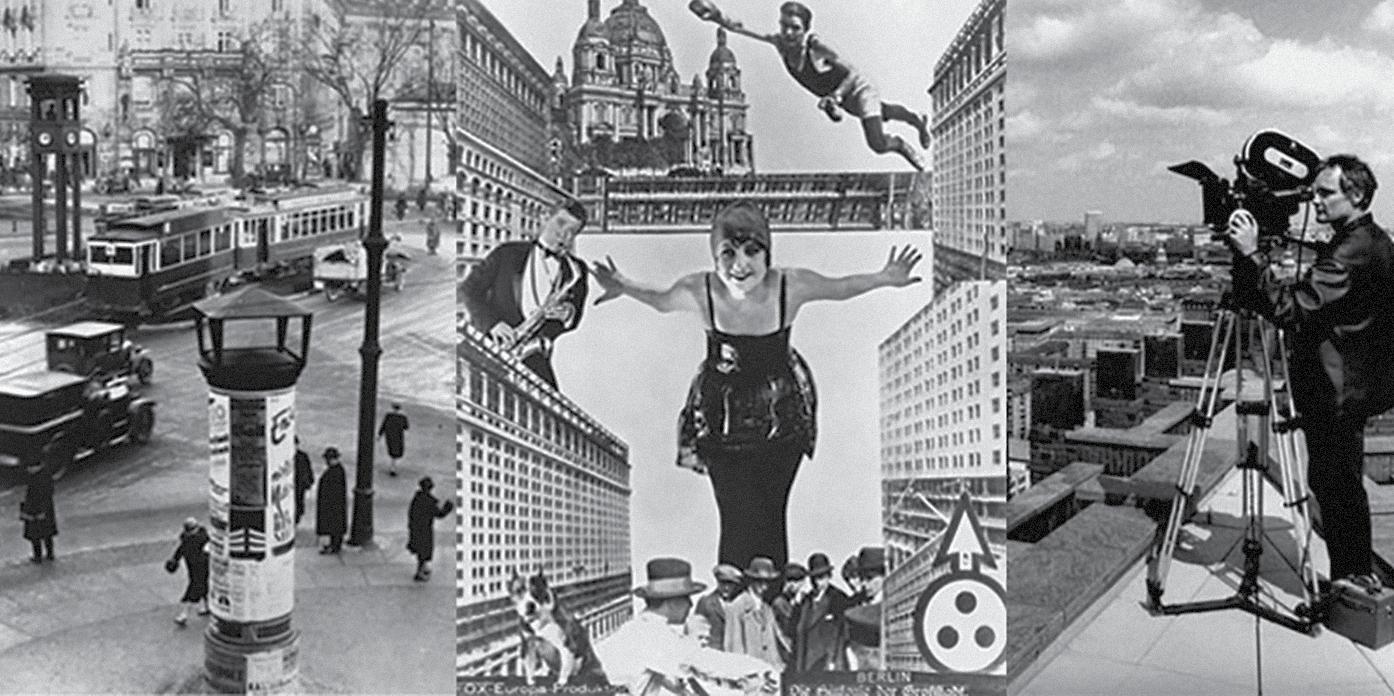
music and the aura of counter culture have diminished with commercialization and gentrification. Berlin’s aura was based on the unreconciled contrast between it being a power center and having a parallel subversive culture. This used to be an inexpensive city due to cultural and social diversity and a strong proletarian subculture. All the cultural movements and forms that originated in Berlin were fueled by un-German chaos and spontaneity. This is what Berlin used to represent, and still represents, to some extent. Primarily, Berlin is a unique place where different cultures and social strata coexist. Everyone is emigrant in Berlin, and everyone feels home here.
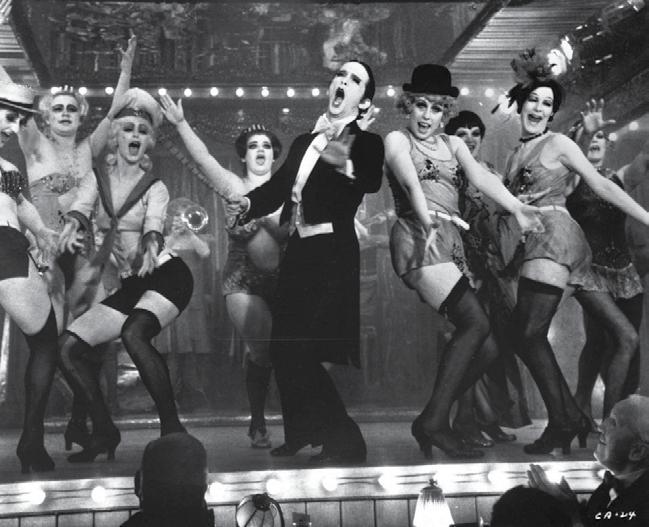
63 VOYAGER 9/2017
WEST BERLIN BECAME A CENTER OF UTOPIC FREEDOM, WHERE EVERYTHING WAS ALLOWED - SEX, DRUGS, EVERLASTING FUN AND A LIFE FREE OF ALL BOURGEOIS RULES.
SPECIAL EARS FOR THE WAGNER FESTIVAL
BUGADZE
1.
Apart from its unique acoustics, the Bayreuth Festival Theater is known as the theater that was constructed to perform works by a single composer. The bearer of such a concept and basically the architect was none other than the composer himself – the great egoist, theoretician and practitioner of the “Music of the Future” concept, and the author of ingenious musical dramas and mystery plays the likes of which have never been heard before or after him, the great demagogue and an idol for many – Richard Wagner.
In the early 1870s, Wagner simultaneously tackled two enormous tasks: in parallel to writing his grandiose tetralogy, "The Ring of the Nibelung" (which was to be performed over four evenings), he, together with the architect Gottfried Semper, was constructing a festive theater for the performance of his "musical dramas".
The Bayreuth Festival Theatre was to bring Wagner's philosophical-art concept of Universal Artwork “Gesamtkunstwerk” to life.

Wagner achieved all of his hard-earned victories that would lead him to his “Green Hill” (Bayreuth) via such battles and eccentric self-confidence previously unknown in the history of culture. The primary reason for his victory was his music, which was to change, not probably the world, but at the very least human ears – or the pre-Wagnerian habit of perception of art. For him, music was not only about aesthetics but also an instrument to describe the mysteries of this universe. This is why he had such devoted followers as Nietzsche and Bodler, Liszt and Renoir, the strangest of the kings - King Ludwig IIand many others, whose sound perception organ – the ear – changed gradually thanks to Wagner.
2.
"Richard had a rough night," "Richard slept well", "Richard woke up in the middle of the night", "Richard had spent a restless night", "Richard was woken up by headache".
These are the words that are repeated the most frequently in the diary of Wagner's wife, Cosima.

Cosima Wagner began writing her diary on January 1, 1869 several days after the birth of her son, Siegfried, and went on to write it for 14 years until Wagner's death on February 13, 1883.
Wagner died in Venice while standing in front of a mirror, fixing his bowtie. His last words were: "Mein Uhr" ("My Hour"); on his desk he left an unfinished article: "On female origin in art..."

ART
LASHA
64 VOYAGER 9/2017
Richard Wagner, his wife Kozima Wagner, composer Franz Liszt, Morris Rosentha
Cosima, with her five children and her husband's coffin, returned to Bayreuth, where Wagner had founded his music festival a few years earlier. Cosima's father, Franz Liszt, dedicated the musical piece "La Lugubre Gondola" to Wagner’s funeral procession.
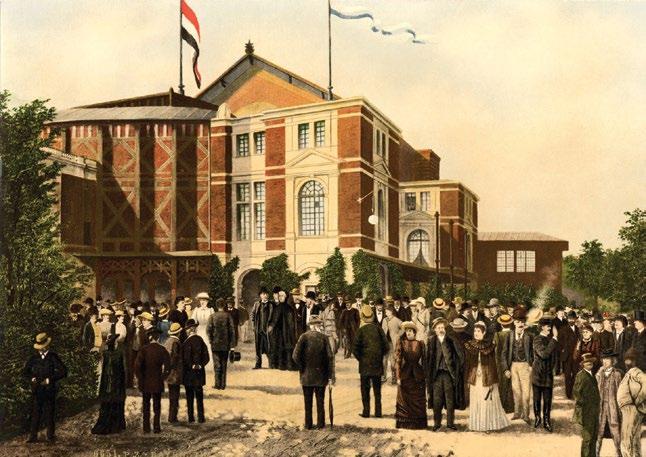
Cosima buried her husband in the garden of "Wahnfried" villa and began running the Bayreuth festival - the grandiose creation of her husband's last years. Cosima treated everything concerning Richard Wagner’s world view, name, biography and creative work with great delicacy. When, following Wagner’s death, her dying father visited Bayreuth, she did not bring him to Wahnfried but rented him a house and hired him caretakers and servants there. She explained the reason for that herself: If Liszt was to die in Wagner's house, "Wahnfried" would be associated with his name as well, while Richard Wagner should have been the sole owner of Wahnfried’s history. It should be noted that her father accepted his daughter’s argument with calmness and no complaints and quietly died “near” the Wagners.
She was not always like that – before starting her diary, she was entangled in a plot more befitting a Verdi opera than Wagner’s, though this whole “Italian Opera” concluded with her marrying Wagner.

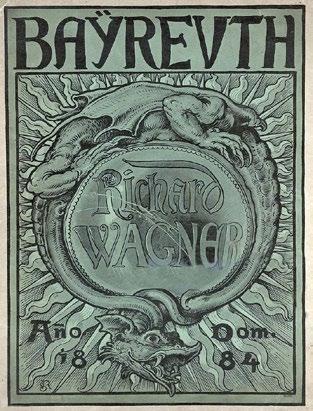
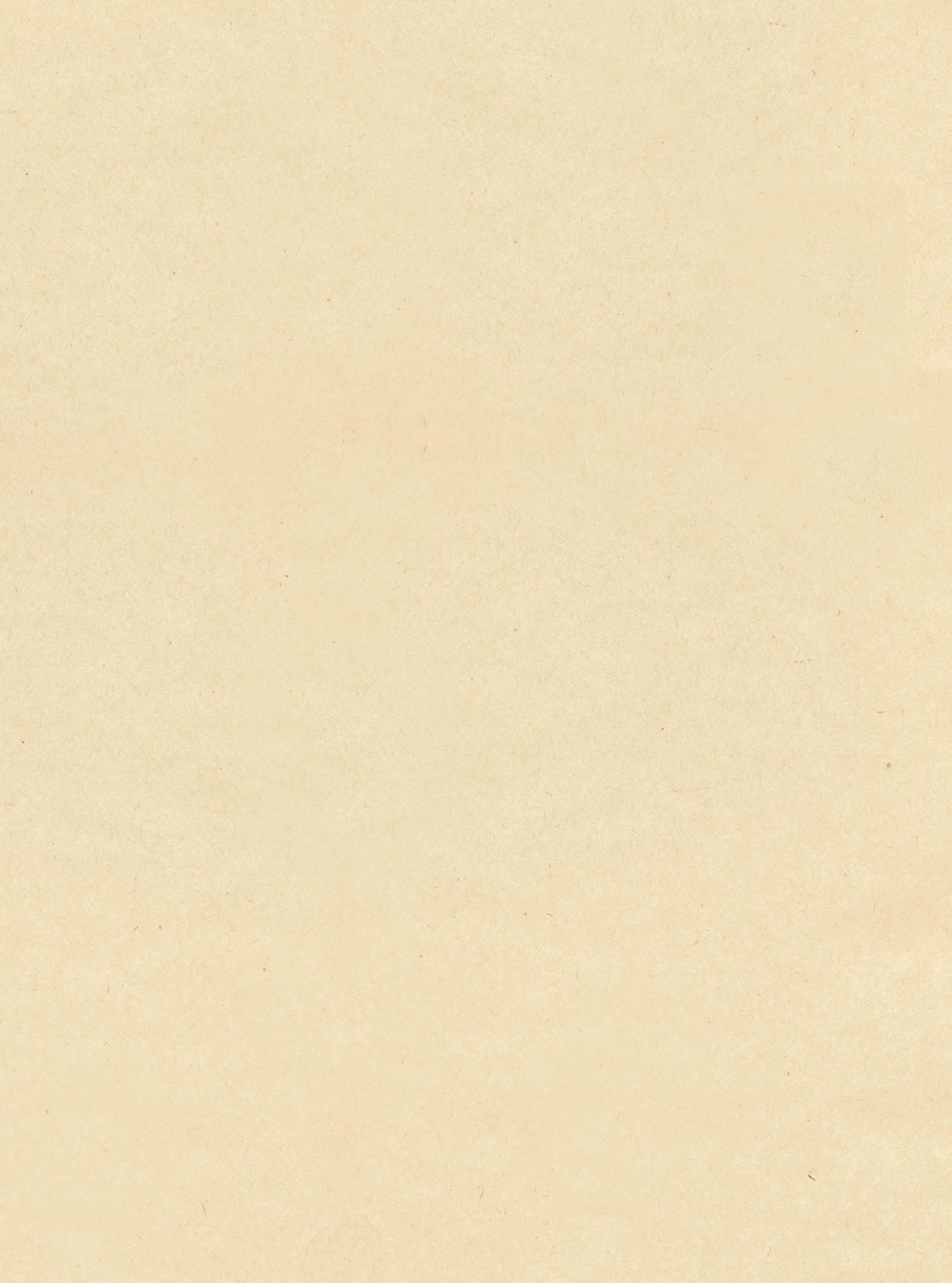
Hans von Bulow, Cosima’s first husband, was the greatest conductor of the 19th century, the founder of the Berlin Philharmonic Orchestra and the foremost promoter of Wagner's operas; however, unfortunately for Bulow, his musical idol fell in love with his wife.
To tell the truth, this was not the first time that Wagner found himself in such an awkward situation: years before he fell in love with the wife of his friend and financial backer, Mathilde Wesendonck (basis for Isolda from “Tristan”). Unlike the previous occurrence, Wagner no longer wanted to be the illegitimate lover – Tristan – and unwittingly found himself in a story worthy of Italian opera, which he greatly despised. On one hand, he did not want to lose a loyal conductor (for he loved this man as much as a wife, or maybe a tad less) but on the other hand, he could no longer live without Cosima. The chorus of gossip reached Von Bulow but he did not worry: he could have believed in Cosima’s betrayal but never in the betrayal of God (Wagner) himself. Wagner had asked his chief savior and admirer, the young king of Bavaria – Ludwig II –to save his dignity and that of the Bulows. The king, though, was unable to create a law against rumors but publicly stated that such “tactless presumptions” made him feel insulted in the place of the Wagner-Bulows. But in the end, the king himself was left heart-broken, if initially he had no doubt that the composer was innocent as the Lohengrin Swan, as one day it became apparent to him that Wagner was having an affair with conductor Bulow’s wife.
After the break-up of the family, Bulow, betrayed by his “god”, quickly left the new Wagners but his musical atheism did not last for long: Wagner soon returned him to Munich as he was
convinced that no one could conduct his musical dramas better than this man. Even though Bulow felt terribly insulted, he came back because he knew exactly that the only thing that would pick his spirits up would be Wagner's music (though without Wagner himself present). No, Bulow was definitely not weak or devoid of principles – the whole united Germany knew this man as a fierce, dauntingly high-minded speaker with high moral principles (feared locally almost as much as Bismarck). It was just that Wagner possessed magical abilities to charm – it always ended with his victims feeling guilty rather than the other way around. Wagner came out righteous in any case.
The same thing happened to the philosopher Friedrich Nietzsche, did it not?!No, no, he did not have a wife; in this respect, he survived Wagner, but he had plenty of existential causes to be offended. Originally, he was Wagner’s supporter and friend (he read his philosophical masterpiece - "The Birth of Tragedy from the Spirit Music" to the composer himself) and sat full of admiration at the first Bayreuth festive next to Tchaikovsky, who was terrified by Wagner’s music. However, later, when he read the libretto of the composer’s last opera-mystery “Parsifal”, he unexpectedly became an enemy of his old idol and three years after Wagner's death published a malicious and strange book, "Nietzsche Contra Wagner ("Nietzsche against Wagner "). In this book, sincerely, or just to spite the Wagnerians, he shouted for all the world to know that he found the truth in Bizet’s “Carmen” rather than in Wag-
65 VOYAGER 9/2017
Bayreuth Festival
Ludwig was brought up on Wagner's operas, and the first thing he decreed after ascending the throne following the death of his father was to bring Wagner to Munich. He wrote that Wagner’s suffering would come to an end and that from now on he would protect the composer and Wagner should be thinking only of music...
3.
When Cosima Wagner passed over ninety, her son, Siegfried, took over the management of the festival. Siegfried died soon afterwards. As a result, the festival management was overtaken by Winifred Wagner, Siegfried’s wife of English descent. These were the hardest times for the Bayreuth festival. Winifred befriended Hitler (possibly even loved him) and sometimes the "Wolf" (Hitler's nickname) chose the conductor and singers for her. Hitler is said to have admired the tenor Max Lorenz the most, and publicly criticized Siegfried Wagner – according to him, the composer’s bisexual son had flooded Bayreuth with

ner’s music (apparently the “later” Nietzsche who authored the "Antichrist" could not forgive the "late" Wagner for transitioning from “Paganism” to “Christianity”). When he was already in Turin and little was left of his mind, he wrote Cosima Wagner a crazy letter where following the list of his new identities ("I was Buddha in India, Dionysius in Greece ...") he confessed to the composer’s widow that he was Wagner.
Wagner had suffered many defeats in his life due to a constant stream of homelessness and exile (Wagner was denied entrance to the German lands due to his participation in the events of the Dresden uprising). In times of deepest despair, he called himself the "Flying Dutchman", seeking death and peace, and if it was not for one very strange and fateful evening he would probably never have found his Senta or have created a musical Valhalla at Bayreuth...
After a long futile search, a frightened Wagner was visited by Mr. Pfizermaster, the secretary of the young king of Bavaria, and delivered his majesty Ludwig II’s letter along with a ring.


Jewish musicians. After the end of Winifred and Hitler's epoch, the half-destroyed Bayreuth theater (the Allied Airplanes razed Bayreuth to the ground in the same way as they did Dresden) was restored by Wagner's grandchildren, Wieland and Wolfgang Wagner. Today the festival is managed by Wolfgang’s two daughters - Katarina and Eva Wagner – who are often slated by the critics. Katarina stages scandalous performances – letting the "Meistersinger" characters run on stage with enormous masks of her great grandfathers: Wagner and Liszt. She rebukes the critics by the fact that she is not obliged to agree with anyone as to how to show her great grandfathers in her own play.
I cannot attest anything to that – her answer is not to be reprimanded ... to say nothing about her grandpas.
So, there is much debate around Wagner and the Wagners as a century and a half ago the 19th century was split into Wagnerians and anti-Wagnerians. And Bayreuth attracts numerous pilgrims who had their ears transformed by the desire to touch the universe of this musical wizard.

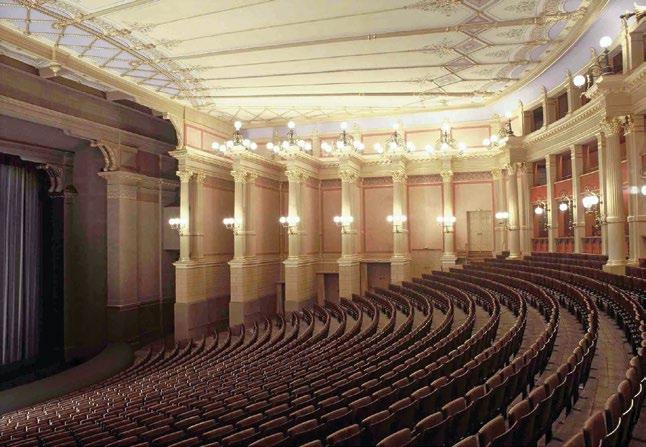
ART
Bayreuth FestivalTheater
WINIFRED WAGNER Widow of the composer's son Siegfried and close friend of Hitler. With Hitler and sons Wieland in Bayreuth, July 1938 Date
66 VOYAGER 9/2017
The garden of "Wahnfried" villa
GERMANY IS A FEDERAL COUNTRY, THE CURRENT CONSTITUTION HAVING BEEN ADOPTED IN 1949.
Germany is made up of 16 equal subject federal states (Bundesland), five of which were created in the East German territory and 11 in the West German territory.

Germany has three city-states BERLIN, BREMEN AND HAMBURG. The area of the smallest of them - Bremen - is 419 sq. km and has 657 000 inhabitants.
Baden-Württemberg is one of the most developed regions in Europe. After World War II, the semi-sovereign state was under French Protectorate. Only on January 1, 1957 did it become part of Germany as the 10th federal state.
20.3% of the German population (16.4 million people) have a migrant background, of which 9.2 million are German citizens and 7.2 million are foreigners (among them immigrants, foreigners born in Germany and people with an immigrant or foreign parent).
The largest ethnic minority in Germany are people of Turkish origin (3.5 million, of which 1.3 million are German citizens). The first generation of Turkish nationals arrived in Germany in 1961 as part of a workforce agreement with Turkey. The second largest group are the residents of the former Yugoslavia.
56% OF PEOPLE WITH A MIGRATORY PAST TODAY HAVE GERMAN PASSPORTS.
THE COUNTRY’S CAPITAL IS BERLIN
GERMAN FEDERAL STATES AND CAPITALS
Baden-Württemberg (Stuttgart)
Bavaria (Munich)
Berlin (Berlin)
Brandenburg (Potsdam)
Bremen (Bremen)
Thuringia (Erfurt)
Mecklenburg-Vorpommern (Schwerin)
Rhineland-Palatinate (Mainz)
Saarland (Saarbrücken)
Saxony (Dresden)
Saxony-Anhalt (Magdeburg)
Schleswig-Holstein (Kiel)
North Rhine-Westphalia (Düsseldorf)
Lower Saxony (Hanover)
Hamburg (Hamburg)
Hesse (Wiesbaden)
DIE BUNDESREPUBLIK DEUTSCHLAND
In German - Deutschland is associated with the old German tribal nameDiutisce.
Migrants contribute to the public and economic development of Germany. The federal government intends to promote immigration further due to the lack of specialists caused by demographic changes.
Today, German society is significantly impacted by demographic changes. The birth rate has been fixed at a low level since 1990: 1.4 children per woman on average. According to the study by the Bertelsmann Foundation, by 2050 the number of Germans of working age will decrease from the current 45 million to 29 million.
If immigration does not continue, the pressure on social insurance will grow, and above all, the pension system, which is based on the "agreement of the generations", will face challenges. This "agreement" means that the economically active citizens pay the pensions of those who cannot work anymore due to their age in the expectation that the next generation will provide their pension in return.
In Latin - Germania originates from Ger, Germani, Germanus, which should mean "neighbor" or "brother" in the language of Celtic tribe of the Gallaeci; STATE LANGUAGE - German RELIGION - Catholicism (31,7%), Protestantism (31,3%)
After the end of World War II in 1945, Germany was divided into four occupational zones. In 1949, the Federal Republic of Germany was formed from the American, French and British zones, and the German Democratic Republic was formed from the Soviet zones. In 1961, the Berlin Wall was built, which was demolished in 1989 as a result of the so called “Peaceful Revolution” led by a movement of the GDR citizens.
OFFICIALLY, GERMAN REUNIFICATION WAS ANNOUNCED ON OCTOBER 3, 1990.
DIE BUNDESREPUBLIK DEUTSCHLAND
67 VOYAGER 9/2017
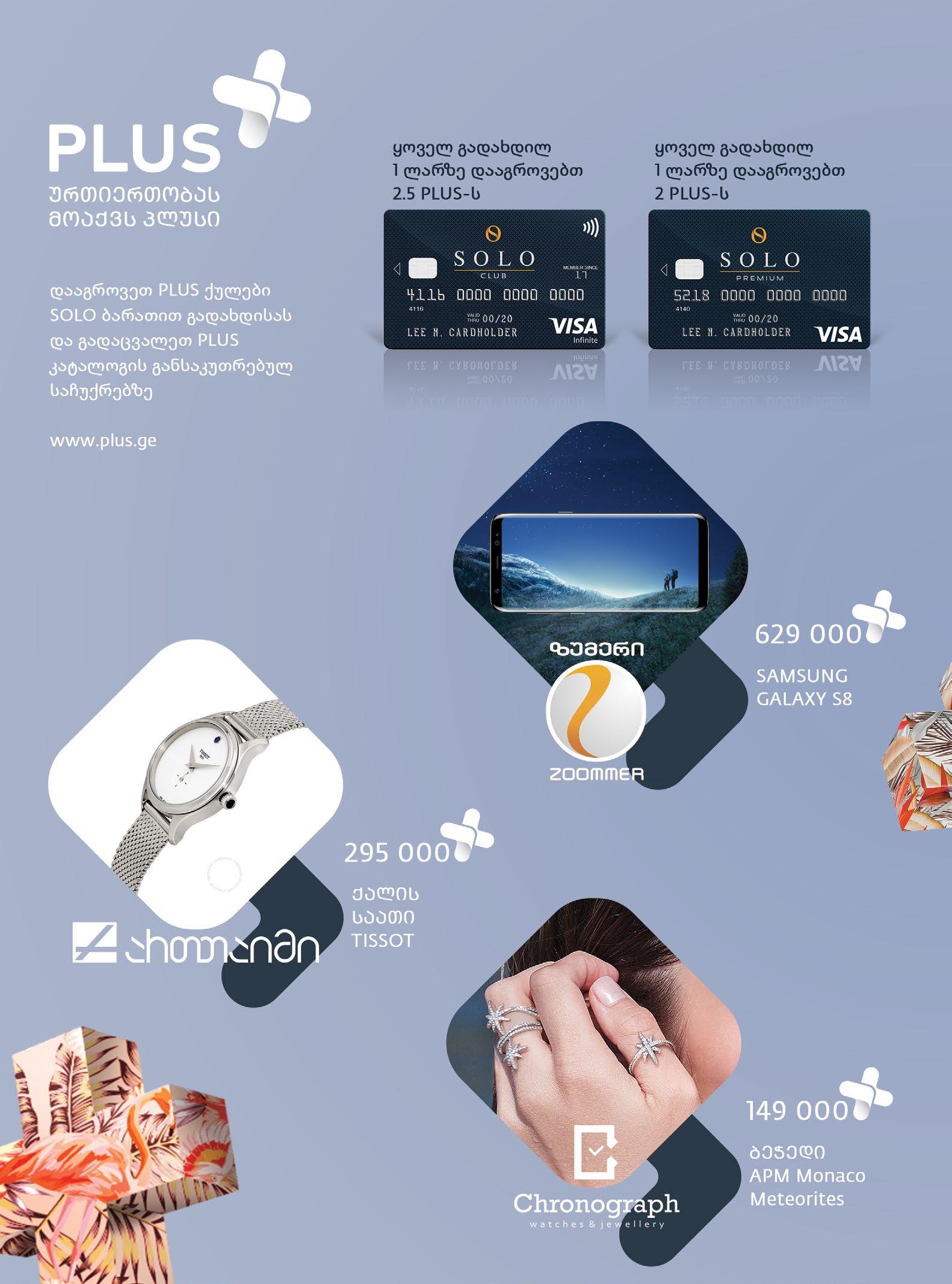



B O R JO M I
ADVANCED GERMAN
I AM AN ANTI-FASCIST... ANTI-FAUST
ICH LIEBE LIFE AND I ADMIRE CHAOS
ICH BIN TO WISH, GENOSSE OFFIZIEREN, DEM ZEIT ZUM FAUST FOR A WHILE SPAZIEREN.
Joseph Brodsky Two Hours in Reservoir
Several years after we had graduated from the “zero class”, Frau Marine, our German teacher, hung portraits of two classic German poets above the board – Friedrich Schiller and Johann Wolfgang von Goethe. “This here is the German literature”, Frau Marine said looking at the portraits (the frames were made by my Germanophile father), and she started teaching us “advanced” German. It was advanced because our school, the sixth school, was to teach “advanced” German. Those words, “advanced German”, sounded so poetic during the Soviet period and the textbook was called “Deutsch Intensiv”. However, the teaching was so “advanced” that many of us never got beyond the first five pages of the textbook. This upset Frau Marine right before our eyes.
Learning-wise (not the language though), I have nothing to complain about. Through my aunt’s unique puppet theatre (she created it from an old chair), I learned about “The Nibelung Saga” and “Doctor Faust”. Despite this literary knowledge, and to Frau Marine’s despair, my German never reached the level where I could understand every word in Schiller’s “Der Handschuh”.
Nonetheless, German literature has surrounded me for as long as I can remember – on the wall, above the blackboard, at home, on the shelves and even before the “zero class”. I did not know how to read but I counted the books that my parents read to me before going to sleep as the books that I’ve read. These were the tales by the Brothers Grimm.
For me, like millions of children around the world, German literature began with the stories recorded or invented by two philologists and linguists – Jacob and Wilhelm Grimm. Most children have heard, read or looked at the pictures in “Bremen Musicians”, “Sleeping Beauty’, “Hensel and Gretel”, “Wise Elsa” and the story about the never-ending porridge, “Stop, Little Pot!”
 LASHA BUGADZE
LASHA BUGADZE
LITERATURE 72 VOYAGER 9/2017
Installation of Dedication to Johann Gutenberg, Berlin, 2006
Every century has its great story-teller: the eighteenth belongs to Charles Perrault and the beginning of nineteenth (before Andersen) belongs to the Grimm brothers…
German literature begins with the fairy tale – the stories of the Nibelungs and man-gods in which heroes try to conquer their fears and the gods love and hate, just like their rival mortals…
My classmates and I learned about the German Middle Ages when we stayed in Tskvarichamia for the summer holidays. My father came to visit along with the other parents and he tried to entertain us “professionally”; we drew the heroic stories that he told us in the evening right on the sidewalk. Those were the stories about the knights of the round table. My father named me and my friends after the knights. We kept being referred to as Parsifal and Sir Lancelot until another dad came to visit; he was a big football player and divided us into “Liverpool” and “Juventus” instead.
The German poet Wolfram von Eschenbach wrote the poem “Parzival”’. He was the German “Rustaveli”. If we believe the historic sources, he wrote the poem at the same time as Shota Rustaveli wrote “The Knight in the Panther’s Skin”. Wolfram von Eschenbach was born in 1170 and Shota Rustaveli in 1160\65. This is not only a time coincidence but their two great poems are also interconnected contextually: both describe the process of searching and finding, and yearning for an ethereal but visible goal. Eschenbach writes about the quest to find the Holy Grail while Rustaveli writes about the quest for Nestan-Darejan (who is not in this world). Both images are symbols of encompassing love energy.
The knights of both poems undergo the same journey via different ways and forms: fighting their passions and cleansing themselves through love. These divine pursuits were described by two great Christian and European poets thousands of kilometers apart.
The German literary language originated due to the criticism of the western model of the Christian church. Literary German was created to translate the Bible. All of this started when one common priest placed “Ninety-Five Theses” on the doors of Wittenberg Cathedral criticizing the Roman Catholic Church. The author of the text was excommunicated from the church, resulting in the reformation. Martin Luther was that critical priest. According to the authorities in Rome at that time, he engaged in an unforgivable sin: translating the Bible into German for the German people. This was prohibited as Latin was the clerical language and translating the Bible into any other language was regarded as heresy. Luther believed that this official Latin was the reason why priests interpreted the New Testament as they wished and thus manipulated “common” people who knew no Latin.
Luther’s bible was the first book in the world to be printed using Gutenberg’s newly created press. It was the world’s first’s bestseller and the first book to be censored – the pope de -
creed that the German Bible be destroyed. Thank God, he was unable to do so.
Faust, the eponymous hero of the well-known tragedy, also translates the Bible into German. Johann Wolfgang von Goethe, the secret adviser of Herzog of Weimar, created this eternal character in his two-part work of art, a philosophical poem, in which the elderly Faust makes a deal with Mephistopheles…
While Faust’s “eternal substance” (soul) was saved from the “demon of destruction” (Mephistopheles) in the second part of the tragedy, Thomas Mann tragically and symbolically described the catastrophe of Germany making a deal with Nazism in his “Doctor Faustus”.
“Where books are burned, people will be burned also”- the poet Heinrich Heine wrote these words a century before the Nazis came, as if he was looking into the future. The Nazis burned his books during one of the first bacchanalia, along with those of other “impure German bloodlines” and “traitor authors” including Sigmund Freud, Heinrich Mann, Bertolt Brecht, Albert Einstein and Herman Hesse.
Post-WWII German literature explores the themes of guilt, the extreme absurdity of war and trauma. It is acutely apparent in the work of Gunter Grass, Heiner Muller, Hannah Arendt, Heinrich Boll and Peter Weiss.
Germany is the most “reading” country in Europe today; it hosts the biggest book festival in the world -- Frankfurter Buchmesse. Neither Frau Marine nor we could imagine in the far away Soviet past that Georgia would be acknowledged as the main guest of the Frankfurt book festival in 2018 and that the books written by those who used to carry the heaviest and the thickest textbook –Deutsch Intensiv – in their leather school bags would be translated and published in German.
Maybe that was the textbook of Nino Khatatishvili, a student of “advanced” German in Tbilisi German School. She is now a contemporary German author and her plays and novels (especially the thousand-page long “The Eight Life”) are astoundingly popular in Germany.
It is a pleasant and somehow unbelievable fact that every major bookstore in Germany sells Georgian books translated into German.
How can I not remember Frau Marine after all this? When she talked about Germany (which she had never visited), she did so in a romantic, amorous and ethereal tone:
73 VOYAGER 9/2017
„JA, MEINE LIEBEN, DEUTSCHLAND ERKENNT DER WELT DURCH BUECHER...“
THE LESS THE BETTER
NIKA CHKHAIDZE
The history of German architecture, as it would befit a country in the the center of Europe, embodies almost every style and direction that has ever existed, from ancient times to the Baroque period. Despite the horrors of wars over the years, the country has maintained the same spirit after reconstruction.

The German approach to simplicity and modernity and a simple perception of shapes originates from the the period of neoclassicism and the works of Karl Friedrich Schinkel. One of the authors of Berlin’s "Acropolis of Art" or "Museum Island", Friedrich Schinkel was the first architect in Germany to create a building with elements of modernism.
IN 1932, HENRY-RUSSELL HITCHCOCK AND PHILIP JOHNSON PUBLISHED “THE MODERN ARCHITECTURE”. FOLLOWING THE EXHIBITION AT THE MUSEUM OF CONTEMPORARY ART IN NEW YORK, THIS BOOK BECAME THE “BIBLE” OF MODERN ARCHITECTURE. IT “APPOINTED“ TWO GERMAN ARCHITECTS AS THE FOUNDERS OF THIS STYLE ALONG WITH LE CORBUSIER, THE FIRST AND THE LAST RECTORS OF THE BAUHAUS SCHOOL – WALTER GROPIUS AND LUDWIG VAN DER ROHE.
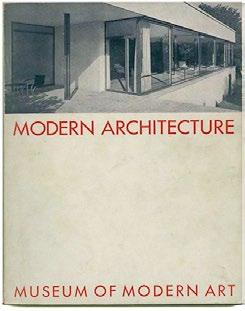
To experience the special refinement and elegance of Shinkel’s Neoclassic architecture in full, one should lie on the green esplanade in front of the Altes Museum.
It is a paradox that amidst the inflation, revolutionary storms and universal psychosis of the Weimar republic that sprung into existence in the period between the two world wars, German architecture managed to deliver numerous breakthroughs and played a crucial role in shaping modern architectural aesthetics.
In the 1920s, Berlin existed between the two poles of Paris and Moscow. The imports of Parisian cabarets and pastimes merged in Berlin with the avant-garde coming from the newly created Soviet republics. The economy was in a dire state but art was flourishing – painting, music, ballet and architecture were on the rise. It was an epoch of new ideas and bold quests. This was the time when three new directions of modern architecture emerged.
* Architect Ludwig's Van der Roe's saying - "The lesser the better," it expresses the essence of modern architecture.
*
ARCHITECTURE 74 VOYAGER 9/2017
Altes Museum
EXPRESSIONISM
The first breakthrough in German architecture happened in the frame of expressionism. Post-war art, especially painting, conveys its moods and the reality of life, and reflects it in the works with expressiveness and mysticism (Otto Dix, Max Beckmann, Max Ernst, etc.). The Soviet avant-garde, constructivism and the ideas of El Lissitzky greatly contributed to expressionism. Architects followed this style as well, for instance Erich Mendellsohn.
NEW REALISM
Expressionist architecture is expensive and difficult in execution, which brought about a change in direction at a later stage. With the influence of the Dutch avant-garde and De Stijl, a new movement emerged at the end of the 1920s – Neue Sachlichkeit (German for the Subjectification), which can also be translated as "New Realism". This architectural style was also based on concepts of Frank Lloyd Wright.
The idea at the center of the new “Neue Sachlichkeit” vision was the highest degree of practical functionality. It was radically different from complicated and "tangled" expressionism. It also had its roots in practical and political per-
spectives. Germany required restoration after the war. The "Housing Assistance Program" developed with American financial aid required functional, cost-effective and minimalist architecture.



In response to this challenge, German architects started working in the “New Realism” style. The Frankfurt Development Plan was created and numerous settlements were built in the Neue Sachlichkeit architectural style. A constant connection between industry and architecture was established. This was a revolutionary breakthrough that changed the aesthetic world view of many generations, though the following years temporarily stalled everything.
A special educational system was needed to formulate these new visual aesthetics and introduce the new forms and shapes. Bauhaus emerged to take on this role. Today this name is considerably more than just a small institution founded in Weimar. The organizational and architectural genius of Walter Gropius managed to gather legendary teachers at this school: Kandinsky, Mohai-Nad, Oscar Slamer, Paul Klee etc. The school had a significant impact on
German (and not only German) architecture and design of that period. In 1933, the school director was Ludwig Van der Rohe. The Gestapo closed the school down and Van der Rohe as well as Walter Gropius and other legendary "Bauhausers" moved to the United States. In America, they found ways to bring their ideas to life. The projects created there and their pedagogic activities contributed to the implementation of the modern architectural language.
BAUHAUS-ARCHIV/MUSEUM FÜR GESTALTUNG
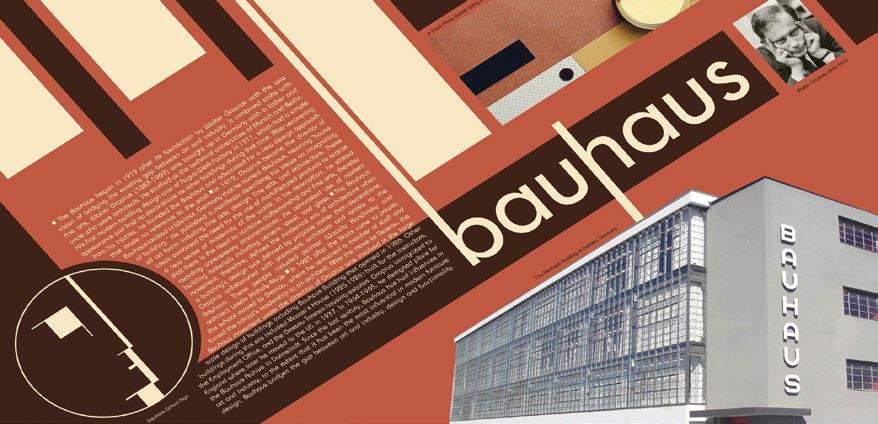
The Bauhaus School was established in Weimar in 1919 but by 1933 had been closed by the Nazis. This movement changed the perception of what kind of environment and objects should surround humans – starting from sugar bowls and ending with towns. The Berlin Museum is less of a design exhibition (though you can see armchairs and architectural models here) and more of a storyline about the revolutionary methods, ideas and professors of the Bauhaus school.
The building was created by Walter Gropius, the founder of the Bauhaus School.
Open: Monday, Wednesday-Sunday – 10 a.m. -6 p.m.
Admission price: Tuesday through Friday - 8 €, Monday, Saturday - Sunday - 10 €
Klingelhöferstraße 14
Der Einsteinturm, Observatorium
Wilskistrasse Berlin, Bruno Taut
paul heyse strasse 2 Berlin, Bruno Taut
BAUHAUS
75 VOYAGER 9/2017
THREE SPECIAL “BERLIANIAN” BUILDINGS
Berlin is a special case not only for Germany but for the whole world. Its architecture is a confrontation between the socialist and capitalist cities built on the site of the old imperial one. This scene creates a wonderful collage. In the aftermath of the fall of the Berlin Wall, the city reclaimed its role as a metropolitan flagship and a kind of “filter” of the avant-garde. Art streamed in from the Eastern countries, freed from Soviet censorship, seeping through Berlin. This function was partially retained by the city but it now takes on a more touristic outlook.
The reconstruction of the Potsdamer Platz / The "Sony" Center – The reconstruction of Potsdamer Platz is one of the best examples of post-war restoration in Germany. Helmut Jahn's "Sony" Center and the whole of Renzo Piano's quarter are enough to illustrate it.



On the other side, you will find the Karl Marx Allee, formerly Stalinallee - a universal example of Soviet Camp architecture. Its reconstruction took place in the 1950s. It is important to note that Herman Hanselmann - the architect of this project - was one of the great figures in world architecture who came from the avant-garde and moved to Soviet eclecticism.


76 VOYAGER 9/2017
ARCHITECTURE


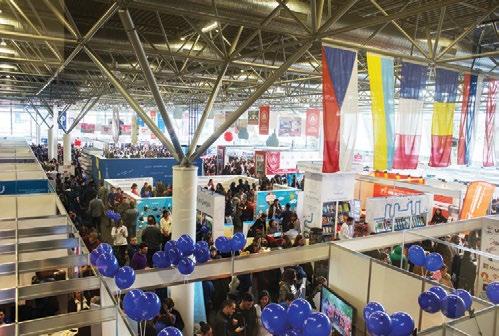



BUILDER OF THE FUTURE
SALOME DADUNASHVILI
Juergen Mayer H. is a supernova of architecture—he is a star that has changed many spaces in the world with a combination of free thought and moderate pragmatism. He grew the mushroom-umbrella “Metropol Parasol” in Seville and this artificial forest not only became a new, attractive infrastructural unit but part of the city’s structure. Georgia has witnessed several of his projects (Mestia airport, Sarpi border control building) – a testament to his fantasy and environmental taste.

Juergen Mayer H. has not stood still since he graduated from Stuttgart University and Princeton. His architectural company (founded in 1996) produces tens of ultramodern building projects per year as well as installations, objects and interior items. His works are not only exhibited in several museums but are stored as permanent collections. Among them are the
Berlin Kunst Library, New York MOMA, and Munich museum of architecture.
Juergen Mayer H. has a defined style; it is easy to identify his work. You can see his work everywhere in the World – the USA, Belgium, Germany, and Spain.
Among his works are the SCHLUMP ONE office and the university building in Hamburg, and the court building in Hasselt, Belgium. His multifunctional building at the Museum Garage has seven stories and four different facades. It will become one of the most interesting spaces in Miami this year.
Juergen Mayer H.’s company works in the whole world, though an increasing number of his projects are being carried out in Berlin. Mayer claims that he is becoming “more and more a Berlinian architect”.
INTERVIEW
78 VOYAGER 9/2017
How do you start working on a new project, what is necessary to draw that first line?
I have to study the environment and then determine the function of the building. In general, I support diverse urban space, I like different architectural voices and dislike full harmonization. Every city must have a specific architectural policy, though it should also include unique, different voices and these voices should have the opportunity to hold a conversation.
It is a very exiting process. I like all parts of the process – from the first client interview to viewing of the final finished project.
When you start working, you wish it to be the best project. Fantasy is activated. Then you watch the construction, and you see how your thoughts are materialized, though it used to be only an idea. All of these steps evoke special intuition.
Has your idea of architecture as a profession changed since you started working actively?
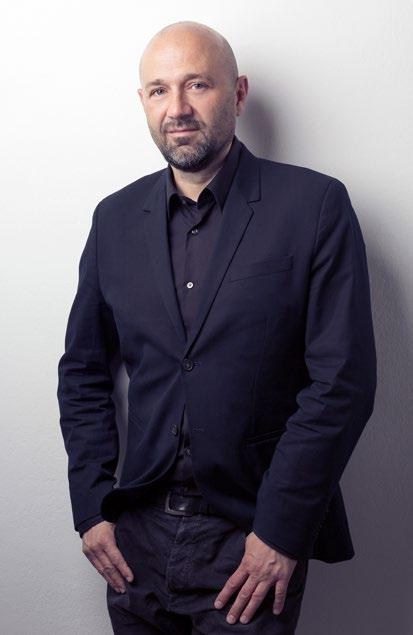
We are very lucky because we are involved in unique projects. We have clients who share our curiosity and creative approach. I did not expect that aspect of facilitation to be such an important part of architecture. Practically, we are managing an intelligent network of various specialists. As a result, innovative ideas become a reality via new technologies. This requires a lot of maneuvering. I have to regulate relations with contractors, which is not an easy or fun job but has to be done.
Which project was decisive in your career?
It depends on what part of my career we consider. The construction of a town hall in Stuttgart was my first big success. It positively affected the whole city – not only architecturally but also from an infrastructure point of view. Projects that I have implemented in Georgia were very important too. We placed them acupuncturally in different places in the country. It was interesting that the buildings that we built in Georgia are traditionally not understood as architectural projects but more as infrastructure, for example, the Sarpi border control building. We had the opportunity to give the building a different meaning and value. This was truly a unique experience. Currently we are implementing an institutional project and that is a different architectural direction. There’s always something new to learn and discover …
Are there modern trends in architecture?

Of course, there are various developments. New post-modernism is currently taking place. The fascination with novel technologies that was dominant for recent years is a bit in the background at this point. A more practical approach has come in its place. Formal historic tendencies and simple geometries are related in a more abstract form. Social message is important as well – architecture is now a form of activism. It also depends on the level of work that you do. Parallel fields of interest exist all the time – they draw more or less attention.
It is very interesting to observe how digital technology changes the design and construction process. Everything changes with the advance of technologies. For example, the streets that used to be noisy and polluted will become cozy and preferable for living as electric cars become more widespread. The
In general, I support diverse urban space, I like different architectural voices and dislike full harmonization.
79 VOYAGER 9/2017
Juergen Mayer H.
same goes for the riverbanks that we love so much. They used to be the noisiest places in the city. This results in the reevaluation of living quarters, which of course affects city development. This is a complex and multifaceted process.
Every generation has its own ideas of what contemporary architecture is. A balance has to be observed. For example, after WWII, they wanted to completely destroy everything old in Berlin and construct new, wide highways. They started implementing this idea but the next generation said that they did not require new highways and they wanted to protect certain historic places in the city. The 1980s brought post-modernist tendencies, followed by the reunification process and so on…
Mr. Mayer H., Berlin is a unique city. For years it was separated into two parts and both parts developed independently. How is Germany’s capital built today – is there an architectural unification policy?
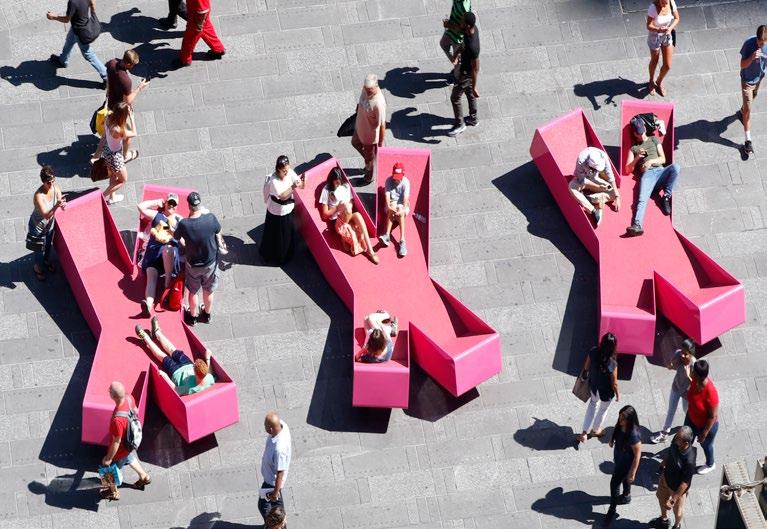
The first, wild exhilaration is of course over. Modern Berlin does not offer many open spaces and freedom in that way. The city is becoming more and more structured, expensive and conservative. The difference between West and East is still apparent, though finances were flowing to the East. I believe It is now time to pay attention to the West as well, since the infrastructure needs improving. Many open spaces, clubs, art studies and such used to be located in the center. This made Berlin alive. Now everything is understandably expensive, including rent; consequently, artists and their studios are leaving the center. Passive investors are in the way of development as well. For example, different types of financial groups have purchased many buildings and properties and do nothing for their improvement. Thus, unfortunately it is not as lively as it used to be. However, compared to many other European countries, Berlin is a much more open space. Regrettably, the artistic, open and bustling life is not what it used to be, though Berlin still holds on to the image. In general, everything is changing.
In what direction is Berlin developing architecturally?
We should remember that this city was lost and destroyed during WWII and architectural development could not ignore this. The main direction included rebuilding the city structure and looking for interesting urban and architectural solutions.

INTERVIEW 80 VOYAGER 9/2017
Most of what is being built today is very practical space. Some interesting and innovative projects took place of course, though that was more an exception to the rule. Berlin seems to be constructed according to the main trend of a pragmatic approach towards architecture.
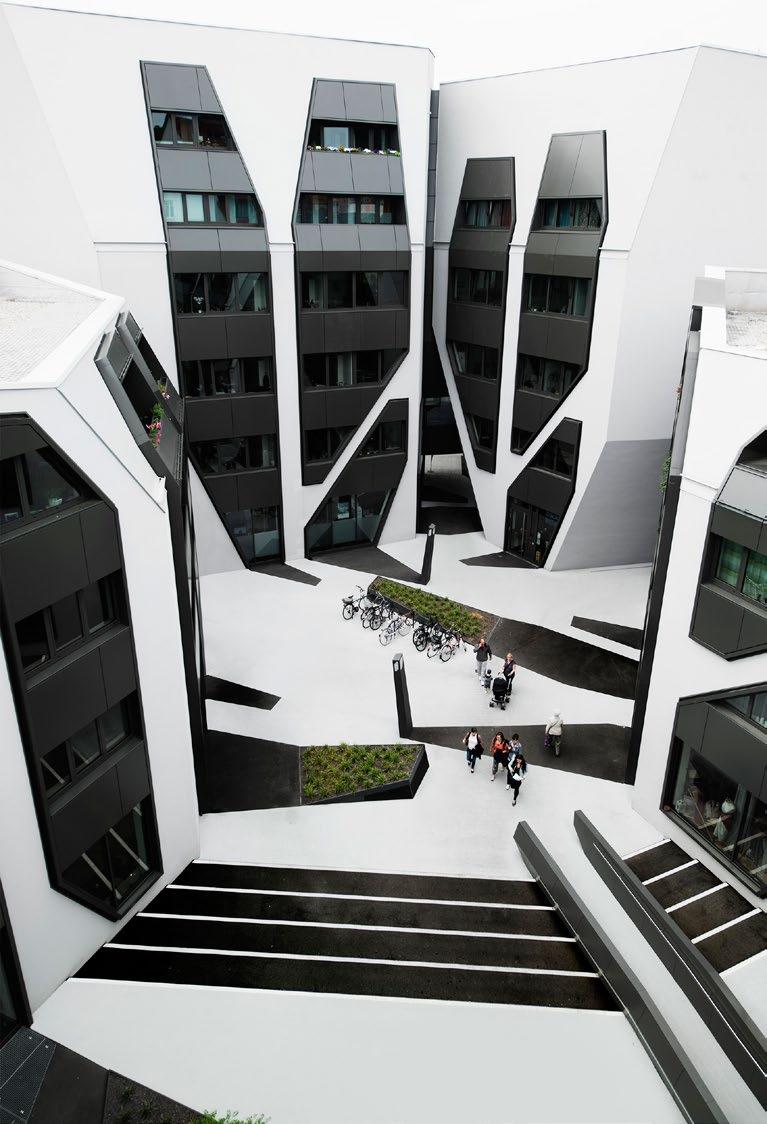
What would you recommend a person visiting Berlin for the first time should see?
I would start travelling in Berlin from west to east, from countryside to the city center and back out into nature. From Wannsee, via Bismarkstrasse, Strasse des 17. Juni, Unter den Linden, Alexanderplatz und Karl-Marx-Allee. Start with a visit to Wannsee Lake then drive east along Bismarkstrasse, then walk through the Tiergarten to the Brandenburg Gate; I would visit Unter den Linden, followed by the Stalin architecture district on Karl-Marx-Allee. The Neue Nationalgalerie is a very fascinating space. Unfortunately, it is closed now. However, it is Mies van der Rohe’s project and is worth a visit. If you stay in the “Bikini Hotel”, you will witness the beautiful Gedächtniskirche built by Franz Schwechten and Egon Eiermann. It is my favorite building in Berlin. Make sure to go inside. The daylight is replaced by unexpectedly dim lighting and the colorful stained glass is beautiful. It is truly a unique building. And when in Berlin-Mitte you might want to walk by our apartment project at Johannisstrasse 3.
JUERGEN MAYER H.’S COMPANY WORKS IN THE WHOLE WORLD, THOUGH AN INCREASING NUMBER OF HIS PROJECTS ARE BEING CARRIED OUT IN BERLIN. MAYER CLAIMS THAT HE IS BECOMING “MORE AND MORE A BERLINIAN ARCHITECT”.
When you start working, you wish it to be the best project. Fantasy is activated. Then you watch the construction, and you see how your thoughts are materialized, though it used to be only an idea. All of these steps evoke special intuition.

81 VOYAGER 9/2017
ELEKTRONISCHE DEUTSCHLAND
(A short history of German electronic music)
 KAKHA TOLORDAVA
KAKHA TOLORDAVA
In the beginning, there was Herman Von Helmholtz, whose foundational work on acoustics “Sensations of Tone” was published in 1870. Next, there was Max Kohl, Jörg Mager, Martin Taubman, Bruno Hellberger, Freidrich Trautwein, Harald Bode, Oskar Vierling, Wolja Saraga and lots of other prominent German pioneering inventors and instrument makers not well known to the general public but crucial to the history of electronic music. Without their influence, the world’s sonic
landscape would have been different, as well as its club culture.
These pioneers were non-musicians, inventors and scientists who were curious about the nature and potential of sound. Their experiments often had nothing to do with music per se, but when they found new ways of generating sound, musicians started to take notice. This process slowly altered the sonic land-
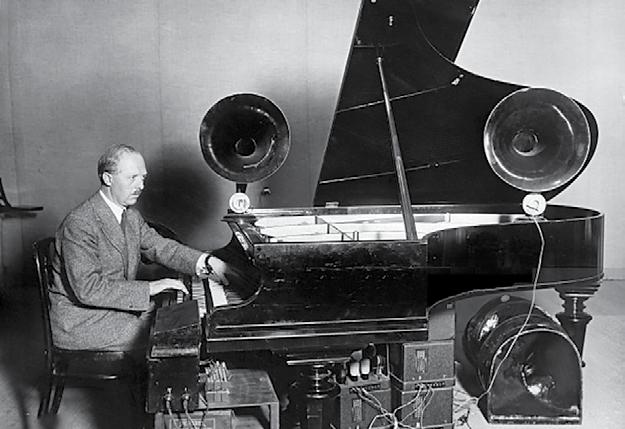

MUSIC
Herman Von Helmholtz
Jörg Mager
82 VOYAGER 9/2017
scape of our planet, prompting composers and designers of musical instruments to start listening differently.
Contemporary methods of capturing and transforming sound took some time to become established, even after the supporting technological capacity arose. Developments in electronic instruments began around 1920, and there was an extraordinary variety of musical devices with unusual, sometimes not quite euphonious names such as the Helmholtz sound synthesiser (1905), electrophone (1921), sparaphone (1924), klaviaturspharaphon (1928), ondes martenot (1928), melodium (1938), mixturtrautonium (1936), theremin (1920), hellertion (1929), partiturophon (1930), kaleidophon (1939) and melochord (1949). These of course pre-dated complex computer installations, MIDI and other recent advances closely linked to electronic music.
There are volumes of studies on the historical phases of new musical technologies, and almost all are directly connected with electronic sound. It started out as a series of psychological experiments about how people would perceive such sounds, and it took some time for them to become something generally listenable by the public. Looking at the earliest period of electronic music, in Germany and elsewhere, the movement didn’t necessarily belong to any particular field. Rather, it was a network of people who were listening differently, and as people got used to the new noises of the industrial world, pioneers did their best to push these noises into the realm of music.
Germans tiptoed into electronic music, sniffing it out first. First came the theory and then the practice – very German. By 1951, there was an electronic music studio in Cologne at the Westdeutscher Rundfunk (WDR), at the time the largest and wealthiest broadcaster in West Germany, and there was clear vision of how the music of the future could sound. Herbert Eimert, musicologist, composer and one of the founders of the studio wrote:


„Electronic music is, and remains part of our music and is a great deal more than mere ‘technology’. But the fact that it cannot be expected either to take over or to imitate the functions of traditional music is clearly shown by the unequivocal difference of its material from that of traditional music. We prefer to see its possibilities as the potentialities of sound itself.“
Back then, it was mainly the Germans and French who experimented on the possibilities of the electronic sound in professionally equipped studios. The French launched a studio for electronic music in 1951 at their national public broadcasting company (RTF). Actually, it had all started earlier in France when in 1942 Pierre Schaeffer, a pioneer of musique concrète, founded Studio d’Essai and began exploring radiophony with his pupils and like-minded colleagues including Pierre Henry, and Jacques Poulin.
Legend has it that the people working in the above-mentioned studios deeply despised each other. A German musician later confessed: “we had two types of Cold War in the 1950s - between the Soviet Union and the United States and between WDR and RTF”. But without doubt electronic music greatly benefited from that kind of creative rivalry. Back in the Cologne studio, the experiments conducted by the engineers and musicians at WDR were so popular that young people flocked to seminars on electronic music. Among them was a young Karlheinz Stockhausen, who attended his first Darmstadt international summer courses on new music in 1952. A year later, he created his first piece of electronic music Studie I, made of pure sine tones, at the Cologne studio.
Kraftwerk
83 VOYAGER 9/2017
Wolja Saraga
STOCKHAUSEN EMBODIED EVERYTHING ABOUT ELECTRONIC MUSIC, AND HIS IDEAS, WHICH AROSE FROM HELMHOLTZ AND OTHERS, WERE INFLUENTIAL IN GERMANY

So, then there was Karlheinz Stockhausen...

Of course, there were several important names in this field. Unfortunately, we cannot mention them all, though there was one person who was very prominent in the short history of German electronic music. Eminent musical mastermind Stockhausen was the main vehicle through which electronic music and everything that happened regarding electronic sound in academic circles seeped into pop culture.
Stockhausen is the only German composer who made it onto the cover of the St. Pepper’s Lonely Heart Club Band album by the Beatles. From the 1960s, Stockhausen embodied everything about electronic music, and his ideas, which arose from Helmholtz and others, were influential in Germany as well as abroad, rapidly gathering momentum and resonating among a new generation of musicians. The readiness for his ideas was so ripe and Stockhausen’s influence so big that it prompted Holger Czukay, one of his pupils and without doubt one of the pioneers of experimental
MUSIC
Karlheinz Stockhausen
84 VOYAGER 9/2017
WDR studio
music, to say, in a kind of Zen manner, that they urgently needed to kill Stockhausen or else they would never find their own voice!
And then there was Krautrock...
This is one of the most preposterous terms in the history of contemporary music, a toothless joke by one decent English fellow. It points at nothing rather than the fact that it is a German phenomenon, but what followed was that this badly labelled sonic counterculture and the musicians working within its confines managed to put Germany on the sonic map. Anyone talking about contemporary forms of music including avant garde, minimalism, psychedelia, free improvisation plus the many incarnations of electronic music can’t bypass the “Teutonic” phase any more.
“Kosmische music” is how some Krautrockers named the sonic phenomenon, and despite the fact that not all music created in Berlin, Munich, Cologne or Dusseldorf was directly linked to electronic music, any young DJ around the world will firmly state that Krautrock was a decisive phase for the further development of electronic music, not only in Germany in the rest of the world. That’s why rock stars like David Bowie, Iggy Pop, Lou Reed and others frequented Germany at the beginning of the Seventies. They were perfectly aware of what they were looking for there.
THEY TURNED POST-WAR GERMANY INTO SCI-FI TERRITORY, WITH THEIR MUSIC PUSHING CONTEMPORARY POP MUSIC INTO THE FUTURE.
Just listen to Krautrock musicians and bands such as Tangerine Dream, Cluster, Ash Ra Tempel, Can, Neu!, Amon Düül II Popol Vuh, Faust, Klaus Schulze and you’ll grasp it instantly. German musicians took everything that they enjoyed in world musical culture – from Pink Floyd, James Brown, The Beach Boys, Frank Zappa, musique concrète, minimalism, African music and Stockhausen – and created something unheard before. They turned post-war Germany into sci-fi territory, with their music pushing contemporary pop music into the future.
And then there was Kraftwerk...

Kraftwerk emerged from Krautrock, but compared to the other bands and musicians associated with that experimental music community, they had the most important influence. They eliminated all boundaries between so-called “serious” and “not-so-serious” music and created a tradition within the tradition. They established the sonic blueprint followed by an extraordinary number of artists in the subsequent decades, and today many think Kraftwerk more influential than the Beatles. Kraftwerk was the starting point of a revolution in electronic music’s popular realm. It set the standard in the culture and helped foster the current era of prosperity in the scene, and that’s why no one asks any more “Why Germany?”.
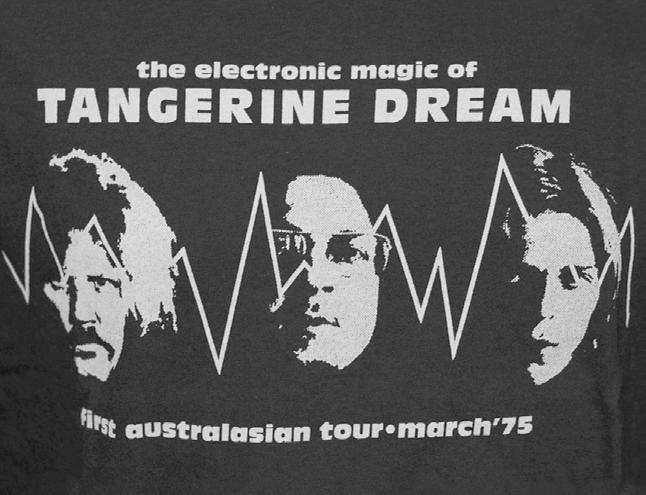
IT SET THE STANDARD IN THE CULTURE AND HELPED FOSTER THE CURRENT ERA OF PROSPERITY IN
„Why Germany?“
THE SCENE, AND THAT’S WHY NO ONE ASKS ANY MORE
85 VOYAGER 9/2017
THE DASSLER “FANTASTIC SAGA”
BIDZINA BARATASHVILI
The topic of this story was chosen very unexpectedly - initially, I was planning to talk about interesting moments in Germany’s rich football history. But then I visited the annual International Market of Communications Programs (MIPCOM) and on the very first day my attention was drawn by an interesting exhibit on the Global Screen stand – an old brown ball on a small piece of artificial grass. There was an inscription: "WM 1954 in die Schweiz. Finale am 4 Juli 1954 in Bern. Deutchland: Ungarn 3: 2. Weltmeister Deutchland" (The 1954 World Cup, 4th of July, Bern. Finale: Germany - Hungary 3: 2 World Champion: Germany).
Soon I found out that this composition was part of an advertising campaign for a new German mini-series, and the project itself was dedicated to the life and fierce rivalry between the two Dassler brothers – the creators of the world's two largest sports brands (Adidas and Puma).
In German, the film-series is titled "Die Dasslers" ("The Dasslers") while the English version is titled "Rivals Forever". Filming was completed in 2017, and since then this creation of two Oscar-winning producers, Quirin Berg and Max Wiedemann, has already received several prestigious prizes. This comes as no surprise as, apart from this duo of producers, the film has a great screenwriter - Chris Silber (international EMMY for the film “A Day for a Miracle” "Das Wunder von Kärnten"),
good actors in the main roles - Christian Friedel and Hanno Koffler – and most importantly, a strong foundation – the fantastic saga of the Dassler brothers.

Rudolf Dassler was born on 26 March 1898, his younger brother Adolf on 3 November 1900. They were completely different from the very beginning. Adolf – a very hardworking, progress-oriented person and an excellent sportsman – had been playing football since his childhood and led a healthy lifestyle until the end of his life. He was responsible for starting the family business: he took the craft of Christoph Dassler, his shoemaker father, to a new level and used the working space of his laundress mother as his first office. This is where he brought the Zehlein brothers who produced the spikes for his athletic shoes.
In 1923, Rudolph came to work there on his own initiative. This sex, jazz and box aficionado had already served in WWI with his elder brother Fritz, and even worked as a police officer in later years. Rudolph invested a typewriter as his share to the family business!
On 1 July 1924, the Dassler family company, Gebrüder Dassler, was established and local athletes had a chance to test their products as soon as the 1928 Olympics came. Four years later, in Los Angeles, Arthur Jonath brought the “Dasslers” a bronze
SPORT 86 VOYAGER 9/2017
medal, and the 1936 Berlin Games were marked by four Gold Medals for Jesse Owens and five Olympic records! A business that had started with a bicycle turned into a sewing machine in a rented washing space expanded to two factories and produced 1,000 pairs of shoes a day. It seemed that everything was going swimmingly, but the hardest challenge lay ahead for the Dasslers...
On 1 May 1933, all three brothers became members of the Fascist party. Rudolf took an active part in the political work and never criticized the Nazis, which in turn stressed his relationship with his relatively liberal younger brother. There were other reasons for the conflict: Rudi criticized his younger brother for his endless improvements to the already successful models, and Adi did not like Rudolf's arrogance and bohemian character.
The reason for the ultimate split was the phrase that Adi uttered in the bomb shelter during an American bombing: "The bastards are back again!" Rudi and his wife, who had just arrived, thought he meant them, while Adi later asserted that he meant the American pilots.
In March 1943, Rudolph was recruited to the front as part of "Total Mobilization", first to Glauchau, then to Tuszyn, where, claiming night blindness, he sought the refuge of a translation bureau. In January 1945, he escaped the Red Army units, returned to Herzogenaurach, Germany, and soon found himself in captivity under the Gestapo for desertion. With a high
probability that his life would have ended at Dachau, while being transferred to the concentration camp he was freed by the Americans, and in July he was arrested for cooperation with the Gestapo! Instead of Dachau, Rudi found himself in the Hammelburg POW camp where he learned that he was probably interred there based on information supplied by his brother! During Rudi’s interrogation as part of the "de-Nazification" process, he claimed that during the war his brother Adolf had initiated military production in the factory and even encouraged the workers with political agitation! The court found the younger Dassler guilty...
IN APRIL 1948, THE BROTHERS FINALLY SPLIT AND THE FAMILY BRAND CEASED TO EXIST. IN EXCHANGE, THE SPORTS WORLD GAINED TWO NEW COMPANIES: ADDA AND RUDA. BOTH WERE CREATED BASED ON THE SAME PRINCIPLE: THE BROTHERS PUT THE FIRST LETTERS OF THEIR NAMES AND SURNAMES TOGETHER, BUT NEITHER NAME WORKED AND BOTH HAD TO BE CHANGED. FINALLY, ADI ADDED ONE LETTER TO THE NAME AND CAME UP WITH ADIDAS; RUDY, REMEMBERING HIS RAFFISH YOUTH, NAMED THE COMPANY AFTER A NICKNAME GIVEN TO HIM BY HIS THEN LOVERS – PUMA.
The 1950s were the culmination of the "family feud". Both companies became involved in the football business, and both successfully. Each of them created a football team in Herzogenaurach; their employees drank different beers and even took their children to different kindergartens!
Puma signed contracts with Dortmund "Borussia", "Eintracht ", "Stuttgart" and "Kaiserslautern" (including the future world champion Horst Eckel and Werner Libriech). During Germany’s 1954 championship final on 23 May, eight "Hannover" players wore "Puma" shoes.
Adidas went even further: In 1949, they launched the first model of rubber shoes with removable spikes, and the following year shoes tailored to play in the snow and the rain. Adi personally attended 1954 World Cup matches (which ended with the German victory) and adapted the shoes he had designed to specific soil and weather changes. By that time, in partnership with Willy Zeltenreich, he had already dressed the 1952 Olympians, adding an extra line to the two-line design of the “Dassler” t-shirts, which continues to be the brand’s distinctive trademark to this day. One more innovation was the Adidas sponsorship contract of the 1956 Olympics, which laid the ground for the modern era of sports commercialization.

87 VOYAGER 9/2017
The triumph of 1954 made Adidas’ advantage clear. Despite that, Rudolph was not going to give up, and even won a court proceeding against his brother banning the company from using the slogan “The best sports shoes in the world” following Brazil’s victory in the 1958 world cup (who played in Puma shoes) From their side, "Adidas" always blamed their opponent for stealing their technologies. Adi is known for saying: "If I were to kick and puncture Rudolf for every theft, he would look like a Swiss cheese!"
At the end of the 1960s, the children took over their fathers’ work. Their conflict also began with the Brazilian Clothing. Before the beginning of the 1970 Mundial, Armin Dassler hired journalist Hans Henningsen to work for "Puma", and tasked him to attract South American players to the brand. Due to a gentleman's agreement with his cousin Horst, Armin forbid the journalist to talk to Pelé on this matter, but the "King" wanted to make a lucrative contract himself, and "Puma" coveted such an opportunity, leading to a new scandal. The family feud moved on to the next generation ...
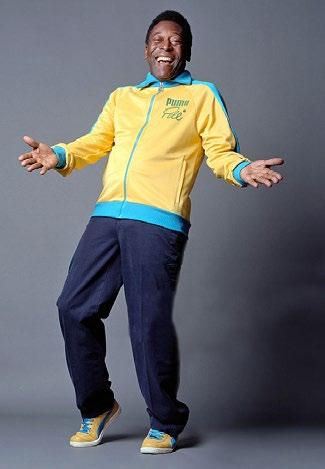
They say that the two founding brothers of the empire met each other secretly at the beginning of the 1970s. In September 1974, Rudy's health deteriorated completely – he was diagnosed with lung cancer. A few hours before his death, the family priest got in touch with Adi on the phone and urged him to come and say farewell to his brother...
From this point, in any other country I would be telling you the details of the final reconciling and tearful meeting between the two brothers: in America they would urgently find a best happy end writer, in Italy the family and kinship motives would win over, and a French director would emphasize a sad and witty comment by the dying Rudolf. However, the German reality turned out to be much colder and more abrupt. Adi did send his forgiveness through the priest but strongly refused to come see his brother. His family’s official press release was as follows: "Adolf Dassler’s family wishes to make no comment on Rudolf Dassler’s death."
P. S. Today, the opposite banks of the Aurach river in Herzogenaurach are still home to the Adidas and Puma headquarters, but the Dasslers don’t work there anymore.
Adi left his children a smoothly running 500 million empire. At one time, it was effectively run by his eldest son, Horst (1936-87), who at various times first founded the French Adidas, then the swimwear producer Arena, and ultimately launched an international sport sponsorship project with João Havelange. Unfortunately, his sisters did not have the same business acumen. After Horst's death, they quickly spent a large part of the fortune and eventually sold 80% of the shares to Frenchman Bernard Tapie for 440 million Deutsche Marks. Thus, since 1990, "Adidas" has no longer been a Dassler family business.
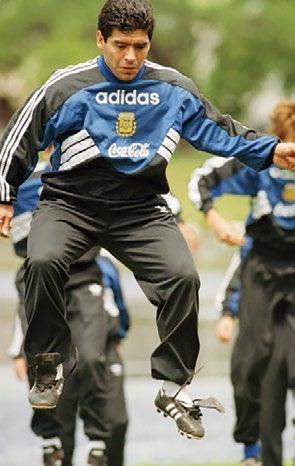
Today, the Adidas business unites several companies: Adidas, Reebok, Runtastic, Matix, TaylorMade ... The number of employees has surpassed 53,000, annual sales total 19.2 billion euros (2017), and net profit is 720 million euros.

The Puma office is on the other side of the river. Rudi's oldest son, Armin (1929-1990), first protested his father's will and and left the younger Gerd out of most of the business activities, then turned Puma from a provincial company into a global brand. However, in 1989 the brothers sold 72% of the shares to the Swiss Cosa Liebermann.
According to 2015 data, Puma is far behind its "neighbor-relative", but its figures are still quite impressive: 11,000 employees, annual sales of 3.3 billion euros, net profit of 37 million euros.

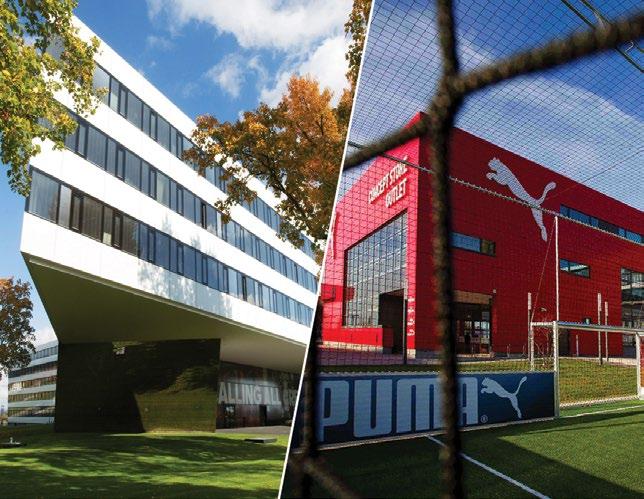
SPORT
Diego Armando Maradona Pele Edson Arantes do Nascimento
88 VOYAGER 9/2017
THE APPEAL OF WORN ORANGE LEATHER
I have no idea why I decided to look for shoes on that fine, sunny morning in February (so rare in Berlin). That is unimportant. The endeavor led me to a unique discovery.
I will never forget our meeting: it was shaped like an iron, in its elegance and flexibility reminiscent of that item or a WWII submarine. The slightly torn orange-red leather surface was purposefully scarred, as if by an irresponsible surgeon who had carelessly stitched up a wound. Soft and sturdy, comfortable, with rubber soles of unknown colors to which the leather upper was attached via big and reliable seams. It was wide enough to provide freedom for even a very big foot. The foot would probably feel comfortable in a good quality, durable, reliable shoe that was made to last forever. Two silverfish flowers shyly bloomed on the leather surface, as if apologizing for being here, whispering that the shoe was intended for women.
As if this was not enough - the shoe’s friends formed rows on the store shelves, all made in the same style. Some exclaimed boldly, while some murmured with their heads down that these indeed were women’s shoes. The open-toe, summer items were the most tragic. The abundance of flowers and flirty toe openings emphasized the catastrophe of combining design with comfort. I was shocked, so I tried another store, then another. The situation was hopeless, even, I’d say, tragic. With my youthful ambition and maximalism, I was
convinced that it was impossible for the women of one of Europe’s strongest capitals to wear only these kinds of shoes. The reality was different, hopeless. I finally gave up, though the image of silverfish flowers on the orange leather surface haunted me for a long time.
Don’t be afraid, it happened a long time ago. The Berlin Wall had just been taken down, and German women preferred to walk among its ruins in those shoes.
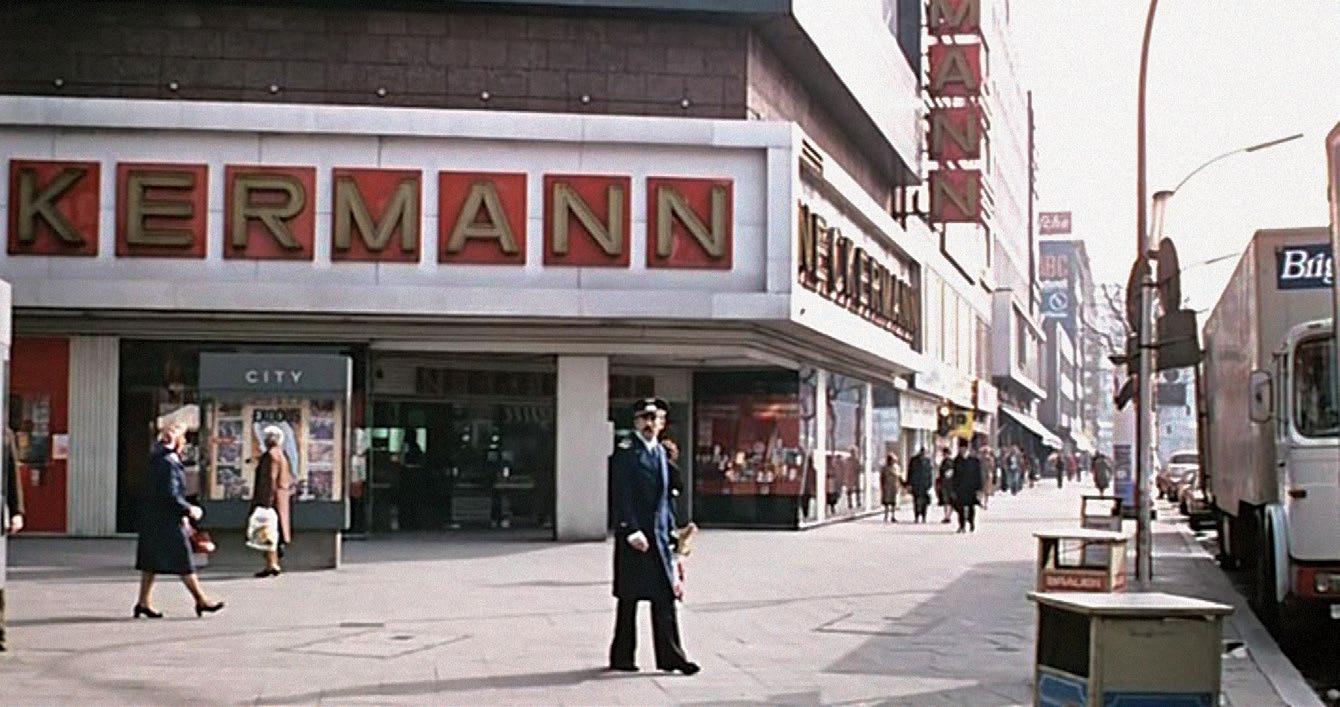
Everything has changed gradually. I am sure that my old friends are still very popular, sharing shelves with other shoes.
Berlin, just like other big European cities, has a certain dress code. Nobody dresses overly ambitiously. Artists favor intellectual chic, with practical, quality clothing and design expressed in small details. Mixing up designer clothing with second-hand items and its more elevated version, vintage clothing, is very popular. However, the successful blending of those styles is achieved by only a select few. Many students and young people live in Berlin. They dictate the clothing style of the city.
German fashion has always responded to popular demand. Items have to be of good quality, durable and comfortable, sometimes achieved by means of orange leather.
MODA
SALOME DADUNASHVILI
89 VOYAGER 9/2017
"European Center", shot from the film "Mimino"
EDUCATION IN GERMANY
Germany is a country of universities, attractive for foreign guests, whether beginners or scientists due to the following reasons:
• High academic level in universities;
• Recognized value of German engineering education;
• International standards of teaching: Bachelor, Masters and PhD programs in English;
• Free or low-cost learning; cheap accommodation in comparison with other EU member states;
440 higher education institutions are located in Germany, most of which are state funded (360). Among these are the old universities with a wide range of classical specialties and at the same time many small-sized universities offering modern and applied specialties. Those interested in learning in Germany can choose between 12,000 specialties and subjects.
UNIVERSITIES IN THE ERA OF "GLOBAL SOCIETY OF KNOWLEDGE"
Wilhelm von Humboldt reformed the German university system at the beginning of the XIX century. He developed a style of teaching based on a discussion between teachers and students. Lecturing as a form of knowledge transfer, when one speaks and the rest listen, was considered secondary. Humboldt believed that the teacher serves the students at school, while at university, professors and students work together. It was a revolutionary idea back then, which helped German universities to become the best in the world.

THE BIGGEST ADVANTAGE OF THE GERMAN TEACHING MODEL IS FREE EDUCATION. THE NUMBER OF STATE UNIVERSITIES SIGNIFICANTLY EXCEEDS PRIVATE INSTITUTIONS. THEY ARE AVAILABLE TO LOCAL AND FOREIGN STUDENTS. ONLY 5% OF THE POPULATION ARE EDUCATED IN PRIVATE SCHOOLS.
After the introduction of bachelor’s and master’s degrees, the system was slightly modified: the bachelor's program includes lectures where the transfer of knowledge prevails. The master’s programs emphasize seminars and discussions. Three types of university, which all appeared in the nineteenth century, still remain in the German higher education system. First of all, "city-making" universities determine the social structure of a city. The classic example of such university cities is Heidelberg, Marburg and Tubingen. The second type is the universities that are located in big cities or in the capital cities of the federal states and play the role of "beacons of educational policy". These are typically characterized by a fast pace of modernization of the educational programs on offer. Finally, the third type consists of universities that cooperate with the Max Planck Society or Leibniz Associations. A number of famous scientists work in these universities, many of whom are Nobel Prize laureates. These universities are widely known in the scientific world and are the most striking example of elite education and advanced science (Exzellenz).
EDUCATION
Marika Shalikashvili
90 VOYAGER 9/2017
DUAL SYSTEM
The dual system is characteristic of the German education model. It is the quickest way to get employed, enabling a college student to engage in a future profession directly in the workplace. Vocational education takes place simultaneously with the student's employment and the state reimburses part of the wages of students involved in such programs.
“The law of artisans”, which took root in the 19th century in Germany, was key to the implementation of this model. Dual education has become a more flexible and efficient method of providing short-term vocational education in order to become proficient. After graduating from high school, young people have the opportunity to continue their studies and also work. Theoretical and practical skills are acquired simultaneously in auditoriums and on site. Exams take place after the course is finished. State-certified diplomas are then issued and work is provided. Although in dual education the job part provides a lower income, demand for employees with a dual education is higher in the job market compared to employees with a higher education who only have theoretical knowledge and no practical experience.
Dual education in Germany has penetrated almost every area of business. It consists of 346 basic and 46 high-demand vocations. Dual education has led Germany to become the country with the highest percentage of employed young people in Europe.
TOP FIVE UNIVERSITIES IN GERMANY

1. Heidelberg University _ the oldest university in Germany, which has branches in America, Chile and Egypt. It includes several scientific institutes. Among the university’s famous alumni are Hegel, Mendeleev, Mandelstam and Helmut Kohl.
2. Munich Ludwig Maximilian University _ famous not only in Germany, but also considered one of Europe's most prestigious schools. 34 Nobel Prize winners have graduated from this institution. It holds the thirteenth place in the list of the world's top universities, and according to the Der Spiegel ratings, it is considered the best school to study history, sociology, medicine and biology. Its famous alumni include Patrick Susskind, Rainer Maria Rilke, Richard Strauss, Ian Fleming and Max Weber.
3. Munich Technical University _ among the world’s best universities in the TU-9 Community and the only German technical school listed among the world's best. Graduates often work in large corporations such as BMW and Siemens.
4. Berlin Free University is an elite institution that emphasizes international relations. It has over 100 partners on all continents around the world. It is an active participant in the "Erasmus" program, and implements many exchange programs. Its famous alumni include Herta Müller, Kenzaburo Oe and Gerhard Ertl.
5. Georg-August Gottingen University _ this university was established in 1737. It is considered one of the most prestigious educational institutions in medicine, biology and natural sciences. 47 alumni have received the Nobel Prize, including Otto Bismarck and Arthur Schopenhauer.
OPPORTUNITIES FOR FOREIGN STUDENTS
The number of international students interested in receiving an education in Germany is high, third only to the United States and Great Britain. This is because higher education institutions in Germany offer students a total of 1,381 international courses and subjects are taught in different languages. Hence, more than 301,000 foreign students are currently studying in Germany. 870 schools issue the German Diploma (DSD); bachelor's and master's degrees issued in Germany have international accreditation. In addition, Germany has one of the highest employment rates in the EU.
There are more than 140 German schools in 72 countries, with an average of 20,800 German and 61,000 foreign students.
In addition to foreign language courses, most lectures are held in German, thus students must be fluent in German. The Goethe Institute provides language courses in 159 branches in 98 countries.
The German Academic Exchange Service (DAAD) is an exchange learning center that offers options for young people interested in being educated in Germany. In the past number of years, it has provided scholarships for 70,000 German and 50,000 international students.
COSTS PER MONTH:
Lodging: from 400 to 800 EUR;
Meals: 200 to 400 EUR;
Insurance: 40 to 70 EUR;
Transportation: 50€.
STUDENT EMPLOYMENT:
Since study breaks in Germany amount to 5 months a year, students have the right to work 20 hours a week. The average salary is 5-10 EUR per hour. According to immigration laws, it is easy for international students who have graduated from a German university to get a job.
91 VOYAGER 9/2017
ASIAN CUISINE WITH GERMAN SAUCE
Tim Raue is 43 years old. His restaurant is located in Kreutzerberg – one of the liveliest and eclectic districts in the city and a culinary mecca. Tim was named “Newcomer of the Year” in 1988 for the revolution he caused in the KAISERSTUBEN restaurant. Since then he has held multiple leading positions and received many awards and acknowledgements – his restaurant was listed on the GAULT MILLAU and CONDÈ NAST TRAVELLER lists for best restaurants. He was recognized as “Chef of the Year”
GAULT MILLAU in 2007, soon followed by a Michelin star. Tim Raue decided to leave the position of chef in ADLON Holding GmbH and opened his own restaurant MA TIM RAUE, which was awarded with two Michelin stars.

CHEF
Salome Dadunashvili
92 VOYAGER 9/2017
“Langoustine, Wasabi and Cantonese Style”, “Peking Duck Interoperation TR”, “Suckling Pig, Dashi (type of Japanese soup) and Japanese Mustard”—just to name a few of the dishes that require making a reservation several months in advance.
The most dedicated gourmands try to reserve the so-called KRUG Table – a massive oak wood table that seats 10 guests and opens on to the interior of the kitchen. It allows a perfect view of the cooking, as per the best traditions of the chef’s table. Additionally, you can indulge in an individually created KRUG table menu and champagne.
How did you decide to become a chef? Who was your inspiration? We’ve heard of many stories about chefs coming from culinary gifted families and mothers and grandmothers are often blamed for their choice of profession…
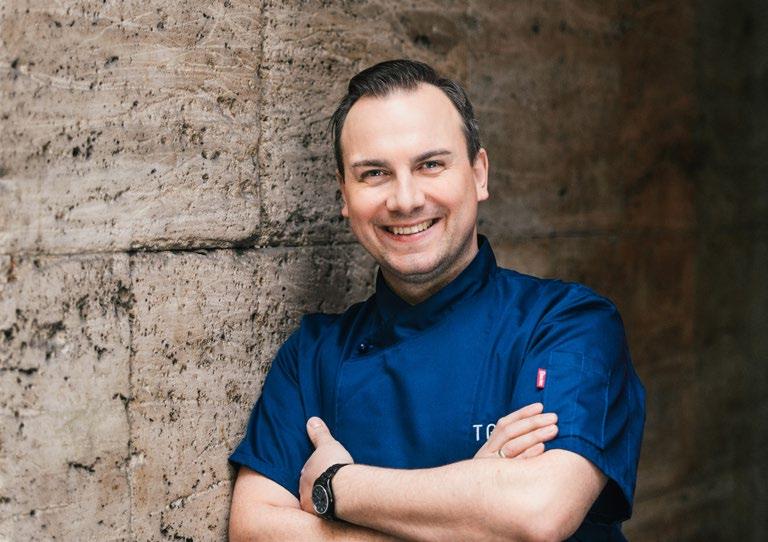
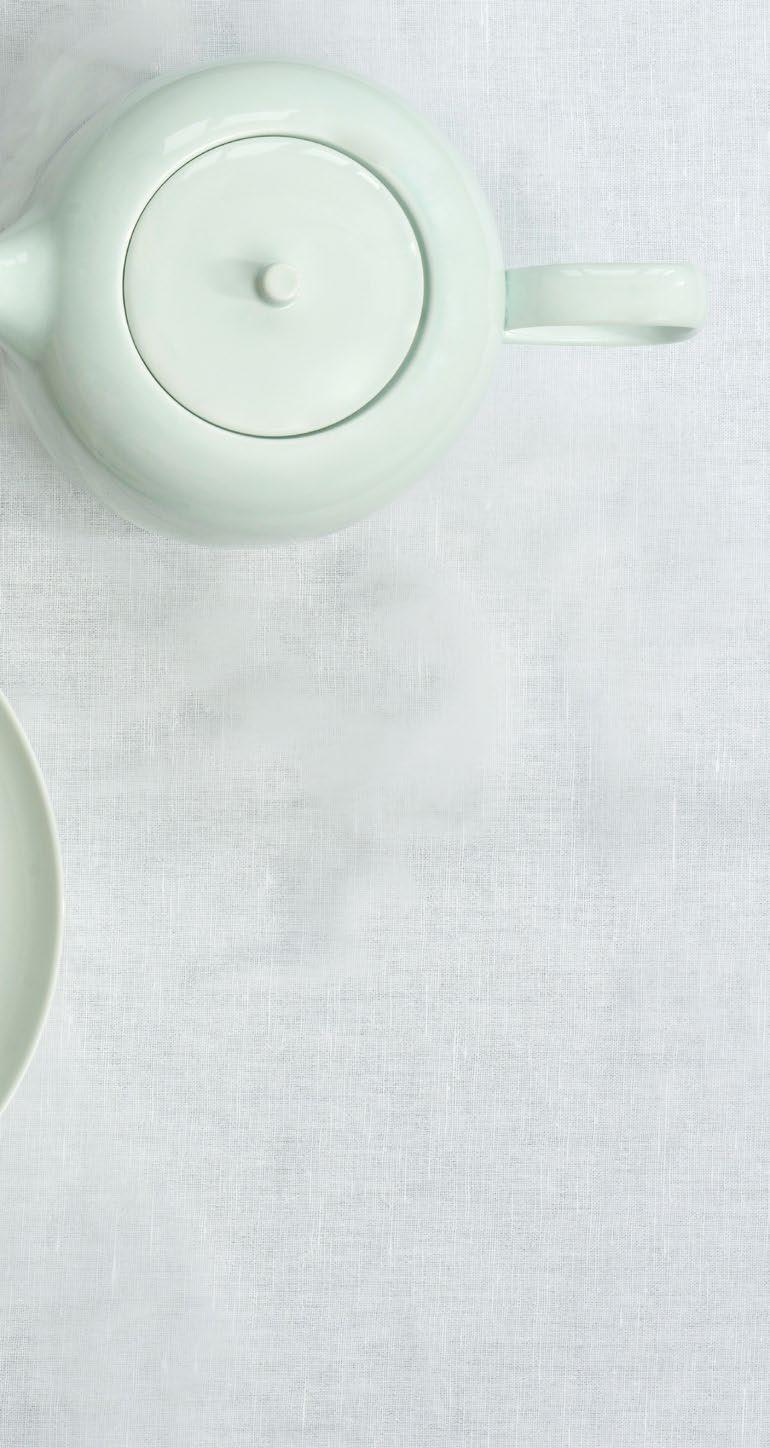
To tell you the truth, I just needed a job. When I graduated from the 10th grade, a special organization came to our school and offered me to try three different vocations. These are state institutions that help adolescents choose a vocation. They suggested: gardening, painting houses or being a chef. I chose the latter.
Berlin is a unique city. Did you take its distinctive features into account when you created the concept for the restaurant?
Marie-Anne is my business partner and we came up with the restaurant concept together. We wanted to do what we love and know, especially at that time. It had to be a unique restaurant where I would prepare my version of food for the clients. This was a mix of Thai flavors, Japanese purism and the Cantonese style of cooking.
What gives you inspiration to create new things in this changing city? Even your native district, Kreutzerberg, has radically changed since your childhood.
Asia gives me the biggest inspiration, as well as art and fashion.
Who are your clients? People who become regulars – are they real Berliners or travelers?
We have a variety of clientele. Many international gourmands visit us – this is the reason why they travel to different coun-
93 VOYAGER 9/2017
TIM’S CUISINE IS FAMOUS FOR REINVENTING TRADITIONAL ASIAN DISHES. IT IS ONE OF THE MOST POPULAR AND HOT PLACES IN BERLIN AND IS AMONG 34 OF THE BEST RESTAURANTS IN THE WORLD.
ties. Such people plan their life around the list of the best 50
Why did you choose Asian cuisine as the main inspiration for your menu?

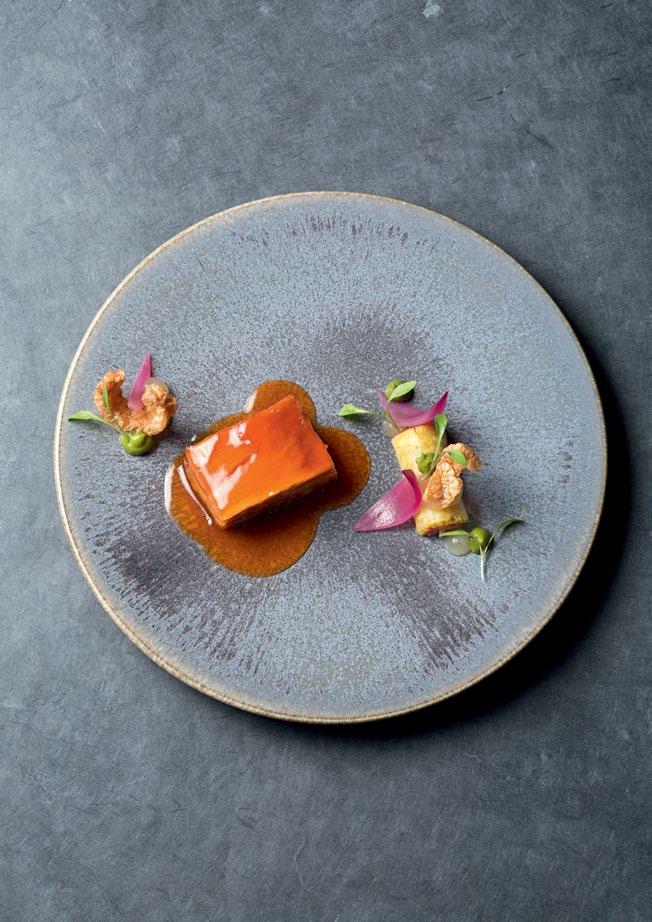

I was completely crazy about the flavors in 2003. I went to Singapore for the first time and had an opportunity to taste wonderful Thai, Japanese and Cantonese food.
The vegetarian and vegan movements are very popular across the world. More and more restaurants are following this trend and their menus feature many vegan dishes. They explain that if we don’t change our eating habits, it will be impossible to produce enough food to feed humanity. You offer vegetarian dishes, though no vegan food. Is that part of your restaurant concept or are you unable to create new dishes without using animal produce?
Everything is much simpler: truth be told, I am not interested in and I don’t want to cook vegan food.
How do you choose ingredients for your kitchen? What comes first when you think of a new dish – ingredients or the final result that you want to achieve?
Every dish that I invent has a different story. It may be an original dish enriched by new elements and turned into something different – for example, we changed the ingredients and turned shrimp with wasabi into langoustine with wasabi. Art can inspire you to create new dishes, just like it happened with Elizabeth Peyton’s work. Those impressions were inspiration for fish with habanero and imperial caviar. Sometimes ingredients inspire the dish, for example Hamachi fish. It is often
CHEF 94 VOYAGER 9/2017
TO TELL YOU THE TRUTH, I AM NOT INTERESTED IN TRENDS. CHINESE CUISINE IS HUNDREDS OF YEARS OLD AND IT STILL REMAINS VERY POPULAR.
enjoyed raw in Japan, though I decided to serve it differently. This protein gets very dry while cooking so we found a solution and now serve “Hamachi confit” with jade sauce.
Which ingredients can’t you live without and which ingredients will you never use?
I don’t like kidneys, so I never cook using them. I like a bit of sweet, sour and hot in every dish. Ripe fruit, citruses and vinegar are necessary as well. Also, I need to have 17 varieties of chili when I cook.
Which dishes do you prefer in your menu?
I love all of my dishes like my own children.
Could you recommend a dish from German traditional cuisine that every traveler should taste?
Oh, there are so many of those! Also, it’s not about the dish, it’s about the chef who cooks it. You have to choose traditional cuisine places carefully.
Luckily, there are many young chefs in Germany, soon to become stars. They create German cuisine using local ingredients with individual style.
Haute cuisine often follows new trends, for example, using only seasonal ingredients or fermentation. What do you think is the next trend?



To tell you the truth, I am not interested in trends. Chinese cuisine is hundreds of years old and it still remains very popular.
The big chefs are often lying to our senses. We see a flower and it tastes like a chicken, or a lollipop and it tastes like a soup. What do you think of such experiments?
I don’t care for this way of cooking. Our restaurant offers high-quality food and not some kind of gimmick.
Dinner WednesdaySaturday
Cuisine: 12.00-13.00
The restaurant is closed: 15.00
Dinner Thursday - Saturday
Cuisine: 19.00-21.00
The restaurant is closed: 24.00
Rudi-Dutschke-Str. 26 tim-raue.com
95 VOYAGER 9/2017
RESTAURANT TIM RAUE
RHEINISCHER SAUERBRATEN
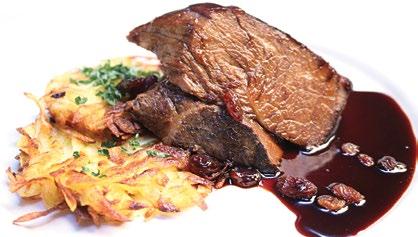
MAULTASCHEN

FRITTATENSUPPE
In Red Wine or Vinegar Marinade
Marinated and fried beef is often paired with a side of boiled potatoes and sour cabbage (the meat is marinated for 10 days).
EISBEIN MIT SAUERKRAUT UND KLÖSSEN
Pork calf with sour cabbage and potato balls. Usually, the pork is roasted. As for the Klößen, this side dish is often made by boiling dough or potatoes and giving them a round shape.
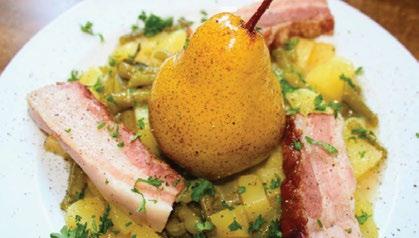

SCHNITZEL
Schnitzel, or fried meat, is served with various sides but is especially good with mashed potatoes and mushrooms. To prepare schnitzel, pork, beef or chicken is dipped in breading.

GRÜNKOHL UND PINKEL
Green cabbage braised with onions and fried sausage is a typical Bremen dish. It is served with caramelized boiled potatoes and is considered a winter food.

This dish reminds many of ravioli. The ingredients are the pasta dough, meat or spinach, roasted or boiled. It is especially delicious in the south of Germany.
KÖNIGSBERGER KLOPSE
These meatballs served in a cream sauce are made with meat, eggs and lemon peel, and in some cases, spices. Often, they are served with boiled potatoes or rice.

BEER’N, BOHN UN SPECK
A mix of cooked meat and noodles served with savory, sprinkled thin, bread-like pancakes which are cut in small pieces.


SPARGEL (ASPARAGUS)
Those who do not want to have a dish with meat, in the period from April to the end of June, can enjoy an asparagus dish almost everywhere. Asparagus cream soup, which is made with butter and white wine, is delicious. You can also enjoy an asparagus pizza.

NORDDEUTSCHE KRABBEN
Pears, green beans and steak is an early autumn dish and is often accompanied by a side of boiled potatoes. It is typical in Hamburg but popular in the whole of northern Germany. A combination of sweet and spicy ingredients creates a unique, amazing flavor.
You can try many delicious dishes made from crab, which is easily available in Northern Germany. For example, Büsumer Krabben is a typical crab variety, light brown and measures only 9.5 centimeters. Considered a delicacy today, this crab was a food of the poor for a long time. It has a soft and lightly sweet taste and is often eaten with bread and butter. In addition, in the North you can enjoy crab with any type of food: salads, juices, cold, hot, roasted or boiled.
96 VOYAGER 9/2017
KARTOFFELSALAT
This dish is often served along with sausage or schnitzel. The salad is made from boiled and chopped potatoes mixed with onion, vinegar and mustard.

KARTOFFELSUPPE
This homogeneous soup is of course made of potatoes, and the preparation varies by German Bundeslanden, although the main ingredient is always actively represented. Often, you’ll get chopped weisswurst in this soup.
BUTTERBROT

In the Rheine region, they call it ‘bütterken’, in Saxony ‘bemme’, and in Berlin ‘stulle’. In 1525, Martin Luther described butterbrot as "an excellent food for children". In the past, it was just a piece of bread with butter spread on top of it. Nowadays they make it with ham, sausage and cheese. Butterbrot holds an indispensable place in German cuisine.
DÖNER KEBAB
The döner kebab was created in Berlin in 1972, according to the Turkish analogue.

Smoked or grilled thinly chopped meat, mixed with spicy peppers or fresh vegetables and placed in flat thin bread or regular bread. It always comes with a characteristic sauce.
WHAT DO THEY DRINK IN GERMANY
COLD BREW COFFEE

They say it's just an iced coffee, but it's not only that. It is very tasty and nutritious. Cold brew coffee contains fewer bitter substances and acids than the hot variety. It is ideal for those who have a sensitive stomach but love coffee. To prepare it, baristas mix freshly ground coffee and cold water, then they leave it for 12 hours and filter it afterwards. You can try this coffee with cream.
SCHORLE AND LEMONADE
You can eat ribs in different forms and ways - grilled or cooked in an oven or boiled.

Pork or beef ribs are often served with a special sauce, with a side of grated potatoes. Fried ribs come with fried potatoes, grilled ribs with grilled potatoes, and boiled ribs with boiled potatoes.
Cucumber has a refreshing effect when drunk, not only when used for cosmetic masks. Try to mix cucumber juice with basil, and you will immediately love this drink. There is a second variety – lavender lemonade, with the addition of prosecco. If you do not like alcohol, try a buckthorn or apple schorle.

WATER
Can a bottle of mineral water cost 30 euros?! You may think this price is very bourgeois, and you would be right. In some restaurants, you will even be offered a special "water map". For example, you may order water collected from raindrops, taken from a glacier, gathered from the ocean depths or enriched with balanced minerals.
Despite its Hungarian origin, this dish is much loved in Germany.
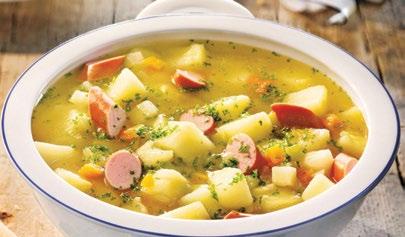
It is made of beef, vegetables and tomatoes and is often complimented with hot pepper.
In addition, there are numerous mineral springs in Germany, yielding high-quality water. Finally, the most affordable solution is tap water; just open the faucet and enjoy.
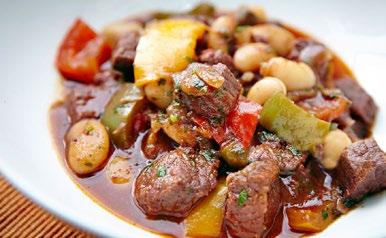
97 VOYAGER 9/2017
GOULASH
RIPPCHEN
GASTRONOMY
ANCIENT TRADITIONS OF SAUSAGE PREPARATION IN GERMANY DIFFER FROM REGION TO REGION. SAUSAGES ARE DIVIDED INTO THREE MAIN GROUPS: ROHWÜRSTE, KOCHWÜRSTE, BRÜHWURSTE.
ROHWÜRSTE
This category includes sausages made through margination , smoking or drying technology. Among them are salami and bratwurst. Bratwurst are represented by different varieties from all across Germany, the most popular being the Thüringen and Nurenberg. Some types of the latter are considered to be of the Brühwurste variety. They are usually prepared on a grill.

KOCHWÜRSTE
This type of sausage differs from the others due to its process - many types of sausage are mixed together and placed in an intestine skin. Blood and liver are added afterwards. The final product is arrived at as a result of heating or cooling. An example of such a sausage is Blutwurst, whose main component is pork blood.
Münchner Weisswurst - The most common type of this white sausage is the Munich variety. It is traditionally consumed before noon in the period between breakfast and lunch, by heat-
ALLGÄUER BERGKÄSE
ing or boiling it in hot water. It is usually served with sweet mustard and pretzels, and it goes well with white beer. Don’t forget to remove the skin before you start eating it.
BRÜHWURSTE
This type of sausage is boiled before eating and is often made from beef and pork meat, fat and water. Water is added in the form of ice to the processed meat and everything is heated at a high temperature (680C), after which it is cooled again. This allows for an increase in the storage time of the sausage. Only after that are additives and flavorings added. There are several types of this sausage: Bockwurst is a Bavarian sausage that is served fried or boiled.
Frankfurter Würstchen – or Frankfurter sausage – is made only from pork, and it is best to eat the ones from Frankfurt am Main. This is where it was created, but it is also called Vienner Frankfurter. The Viennese version of this sausage includes beef and poultry.
ZIEGENKÄSE
Leberkäse is a paté-type sausage that contains only 5% liver, with the rest often beef and pork. Only in bavaria will you find this sausage without any liver content. It is consumed both cold and hot when fried.

Jagdwurst, the hunters’ sausage, is mainly consumed cold and cut into small slices. It is also added to such meals as macaroni, pickled meat soup and potato soup.
Bierwurst is especially popular in southern Germany, and the Bavarians have it with beer and bread. This type of sausage often has a hint of garlic and goes well with mustard.
Bierschinken is known as the king of this type of sausage and is made of processed pork, beef, poultry and large slices of beef. You can consume it in large or small slices, with bread
ALLGÄUER EMMENTALER
OBAZDA
This belongs to the hard cheese category. It is made from the milk of the cows dwelling in certain territories, and it has a yellow color with a brown rim. The taste is remarkably tender and aromatic.

This Altenburg sheep’s cheese belongs to the soft cheese category. Some cows milk is also mixed into it. The cheese has a soft white rim, and on the inside it is a gentle light yellow mass, with pieces of plum.
This type of Emmentaler has been made from cow's milk since the 19th century according to a Swiss recipe. The cheese is smooth and gold colored, with characteristic cherry-sized holes. Its delicate and piquant taste has a nutty flavor and light bitterness.


This is a creamy variety of Bavarian cheese that includes other cheeses (Camembert or Brie, Romadur, Limburger), spices and pepper.
Its shelf life is extended by adding butter and other ingredients.
98 VOYAGER 9/2017
ANNUAL CHEESE PRODUCTION IN GERMANY IS 20 KG PER CAPITA, WITH A CHOICE OF 150 DIFFERENT VARIETIES.
BREZEL
Pretzels are a traditional German pastry. There are many different types: big and small, sweet and salty, topped with sesame or sunflower seeds, but the most common is still the salty one.

In Bavaria, they eat it at midday with traditional Weisswurst and beer. According to the Schwabs, a pretzel is tastier with butter.
BRÖTCHEN
Brötchen, or small bread rolls, go with any dish. They look like buns, but there is no sweet version.

They are often sprinkled with sunflower, sesame or poppy seeds. Most often, they are consumed fresh at breakfast with butter, cheese, sausage and hardboiled egg.
PLÄTZCHEN
This is one of the types of Christmas cookie. These small vanilla and cinnamon cakes often include hazelnuts, chocolate and jam. Every family has its own recipe and people of all ages participate in making it.
QUARKKEULCHEN
CHRISTSTOLLEN
This is a Christmas cake that can be found at any Christmas feast in Germany. The heavy dough is often blended with almonds, raisins, spices, lemon and orange peal. The Dresden Christstollen is especially popular.
KAISERSCHMARRN

This freshly baked, thinly-sliced caramelized pancake is often served with fruit sauce and ice cream. It is simultaneously mild and aromatic.

Pumpernickel is a type of black bread known all over the world. It has a dark color and a strong sweet and sour taste, although no sugar is used in its preparation. Traditionally, the bread is made of rye grain and flour and is baked for at least 16 hours. If you store it in its packaging, it will remain edible for a year.

FRÜCHTEBROTADVENTIS
Various types of German baked goods are made in the Christmas and pre-Christmas period. Among them is traditional fruit bread. Dried plums, apples, peaches and figs are mixed in sweet dough, with of hazelnuts, walnuts or pine fruits often added.

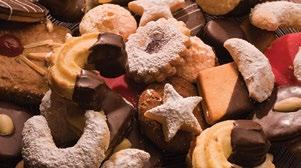
Wheat makes up 90% of this bread, while the remaining 10% is water, yeast, salt and spices. Buyers often have a hard time distinguishing it visually from other breads.

This type of bread is considered to be particularly healthy and is often found in bio-shops.
These roasted cottage cheese balls, ideal for having with a coffee, are made of cottage cheese dough, cinnamon, lemon and raisins. They are served with apple mousse or simply with sugar powder.
This typical German dessert is a must-try for those who love cream desserts. This black chocolate cake, with airy cream and cherries, is truly delicious.
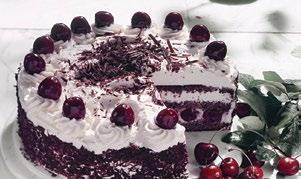
DER PHARISÄER
Many families have their own recipes for making fruit bread.

IN GERMANY, THERE ARE OVER 300 TYPES AND MORE THAN 1,200 VARIETIES OF BAKED GOODS. AN AVERAGE GERMAN CONSUMES 80 KG OF BREAD PER YEAR.
This typical North German national beverage is a type of coffee that can warm your hands, heart and soul. This strong coffee can convince you that even a non-alcoholic drink can be a source of happiness and joy. The
ingredients are rum, sugar and coffee, with cream on top. Keep in mind the main rule of enjoying this drink: It cannot be stirred!

99 VOYAGER 9/2017
PUMPERNICKEL
VOLLKORNBROT
GASTRONOMY
SCHWARZWÄLDER KIRSCHTORTE
“THE MIRACLE OF RIESLING”
SKHIRIELI
RIESLING IS A WORLD OF ITS OWN WITH MILLIONS OF NUANCES. IT CAN BE VERY DRY OR CONTAIN DELICATE FRUIT NOTES. THE VARIETY OF RIESLING ALSO DEPENDS ON THE ALTITUDE WHERE THE VINEYARD IS LOCATED.
The improvement of Riesling’s quality can be explained by the German climate warming since 2000. Studies conducted in Rheingau show that the average temperature in the region has risen by one degree in the last 20 years. This small difference plays a decisive role in the “giant breakthrough“ of German winemaking. For example, the so-called Oechsle degrees (indicator of density of wine mash), which determines the sugar content, have changed substantially. If 30 years ago it was 71 degrees on the Oechsle scale, today it exceeds 90. Reisling has become significantly sweeter and lost its distinct acidic flavor.

Germany’s share in global Riesling production is about 60 percent. It turned out that the long-growing grapes are most suited to the northern valleys. Thanks to this climate, a complex and diverse aroma emerges, with a pleasant taste and low acidity.
Riesling, grown on the steep slopes of Saarland and Mosel, received its unique nobility thanks to three important factors: the valley of the river, which runs along almost vertical shores; shale soils; and long periods of vegetation. The wines that are created as a result have high acidity. Even the sweetest wines have alcohol content of 7-8 percent; their taste is adorned with a great aroma and thanks to the mineral salts, it is long lasting.
Both dry and sweet Riesling from Mosel can easily compete with elegant wines from grapes grown in cooler climates. That is why more and more top producers are trying to grow their vineyards on old slopes. These places are hard to tend, but the results exceed all expectations. Make sure to try the Pfalz Riesling, which is distinguished by its complex taste and fruity (grapefruit, peach) aroma.
Rheinhessen is the largest vine-growing region, formerly used for the production and export of sweet Liebfraumilch. However today, even in the origin-specific areas of this variety (the banks of the Rhine, vineyards of St. Mary's Church in Worms) they grow noble varieties of Riesling. Even the varieties that grow on the banks of the Nahe River will surprise you with a pleasant taste and fragrant bouquet.
WINE IS PRODUCED IN 13 REGIONS IN GERMANY, WITH GRAPES GROWN ON 102 00 HA OF VINEYARDS. MOST OF THE VINE VARIETIES ARE OF LOCAL ORIGIN. IN 2016, THE VOLUME OF WINE PRODUCED CONSTITUTED 9.5 HL. SOCALLED BIO WINE MAKES UP 4-5% OF THE MARKET.
APPROXIMATELY 140 GRAPE VARIETIES ARE CULTIVATED IN GERMANY, THOUGH ONLY ABOUT 24 VARIETIES ARE COMMONLY KNOWN, THE FIRST AMONG THEM BEING WHITE RIESLING AND MÜLLER-THURGAU. THE SPLIT OF GERMAN WINE PRODUCTION IS 65% WHITE AND 35% RED.

WINE
TEA
100 VOYAGER 9/2017
SELECTION GUIDE
Among the white wines, Riesling is the most delicate and attractive, but before you enjoy it, you must read the label carefully. Pay attention to the following characteristics:
Acidity and Sweetness
Riesling’s main pride is its distinctive acidity. Even in the brands with the highest sugar content, the taste of Riesling is ideally balanced between sweet and refreshing, thanks to its acidity.
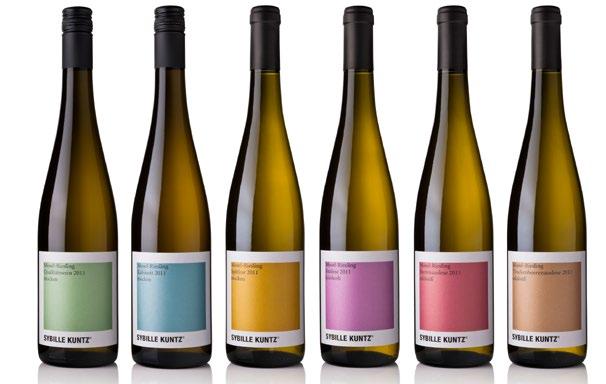
GERMANY IS REGARDED AS THE HOMELAND OF RIESLING. IT HAS BEEN KNOWN AS RIESSLINGEN SINCE THE 15TH CENTURY AND WAS BORN FROM THE GOUAIS BLANC GRAPE VARIETY. BOTH WERE GROWN ON THE BANKS OF THE RHINE. IN 1716, A BENEDICTINE ABBOTT PLANTED ONLY RIESLING IN THE JOHANNISBERG MONASTERY VINEYARDS. SOON THERE WERE 294,000 VINES OF RIESLING GROWING HERE AND THIS VARIETY SPREAD INTO REINDAU AND MEYLE.

The Variety of Aromas
A shade of citrus is typical of Riesling. If you are selecting a new wine, be aware that this wine bouquet is characterized by apple and pear tones, as well as notes of benzyl (kerosene, diesel) and burnt rubber that are harmoniously combined in the wine's overall taste. Old (aged) Riesling, apart from the above, is rich with tones of honey. The new dessert varieties are distinguished by exotic fruit, white flower and peach aromas, while the aged ones offer a bouquet of dried fruits.
CATEGORIES
KABINETT
The driest and usually the plainest.
SPÄTLESE
Made from more or less ripe grapes.
AUSLESE
Made from well-ripened grapes.
BEERENAUSLESE
Made from over-ripened, withered selected grapes.
EISWEIN
Wine which is made from the grapes picked before the first frost.
TROCKENBEERENAUSLESE
Or just ТВА, made from dried, selected and fully mouldy grapes.
RECOMMENDATION
STEINWIEGE RIESLING 2015
Produced in Württemberg
100% Riesling
Winery: Schnaitmann
Dry
An intense taste of grapefruit, green apples and lime; well-balanced with notes of minerals.
Price: From 20€
NEU-BAMBERGER RIESLING
2015
Produced in Rheinhessen
100% Riesling
Winery: Christian Steitz
Dry
With lychee aroma and well balanced taste of lime.
Price: From 25€
JOHANNISBERGER
KLAUS RIESLING SPÄTLESE 2015
Produced in Rheingau
QMP - QUALITÄTSWEIN MIT PRÄDIKAT INDICATES THE HIGHEST CATEGORY OF WINE QUALITY. PAY ATTENTION TO THE HARVEST DATE – IS IT EARLY OR LATE? THE LATER THE HARVEST, THE MORE NOBLE MOLD HAS COVERED THE GRAPES AND THE SWEETER THE WINE, WHICH ACCORDING TO THIS SYSTEM OF EVALUATION IS BETTER.
IN ADDITION TO THE SUGAR CONTENT SYSTEM, THERE IS ALSO A VDP CLASSIFICATION, ACCORDING TO WHICH DRY WINES ARE OF NO LESSER QUALITY THAN SWEET WINES - VDP GROSSS GEWÄCHS / QUALITÄTSWEIN TROCKEN.
100% Riesling
Winery: Johannishof, Johannes Eser
Sweet
Rich, deep concentration of fruit taste; balanced and rich texture.
Price: From 25€

101 VOYAGER 9/2017
GERMAN BEER
THE GERMAN BEER PURITY LAW RECENTLY TURNED 500 YEARS OLD. ON APRIL 23, 1516, IN INGOLSTADT, HERZOG WILHELM IV ISSUED A LAW THAT OBLIGED BREWERS TO ADHERE TO CERTAIN RULES. IT IS THE OLDEST DOCUMENT IN THE WORLD THAT REGULATES THE QUALITY OF BEER. ACCORDING TO IT, ONLY BARLEY, HOPS, WATER AND YEAST CAN BE USED IN PREPARING GERMAN BEER. TRADITIONAL GERMAN BREWERIES ABIDE BY THIS LAW.

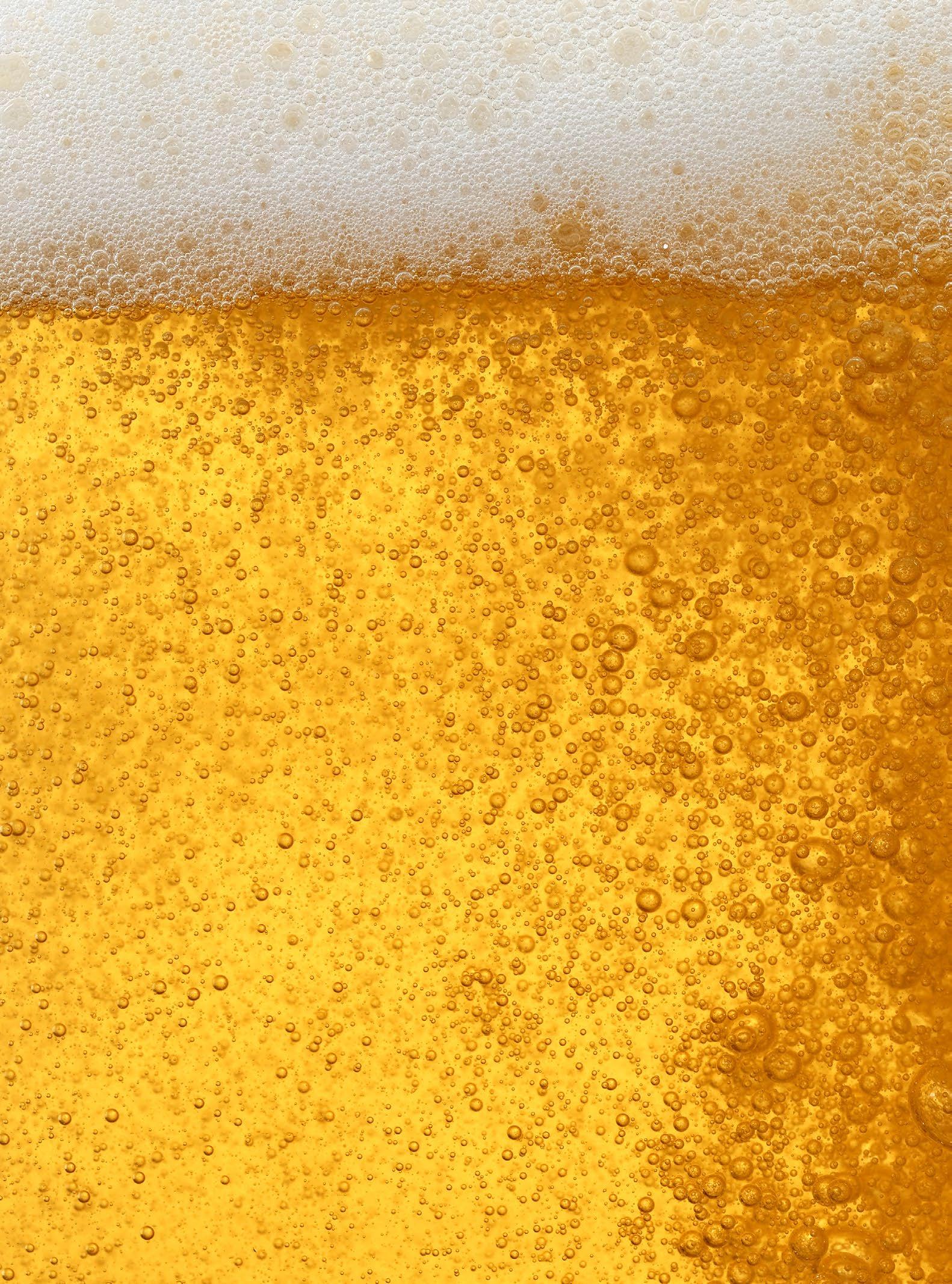
Breweries
There are 1,388 breweries in Germany, the most per capita in the world. Some 70% of them are in Bavaria, Baden-Württemberg and North Rhine-Westphalia. The number of breweries is growing gradually in Berlin as well, mostly due to the spread of microbreweries that produce craft beer.
Brewing Statistics
In 2016, Germany produced 95,600 hectoliters of beer, the most in Europe. In second place is Russia (81,600) followed by Great Britain (41,200) and Poland (39,800). Germany is fourth in the world after China (492,100), the US (225,900) and Brazil (140,400).
Exports
MORE THAN 1.69 BILLION LITERS OF GERMAN BEER ARE EXPORTED ANNUALLY. THE BIGGEST CONSUMERS ARE ITALY, FRANCE AND THE NETHERLANDS, WHICH ARE AHEAD OF CHINA AND THE US.
Unusual Statistics
There is a stereotype that Germany is the world’s biggest beer drinking nation. However, it leads neither in Europe, nor in the world – this distinction belongs to the Czechs.
On average, each Czech drinks 144 liters of beer annually, while a German drinks 107 liters.
THE TOP THREE
HACKER-PSCHORR
Type: Oktoberfest Märzen
Alcohol content: 6%
Hacker-Pschorr Bräu GmbH
brewery, established in Munich in 1417, 99 years before the Beer Purity Law.
SCHNEIDER WEISSE TAP 6
Type: Weizenbock
Alcohol content: 8.2%
Producer: Weisses
Bräuhaus G. Schneider & Sohn GmbH
AUGUSTINER HELLES
Lager type
Alcohol content: 5.2%
Producer: Augustiner-Bräu, brewery established in Munich in 1328.
ANNUAL BEER CONSUMPTION IN GERMANY HAS BEEN DECREASING BY TWO LITERS PER YEAR ON AVERAGE RECENTLY. GERMANS DRINK MORE MINERAL WATER, OF WHICH THEY CONSUME 150 LITERS A YEAR ON AVERAGE.
BEER 102 VOYAGER 9/2017
MOST COMMON VARIETIES –PILS OR WEIZEN?
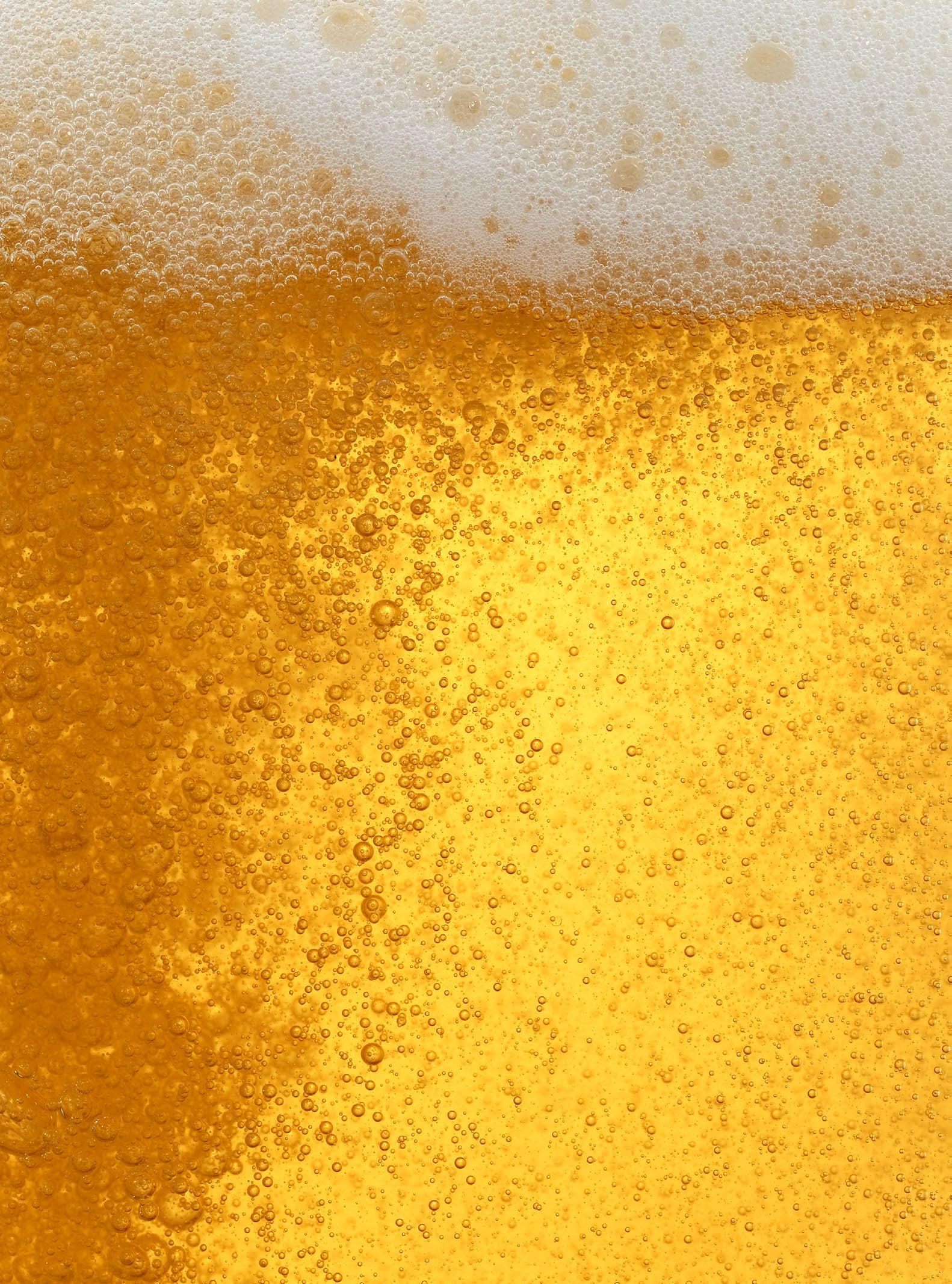
Pils is the most popular type of beer in Germany. It makes up 70% of the market in the north of the country.
It is transparent, golden-amber colored with a bitter hoppy taste. It has many fans in Western and Eastern Germany as well. The beer is named after the Czech city of Plzen, where the quality of the beer was so low in the middle of the 19th century that a group of citizens decided to build a brewery. The main brewer was Bavarian Josef Groll, who brought bottom fermentation to Plzen. In bottom fermentation, yeast sinks to the bottom of the barrel after fermentation (initially, high fermentation was used in brewing, with the yeast remaining in the upper part of the liquid). Pils is served in a tulip-shaped glass.
Make sure to try new German craft beers. Today, many small breweries are circumventing the Beer Purity Law. A new wave of experimenters – rebellious brewers of independent beers – has invaded Germany from the United States and Scandinavia. These are fashionable brands operating in big cities whose products offer an alternative to main-
stream brands. The main ingredients are barley, hops and yeast (though flavored), but one can taste citrus, southern fruits or get the aroma of red berries.
If a beer contains fruit or spices, will the Beer Purity Law tolerate it? Perhaps it will make some exceptions. Brands such as Leipziger Gose and Berliner Weisse enjoy special status, but not in Bavaria, where the purity rules are strictly guarded. Nonetheless, the number of the innovative craft brewers willing to throw a glove in the face of the 500-year law is increasing. Berlin, the capital of Germany, is trying to become the epicenter of the craft movement.
REGIONAL BEER VARIETIES

Weizenbier (wheat beer), also known as white beer, has spread through Germany, moving from the south to the north. It is regarded as the most Bavarian of beers and has a long history. It gained a foothold in Bavaria as far back as the 1st century A.D. The situation has changed almost immediately after hundreds of years. In 1567, the ruler of Bavaria prohibited the production of wheat beer, saying that "this beverage is useless," as it "creates a desire to drink it again and
again." In fact, the rulers did not want to use up valuable wheat to brew beer. However, the Bavarian Kurfursten retained the privilege for themselves, and wheat beer became the source of their wealth.
There is no ban on wheat beer production today. Due to its characteristic fruit aromas and carbonic acid, this beer is especially popular in summer. It is served in tall, slightly curved mugs, and pouring the beer is an art on its own.
Lager, also known as Bayrisch Hell, is very popular in southern Germany, primarily Bavaria. This beer contains only a small amount of hops, and it sweeter and filtered, which is why it is called “Hell” or "light".
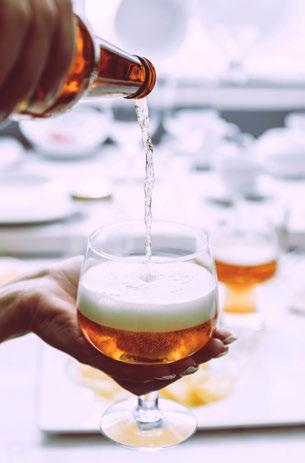
On the Rheine, you will encounter at least two local varieties - Kölsch (from Cologne) and Alt (from Düsseldorf). According to the Kölsch-Konvention Treaty of 1986, Kölsch can only be produced in 24 breweries in and around Cologne. Altbier is mainly brewed in Düsseldorf. Its production is based on the traditional top fermentation method. The amber-colored drink has a bitter taste and is very
pleasant to consume. Berlin has its own type of beer as well, which has regained popularity recently. Berliner Weisse is sparkling and slightly sour. It has been produced since the 16th century and is mixed with raspberry or woodruff syrup and consumed through a straw.
WHEN ORDERING A BEER IN GERMANY, MAKE SURE TO POINT OUT WHICH TYPE OF BEER YOU WANT, OR IF NOT, YOU WILL BE SERVED A WEIZENBIER IN MUNICH, KÖLSCH IN COLOGNE, ASTRA IN HAMBURG AND ALT-BIER IN DUSSELDORF.
103 VOYAGER 9/2017
"Oktoberfest" is the biggest celebration in the world; the capital of Bavaria even declares a state of emergency for the period. 6.4 million guests from different countries travel to Munich for this holiday.

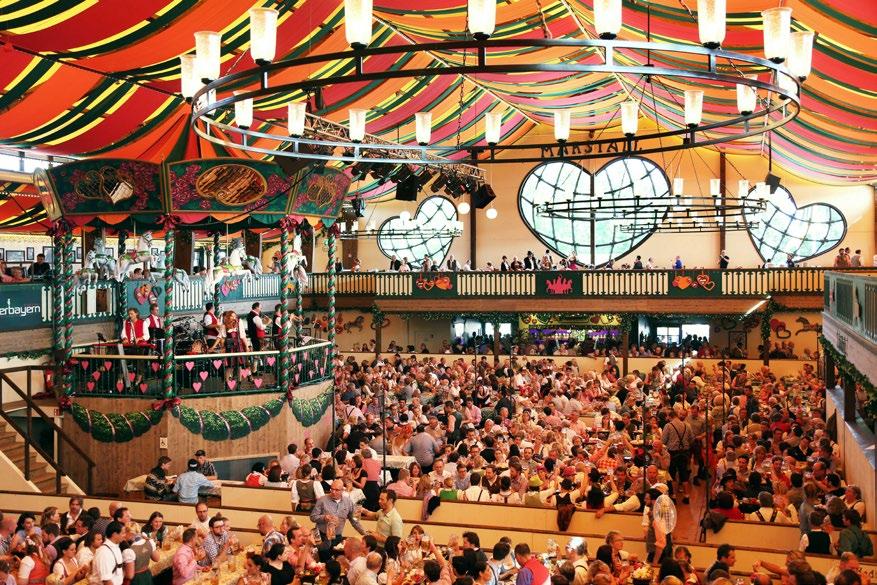
The celebration has been held for 200 years on Theresienwiese and goes on for 17 days. The Munich breweries create beer specially for these days. This year, 6.2 million visitors consumed 7.5 million liters of beer.
The first "Oktoberfest" was held in 1810 to mark the wedding of the
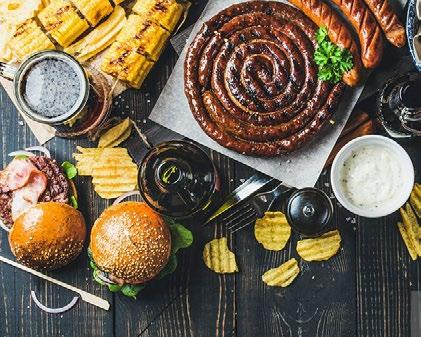

OKTOBERFEST
Prince of Bavaria, Ludwig and Princess Therese of Saxony-Hildburghausen. On that occasion, the festival began on October 12th and lasted for five days. Since than it has been held annually and since the September nights are warmer, it was moved to that month of the year.
The Munich locals call "Oktoberfest" "Die Wiesn" due to its location, Theresienwiese. The territory of the festival is 34.5 hectares. This year, 545 businesses took part in the festival.

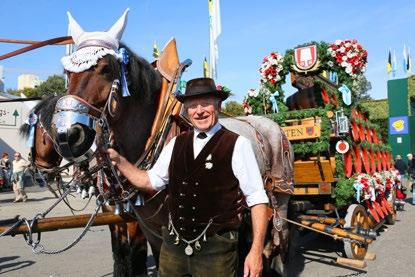

If you look at the official beer prices of 2017, The Mass or a liter of beer costs about 10.60-10.95 €. Compared to the previous year, the price has risen by 2.55%.
As a rule, the price of beer increases significantly every year, although it is unusual for the price of non-alcoholic drinks to increase as well.
THE RULES
• Many guests wear traditional folk clothes during the festival. Men wear leather pants and checkered shirts, women Dirndl dresses.
• If you plan to visit "Oktoberfest" in traditional Bavarian garments, be aware: you cannot wear sports shoes with these clothes.
• The rural leather trousers are best paired with low-rise travel boots; women should avoid high heels – dancing will be challenging.
• If you decide to wear a Dirndl, keep in mind: if the left ribbon of your dress is untied, it means you are open to a new relationship.
TRADITION 104 VOYAGER 9/2017
TRADITIONAL COSTUMES
DIRNDL AND LEATHER PANTS ARE THE REAL DRESS CODE OF "OKTOBERFEST" (AND NOT ONLY THAT FESTIVAL). THESE CLOTHES HAVE LONG BECOME MORE THAN JUST "TRADITIONAL COSTUME". IT IS A FASHIONABLE TREND TO WEAR THEM TO VARIOUS PARTIES, NOT ONLY IN THE SOUTH OF GERMANY BUT IN THE NORTH OF MAIN AS WELL. IN THE PAST, THESE BEAUTIFUL GARMENTS WERE EVERYDAY CLOTHES WORN BY RURAL INHABITANTS AND THEIR SERVANTS, BUT IN THE LATE 19TH CENTURY NUMEROUS TOURISTS APPEARED IN THE ALPS DRESSED IN DIRNDL AND LEATHER PANTS. THIS EMERGED AS A KIND OF PLAYFUL SUMMER GAME FOR THE RICH; IN ADDITION, WALKING IN THE HEAT IN COMFORTABLE SHORTS AND A LOW NECKLINE WAS MORE ENJOYABLE THAN A TAIL COAT AND LONG DRESS.
FEMALE COSTUME
Traditionally, the German national female garments consisted of a corsage and a blouse, a gathered skirt and an apron. In some areas, for instance in Hessen, women used to wear several skirts of different lengths simultaneously. On the eve of the 19th-20th centuries, the Bavarian women wore long dresses instead of skirts.
Today, the national German female clothes are divided into two types: Trachten and Dirndl. Dirndl is made up of a bra, a wide blouse, a corset (or vest), a gathered skirt, an internal underdress and an apron. The apron is usually decorated with embroidery, ribbons and lace. Historically, it was important where the ribbon was placed: widows placed it in the middle, singles on the left side and married on the right.
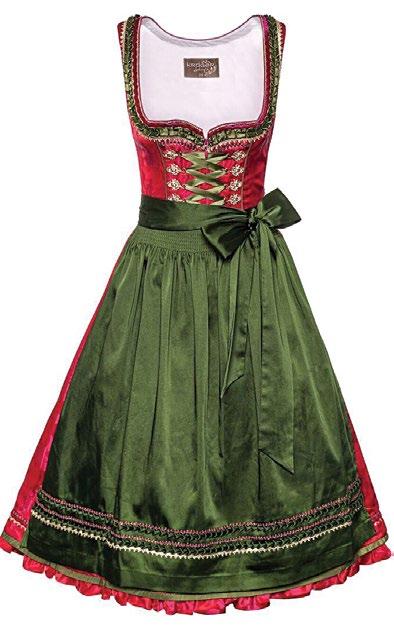
MALE COSTUME
Men's national clothes are diverse and interesting. Leather pants (Lederhose) are available in two types: short (Kurz Lederhose) and three-quarter length (Kniebund). It is accompanied by a shirt, a jacket, a frock coat (Loden), a feathered or furred hat (Seppel), gaiters (Leferl) and thick-bottomed, short-rise boots.
The length of a man's frock coat denoted his marital status. Married men wore long black coats, and singles wore short ones. One attribute of the male costume is a short dinner knife (Trachtenmesser), which has a dedicated pocket sewn on the right side of the pants. The pants have a special compartment in the front which is closed by two buttons. Usually it is decorated with the same embroidery as the knife pocket. The pants are supported by braces connected to the pants by buttons, and special length adjusters on the chest.
The braces may have a badge or small strings in their frontal part that are tied around the waist. The badge is often embroided with ornaments, for example, a Bavarian coat of arms (a shield, decorated in white and blue diamond rhombs of the Bavarian flag, held by two lions). The material of the braces is also decorated with colored ornaments, usually dominated by the mountain Edelweiss. The vests usually have an opening in the front so that the badge of the suspenders is attractively visible. Hats have narrow brims, and are adorned with twisted strings, and the feathered or furred decoration according to hunting traditions represent the whiskers of a killed bear. In the past, the low-rise shoes were worn on naked feet. Presently, the gaiters (Leferl) have turned into light "golf socks" as they have lost their past hunting functionality.
BAVARIAN LOCALS OFTEN WEAR TRADITIONAL COSTUME AS PART OF THEIR DAILY OUTFIT, APART FROM FESTIVAL OCCASIONS. IT IS CONSIDERED AN INDICATOR OF A GOOD TASTE AND IS PRESTIGIOUS. THE NATIONAL COSTUMES ARE QUITE EXPENSIVE - ONE SET IS WORTH 700-800 €.

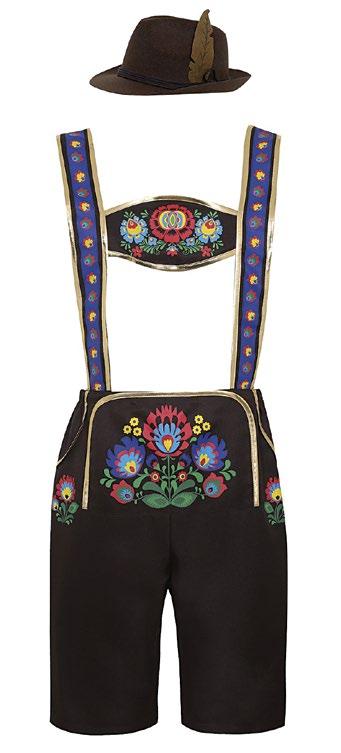
105 VOYAGER 9/2017
THE CAPITAL OF THE FREE STATE OF BAVARIA, MUNICH (1.4 MILLION INHABITANTS) IS THE THIRD LARGEST CITY IN GERMANY.
MUNICH IS THE CENTER OF GERMAN DESIGN, FASHION AND STYLE. IT HAS THE BEST HOTELS, RICH MUSEUM COLLECTIONS, BEAUTIFUL PALACES AND GARDENS, AND A RICH VARIETY OF ARCHITECTURAL MASTERPIECES AND GASTRONOMIC FINDINGS.

BEER AND FOOTBALL ARE STEREOTYPES ASSOCIATED WITH MUNICH; IN ADDITION, GERMAN CARS ARE ESPECIALLY VALUED HERE, AND THUS THE CITY IS CONSIDERED A "PARADISE FOR MEN".
FRAUENKIRCHE
St. Mary's Cathedral in the center of the city is a symbol of Munich. Its beautiful, onion-shaped towers can be seen from afar.
MÜNCHEN
MARIENPLATZ/NEUES RATHAUS
From 1158 onward, the New Town Hall Square, adorned with the Mary’s Column and the fountain, has been the center of the city. Hundreds of people watch the Neues Rathaus Glockenspiel every day –a performance by mechanical dolls.
The town hall clock, with 43 rows and 32 figures of human height, displays images of medieval life. There are 400 rooms
in the 10,000 sq.m. building. The city council has been housed here since the late nineteenth century. The XV-century town hall stands by the building. It is an example of late Gothic architecture, the main part of which is the Toy Museum.
You can climb the tower on Monday-Friday, 10 a.m. – 7 p.m.
Marienplatz 8

ALLIANZ ARENA

Frauenplatz 12
BAYERISCHE STAATSOPER
The twice-destroyed and rebuilt National Theater building is erected in the classical style of an ancient Greek temple. It is the home of the Bavarian State Opera as well as the State Ballet. This is where you will find amazing opera and ballet performances.

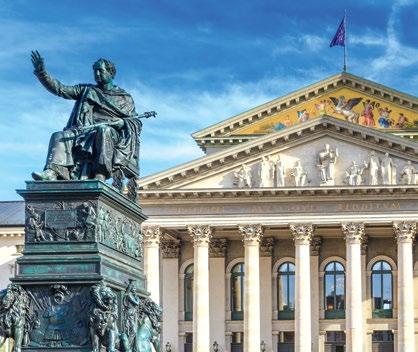
Max-Joseph-Platz 2
The stadium designed by the architectural firm Herzog & de Meuron is the domain of the FC Bayern München and TSV 1860 München football teams. Construction commenced in 2002 and the first games were held in 2005. In the 2006, World Cup semi-final, Portugal and France played each other here. The stadium has 3 terraces and 69,901 chairs under its roof. Fans can find different stores open in the stadium. Open: every day, 10 a.m. – 7 p.m.
Werner-Heisenberg-Allee 25
106 VOYAGER 9/2017
The building is designed in a late Gothic style, erected in the XV century. Art masterpieces of the last five centuries are housed here.
ODEONSPLATZ / THEATINERKIRCHE
Theatinerkirche St. Kajetan, an Italian baroque-style church, with its stone lions and bronze statues of Bavarian a commander-in-chief (the exact copy of the Florence Lanzi Gallery) and the Café "Tambozi" (Munich's oldest coffee shop) makes one think of Italy.

Theatinerkirche St. Kajetan's colorful yellow architecture is decorated with magnificent copper domes, beautiful against Bavarian blue sky.
ALTER HOF
FRIEDENSENGEL
The "angel of peace" overlooks the city from a height of 38 m. The pillar was completed in 1899 at the end of the German-French War and on the 25th anniversary of the Versailles Peace Treaty.

Prinzregentenstraße
KARLSPLATZ STACHUS
One of the main squares of Munich is officially named after Karl Theodor, and unofficially after Eustachius, in honor of the legendary brewery, Sankt-Eustachius.
Karlstor gate is the beginning of the Munich pedestrian zone and the square is always crowded.

The Eustachius fountain draws travelers on hot summer days. Almost all types of city transportation come here. 160,000 people visit the underground shopping center every day. It's the biggest in Europe.
Karlsplatz 1
Munich’s Alter Hof (Old Kingdom Country) is the oldest building in the city (XIIc). The former residence of Ludwig IV, the Emperor of the Holy Roman Empire, it consists of five wings. During World War II, Alter Hof was destroyed but in the 1950s it was restored according to old blueprints. The palace’s north arch features Renaissance-style architecture. It used to hold stables and a collection of artifacts collected by Duke Albert V.
Open: Monday-Saturday10.00 a.m. - 6 p.m. Entrance is free.
Alter Hof 1
WESTPARK
This beautiful park was created in 1983 for an international gardening exhibition. The green area of 60 hectares is famous for its unique rose garden, with over 20,000 varieties brought in from 500 countries. The park has a lake, summer theater, fountains and a German home from the XVIII century, which was transported from an ethnic museum. Here you will find Chinese and Japanese gardens also.
Preßburgerstr. 35
ALTER PETER
Built in the XI century, St. Peter's Cathedral is the oldest church building in Munich. You will see a fantastic view from the top of the tower; in good weather you can even see the Alps.


ENGLISCHER GARTEN
One of the largest city parks in the world, Munich’s English Garden is 4.17 sq. km. It was created in 1792 by the architects von Schell and Sir Thompson. One of the main attractions of the English Garden is the Chinese tower, with a 7,000seat Beer Garden nearby. Monopteros, a round, Greekstyle construction (1836), offers unforgettable view.
Englischer Garten 3

107 VOYAGER 9/2017
Rindermarkt 1
SIGHTSEEINGS / MUNICH
GLYPTOTHEK
The Glyptothek and Museum of Ancient Art is an important repository of ancient Egyptian artifacts on Konigsplatz.


SCHLOSS NYMPHENBURG
The 500 sq.m. magnificent structure with its beautiful garden and museums transports visitors to the era of the Bavarian monarchy. This was once the domain of the House of Wittelsbach.

Visitors especially enjoy the royal stables and unique collection of carriages, the porcelain museum, the mirror hall, the park with water cascades, the small lakes and the palace pavilions.

Schloß Nymphenburg 1
SCHLEISSHEIM SCHLOSS
The old and new structure of the palace is located north of Munich.
The old palace, built in 1623, is a fortress of the late Renaissance period; a new fortress was built in the XVIII century, and provided a refuge from the daily affairs for Wilhelm V, the Duke of Bavaria.

MUNICH RESIDENZ


This palace is located in the central part of the city. It was built and rebuilt several times over five centuries. This stunning complex is among the most magnificent buildings of Europe and preserves an impressive treasure. The Munich Residence served as the seat of the government and the residence of the Bavarian dukes, electors and kings.
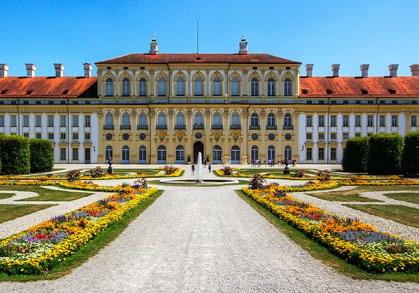
Residenzstraße 1
Open: 09 a.m.-6 p.m. Closed on Mondays.
Transport: Munich S-Bahn # 1 (direction from Freising / Flughafen to Oberschleißheim, the palace is 15 minutes walking distance from the stop); Also, the bus: 292 or 295, stop at Schloss.
Max-Emanuel-Platz 1
The 13 rectangular, square and round halls surround the interior courtyard. 12 ionic columns adorn the front entrance. The front part is devoted to the goddess Athena; the outer walls are decorated with sculptures in the niches. Here you can see the ancient Greek collection of sculptures gathered by King Ludwig I.
The most important exhibit is the Bareberini Faun, (200 BC) made by an unknown artist from the Pergamon school. Open: Tuesday-Sunday - 10 a.m. – 5 p.m., Wednesday - 10 a.m. – 8 p.m.;
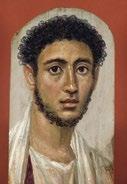
Price: 3.50 €
Königsplatz
DEUTSCHES MUSEUM FÜR WISSENSCHAFT UND TECHNIK
Engineer Oscar von Miller founded the museum in 1903. It is the world's largest, covering 73,000 sq.m. The collection consists of 28,000 exhibits. 1.5 million people visit the museum annually.

A planetarium presents star maps. There are over 50 thematic exhibitions in the museum - musical instruments, and items of telecommunication, chemistry, physics, shipbuilding, aviation engineering and etc.
Open: every day - 09 a.m. -5 p.m.
Price: 8.50€
Museumsinsel 1
108 VOYAGER 9/2017
BMW WELT, MUSEUM & WERK

Here you can see BMW's amazing achievements. BMW Welt invites you to the world of the latest technologies and quality, offering ultra-modern architecture and innovative constructive solutions: you can see BMW, MINI and Rolls-Royce Motor Cars.
The museum was opened in 1973 and tells the 90-year history of the business and introduces visitors to retro mobiles and future cars. There are 26 themes in the exhibition, including history, design, technical innovation, motorsports and more.

A unique collection is situated in seven halls and comprises more than 125 models. Here, in the factory you will see how the premium cars step off the conveyer.
BMW Welt
Am Olympiapark 1
Open: Everyday – 9 a.m. – 6 p.m. Entrance for free.
BMW Museum

Am Olympiapark 2
Tuesday-Sunday – 10 a.m. – 6 p.m. Closed on Monday.
Price: 10€
www.bmw-welt.com
PINAKOTHEK DER MODERNE

This is the largest museum of contemporary art in Germany, where every school is represented: expressionism, fauvism, cubism, surrealism, abstract expressionism, pop art and minimalism - from Henri Matisse to Salvador Dali.

NEUE PINAKOTHEK
Open: Tuesday-Sunday10.00 a.m. -6 p.m. Closed on Monday. Price: 10€
Barer Straße 40
ALTE PINAKOTHEK
This is Munich's most famous gallery with a large collection of German paintings (XIV-XVII) and works by Dutch artists (XIV-XVII); it houses the largest collection of Rubens' work; paintings of all the schools of the Italian renaissance and
baroque (XIII-XVII) periods; and French and Spanish art (XVII-XVIII). Here you will find masterpieces by Kranach, Botticelli, Da Vinci, Rafael, and Titian. The 800 works of art are displayed in 19 halls and 47 rooms.


Open: Tuesday-Sunday - 10 a.m. - 6 p.m. Closed on Monday. Price: 7€
Barer Straße 27 (entrance from Theresienstraße)
Munich's new Pinacoteca was founded in 1853 by Ludwig I, the King of Bavaria, to make his collection available to the public. Thus, this space was the first modern art gallery in the world. It presents works of the late XVIII century onwards – 3,000 canvases and 300 sculptures, 400 of which are part of the permanent exhibition. The list of artists is impressive: Goya, David, Gainsborough, Reynolds,
Van Gogh, Manet, Klimt, Ensor, Schiele, Thorvaldsen, Rodin, Mayol and many more. The gallery’s collection is constantly being enriched. Open: Everyday, except Tuesday - 10.00 a.m. - 6 p.m., Wednesday - 10 a.m. - 8. p.m.

Barer Strasse 29
MUSEUM BRANDHORST
Munich's new art museum is located near the Pinacoteca, built by the architectural bureau Sauerbruch Huton. The facade is fitted with 23 different colors of ceramics with narrow tiles. Inside,

there are extensive white halls, which daylight enters through a special construction. The main part of the collection is the works of the modernist and post1945 periods; the following artists are exhibited here: Joseph Beuys, Damien Hirst, Sigmar Polke, Andy Warhol and Cy Twombly.
Open: Tuesday-Sunday - 10 a.m. - 6 p.m. Closed on Monday. Price: 7€
Theresienstraße 35a
109 VOYAGER 9/2017
MUSEUMS / MUNICH
VIER JAHRESZEITEN KEMPINSKI

The hotel has luxurious rooms and suites - all of them are designed in the classical style with modern touches. The day spa offers beauty and cosmetic procedures. The swimming pool is a place where you can enjoy Munich's beautiful views.
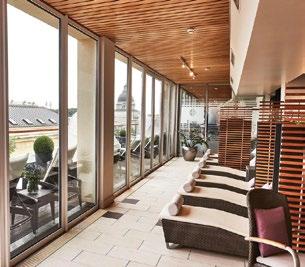


BAUERISCHERHOF
Located at Munich's historical center, Hotel Bauerischehof offers 337 rooms, 5 restaurants, 6 bars, unforgettable spas and a concierge service. The 2-star restaurant Atelier Silent Garden presents high cuisine culinary masterpieces; Palais Keller offers traditional cuisine; and Trader Vic's exotic cuisine.

Falk's bar makes signature cocktails, while Polar is known for its open veranda – the lunch area of Munich in the winter.
In addition to its famous Octoberfest, Munich offers guests another Bavarian phenomenon – the Schwarzreiter Restaurant. The concept of the restaurant was inspired by the legendary gourmand and culinary pioneer, Ludwig II, the king of Bavaria. Wild green salad, tartar or grilled meat – all the dishes are delicious.
The restaurant is open from Tuesday to Saturday evenings and offers the best Bavarian cuisine. The dishes are prepared with seasonal, fresh ingredients that are modern and at the same time inspired by tradition.
The Schwarzreiter Tagesbar offers light glamorous drinks. This is a wonderful place to spend an evening with friends.
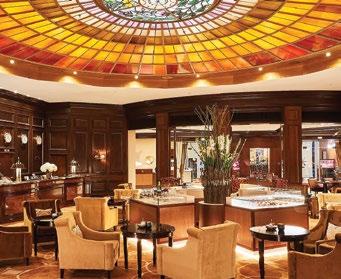
Price: 300€
Maximilianstrasse 17
COMMENT
WEISSWURST – this is a veal sausage, which is traditionally served for breakfast. Do not order Weißwurst in the afternoon because the Bavarians respect traditions. Enjoy it until 12 p.m. in the afternoon, with pretzels and weißbier (wheat beer).
Blue Spa — You do not have to be a resident of Hotel Bayerischerhof to enjoy the spa treatments. Relax, enjoy a massage, and swim in the pool.

We recommend the Blue Spa Bar & Lounge. There are a lot of delicious dishes, including a tri-tip steak (beef sirloin with savoy cabbage and truffles, potatoes and squash sauce).Standard room price: starting at 350 €. Promenadepl. 2-6
MÜLLERSCHES VOLKSBAD
Müller Baths are located on the right bank of the Isar River, built in jugendstil with baroque elements (1897-1901). There are two swimming pools with Roman-Irish steam baths, spas and hydro massage. This building is among the most beautiful closed pools in Germany. Open: every day - 7.30-23.30. Price: 4€
Rosenheimer Str. 1
BARBER HOUSE
A perfect salon for bearded men who want to be served by men only. You will not be surprised to find that all of the staff have beards; all of them wear a special uniform and provide the highest level of service. You will think that you have been transported back to the 1920s. The place is frequented by both hipsters and business people.
Pacellistraße 5
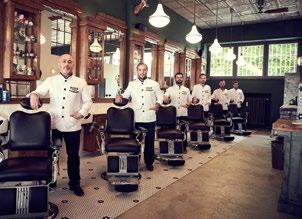
110 VOYAGER 9/2017
BRASSERIE COLETTE
The Tim Raue restaurant offers Asian-inspired dishes. Here you can enjoy duck confit (confit de canard) or the best chicken in Munich, with pasta and truffles, hazelnuts and topinambur.
Klenzestraße 72
ESSZIMMER BY KÄFER
This high-class, elegant restaurant with delicious Bavarian cuisine and brilliant methods of wine selection is located on the fourth floor of the BMW "Empire".
Bobby Bräuer’s culinary masterpieces and somelier Frank Glüer’s recommendations and services will make your dinner unforgettable.
Am Olympiapark 1
SCHUHBECKS SÜDTIROLER STUBEN
This is the restaurant of Bavaria’s most famous chef. In Munich, his empire now includes the restaurant Südtiroler Stuben, a wine bar, a culinary school, a spice shop and an ice cream parlor. Schuhbecks features a variety of dishes.

Platzl 6-8
ROCCA RIVIERA
French chef Damian Plaisant serves lobsters, Fine de Claire oysters, tinus carpaccio, Charolaise with bones - these dishes are real stars, just like the restaurant’s guests.
Wittelsbacher platz 2
BEER-GARDEN
The beer garden is not just a public space where you can sit down and drink beer but also a cultural phenomenon – a place to meet and talk in the open air and a playground for children. The beer gardens are self-service, so get Mass Hells (one liter of light colored beer) or (if you are with a friend) zwoa Mass Hells (two liters); if you are
hungry, we recommend traditional dishes: Wurstsalat (sausage and onion salad), Brezn (pretzels), Radi – pickled radishes, un halbs Hendl – half of a grilled chicken; and Obadza – cottage cheese with camembert, plums and pepper.
In the summer, the beer gardens are full of people. Have a good look at the tables and you will find a free space. Share your food with others – this is the main advice. And one more important recommendation: never sit at the Stammtisch, the table of permanent patrons, which they may have been occupying for years.

Ambar Bistro – I recommend visiting this bistro on the Tegernseer Landstraße 25, where delicious craft beer and Italian cuisine are perfectly combined.
Biervana – Schwabing and Hohenzollernstraße 61 are wonderful places: here you will be offered MÜNCHNER, traditional, low-fermented beer with a strong barley flavor, the world-famous DUNKEL's dark beer, lager, weiss and so on.
GEISELS WERNECKHOF
The restaurant, located between Leopoldstrasse and English Garden, is a magical place with a classic Bavarian interior created by the internationally recognized chef, Tohru Nakamura. The flavor combinations are amazing: octopus with kimchi, eel, mango and green papaya. Werneckstraße 11
DALLMAYR
The cozy, diverse restaurant offers distinguished yet delicious food and is a favorite place for locals, which you should visit. A nearby café-bistro offers nice coffee and chocolate, while the Dallmayr Delicatessen store impresses even the most experienced gourmands.
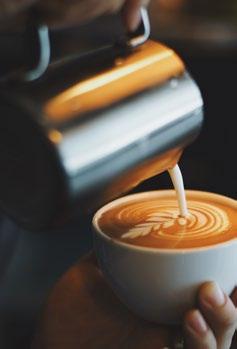
Dienerstraße 14
Munich is often referred to as the North Italian city, perhaps because locals love coffee, especially espresso and cappuccino. Usually bars offer only two versions of coffee - Schwarzkaffee (Black Coffee) and Milchkaffee (with a little milk). But there are many Italian bars in Munich with the best culture of coffee brewing.
NEUHAUSER AND KAUFINGER STRASSE, LOCATED IN THE MIDDLE OF MUNICH, ARE GERMANY'S MOST CROWDED STREETS. THEY CONNECT THE TWO SQUARES - MARIENPLATZ AND STACHUS OR KARLSPLATZ. THE EXISTING 750 M IS ONE OF THE BEST SHOPPING VENUES. REMEMBER, THE REAL PEARLS ARE HIDDEN IN THE SIDE STREETS. MUNICH SHOPS ARE OPEN FROM MONDAY TO SATURDAY FROM 9 A.M. TO 8 P.M. MOST ARE CLOSED ON SUNDAYS.
BOGNER
The Bavarian world-renowned fashion brand Bogner is a sports fashion trendsetter. It was founded in 1932 by Willy and Maria Bogner. After World War II, the couple worked hard and proved that sportswear is the future of fashion. Willy Bogner was the winner of the 1935 ski championship, and with the efforts of his wife Maria, the firm became a global empire. They made their first appearance in 1948, and by the 1970s Maria was called the "Coco Chanel of sportswear". In the 1950s, they created elastic ski pants, the so-called “bogners”, worn by many film stars, including Marilyn Monroe and Ingrid Bergman. In 1955, the famous silver “B” appeared on the clothing line.
Residenzstraße 15
BAR CENTRALE
This is a typical Italian bar - dark wooden walls, small tables, bicycles in the window displays, and fun Italian guys brewing great coffee. Guests drink coffee on their feet, just as they do in Italy.
Ledererstraße 23
111 VOYAGER 9/2017
RESTAURANTS / MUNICH
HAMBURG
TEA SKHIRIELI
With a population of 1.8 million, Hamburg is the second-largest city in Germany and the richest. This is not just a city but a city-state – it is "the Free and Hanseatic city". It is independent and dignified, carrying on the spirit of the late medieval times.


The historic center of Altstadt is the splendid face of this ‘Northern Venice’, with romantic homes standing on the water and and impressive art-nouveau buildings lining Jungfernstieg, Neuer Wall and Spitalerstrasse streets.
HafenCity, once a suburb, has become the second heart of the city thanks to several big, modern projects. This is the largest and most impressive European urban modernization project. The district was added to the UNESCO World Heritage list in 2015.
This city-state of Northern German and gateway to the world (Tor zur Welt) is submerged in constant greenery and has a permanent flow of water. All its streets lead to the water or bridges, which existed here even 2,500 years ago.
Water and Hamburg are inseparable. To know this place better, visit the harbor, which is the beating heart of the city and where ships from around the world are anchored. Here, you’ll feel the elemental force of the North Sea, the great world, the enormous space to which this city of proud merchants has been connected from time immemorial.
Always open to the world, Hamburg is Germany's largest cruise port. This is where Alfred Ballin created the first cruise ships in the late 19th century. Hamburg's inhabitants are often called "Hansans". The Hanseatic League (Deutsche Hanse) was a political-economic union in the 12th-17th centuries, connecting more than 300 cities.
Wherever you decide to go - to the shore, to Speicherstadt, fishermens’ markets, to the port city of Hafencity or Reeperbahn - you will be amazed by Hamburg's diversity. On the one hand, there are colorful and poor areas such as Saint Pauli and Reeperbahn. On the other hand, Blanekenese has luxurious villas, romantic landscapes, and busy river beaches. Also, amid the glass facades of HafenCity, Hamburg is varied, restless but still harmonious.
This city offers great works of art, sophisticated theatrical performances, famous musicals, a wide variety of hotels, magnificent restaurants, luxurious shopping areas, a big selection of exciting nightlife, and most importantly, unique historic sights and a 1,200-year heritage.
THIS COSMOPOLITAN MEGAPOLIS IS BOTH OLD AND YOUNG, VERY MODERN, VERY CHARMING AND YET CONTROVERSIAL. AN UNBELIEVABLE FEELING OF LIFE’S COMPLETENESS IS ANOTHER OF ITS DISTINCTIVE FEATURES, SOMETHING THAT EVERYONE SHOULD EXPERIENCE.
112 VOYAGER 9/2017
SPEICHERSTADT
The largest warehouse district in Europe, with centuries of history, is located in the free port. Everything from coffee, tea, cocoa, spices, tobacco and computers is stored here. There is no larger warehouse of oriental carpets in the world than the one in Speicherstadt. It is an unexpectedly romantic setting behind thick walls, created by dried canals, Gothic buildings, and amazing gables and watch towers.
ST. PAULI, REEPERBAHN
Maritime romance is as integral a part of Hamburg's history as the Great Fire of 1842. Nowadays, apart from the Reeperbahn, with its ‘night butterflies’, stripshows and sexshops, the St. Pauli quarter has become a home to alternative culture. The best clubs and discos in Hamburg are here.


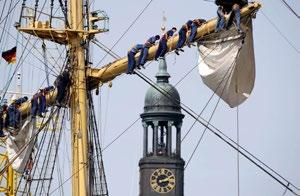

ELBPHILHARMONIE

This unusual, eye-catching concert hall opened in 2017. Its optimal acoustics attract many visitors from around the world.
This red brick and glass ensemble is the new symbol of the city. In the past, the site was the world’s largest warehouse complex.
PORT
Every year around 13,000 ships from all around the world enter Hamburg's port, the second largest in Europe. Be it the cruise terminal or historic Speicherstadt (warehouse district), boat harbors or modern container port, the air is full of freedom and the aromas of faraway lands. Today, in this port founded on King Friedrich Barbarossa’s orders in 1189, there are 300 docks, and 160,000 people work here. The port brings in €21.8 billion to the German economy annually.
BLANKENESE
Today, Blankenese, a former fishing village on the banks of Elbe, is the best place for relaxation and walking. Its picturesque lanes, winding staircases and intertwining houses create an exotic atmosphere. The railway station street (Bahnhofstraße) is like a small independent city with its cathedral, weekly market, wonderful shops, cafes and restaurants.
Swiss architectural bureau Herzog & de Meuron’s design is an ultra-modern, wavy glass building that reflects the sky, water and surrounding landscape. It has a 2,100-seat main hall, a chamber music hall for an audience of 550, a hotel, apartments, restaurants and conference centers. You will need to stand in a line to view the interior of the building.
Platz der Deutschen Einheit 1
THE SUBURBAN S-BAHN TRAIN WILL TAKE YOU FROM THE AIRPORT TO THE CENTRAL RAILWAY STATION IN HAMBURG’S CENTER IN 25 MINUTES. HAMBURG’S RAILWAY STATION IS CONNECTED TO ALL MAJOR GERMAN CITIES (E.G., IT TAKES 90 MINUTES TO REACH BERLIN).

113 VOYAGER 9/2017
Take a boat or ferry tour on Lake Alster. It leaves from JUNGFERNSTIEG several times a day.
SIGHTSEEINGS / HAMBURG
When you visit its harbor, you will understand why Hamburg is called the Gateway to the World.
IT’S HARD TO IMAGINE HAMBURG’S PANORAMA WITHOUT THE CHURCHES AND BREATHTAKING TOWERS: ST. MICHAELIS, ST. PETRI, ST. KATHARINEN, ST. JACOBI AND ST. NIKOLAI ALL ARE NOTABLE EXAMPLES OF NORTHERN GERMAN ARCHITECTURE. KEEP IN MIND THAT BROWSING IN THE CHURCHES IS NOT ALLOWED DURING THE SERVICE (FROM 10:00 AM TO 06.00 PM ON SUNDAYS, FREE ORGAN CONCERT 12.00 PM ON DAILY BASIS) AND OTHER CHURCH ACTIVITIES.

ST. MICHAELIS
The St. Michaelis Evangelical Church (1751-1762) is considered to be the symbol of Hamburg. The cathedral, recognized as the most important religious building in Nosrthern Germany had been destroyed and renewed twice. The diameter of the largest tower clock in the country is 24 m, there is an observation deck above it, at the height of 106 m. Every day at 10.00 am and 21.00 pm, enchanting sounds of chorale can be heard from the cathedral's tower. On the second floor, there is an informative multimedia presentation which retells the 1000 years history of Hamburg from a 5-meter panoramic screen. Open: 10.00 am -07.30 pm

Englische Planke 1
ST. JACOBI
One of Hamburg's main lutheran cathedrals is located in the center of the city. Thanks to the 125-meter tower, it is visible from any point. The cathedral is full of medieval treasures. There was a small chapel at this locations in 1255. A great Gothic cathedral was constructed after that. Following the WWII, the destroyed temple was fully restored. The main pride of St. Jacobi – an organ created by Arp Schnitger in 1693 with 4 thousand pipes survived to this day. The cathedral is adorned with ceiling paintings, biblical illustrations, portraits of the pastors, three altars and stained glass windows by Crodel.
Open: every day - 10.00 am -07.30 pm
Jakobikirchhof 22
ST. PETRI
The oldest Lutheran cathedral in the city is mentioned in the documents as far back as 1195. The building was converted to the Gothic style in the 14th century. The 12th century cathedral was almost completely re-built after the 1842 fire. The medieval altar (1379-1383) and the baroque-style portal (1604-1605) have been transferred to the museums. Open: every day - 11.00 am -05.00 pm
Schillerstrasse 20
ST. KATHARINEN



St. Katharinen Lutheran church located on the banks of Elbe is the oldest of the surviving churches of Hamburg. He was considered a church of sailors. This gothic pseudo basilica with three navels was built in 1450. Only the outer walls and towers survived World War II. The rarities that can be found in the church: the Wilm Dedeke’s "The Crucifixion" (1500), two wooden statues of the 14th century, Hans Neusel’s bells (1626), a multilayered dome built on top of the tower in 1657 and a spire adorned with a golden crown, but the war destroyed a 16th century organ which was played in past by Bach himself.
Open: 10.00 am -07.00 pm
Katharinenkirchhof 1
ST. NIKOLAI
St. Nicholai Church, destroyed many times over the years, was first mentioned in 11th century documents. After World War II, only a neo gothic 147m. tall column was left from the 1863 building (architect Glibrott Scott).
Here you can see the altar mosaic by Oskar Kokoschka. The ruined part of the church was never restored to remind posterity of the war. Right next to it is the museum pavilion. Basement houses a wine museum in basement. In 2005, an observation deck at 75 m level was opened. You can take an elevator ride to the observation deck. Open: 10.00 am -06.00 pm.
Willy-Brandt-Straße 60
114 VOYAGER 9/2017
RATHAUS
In 1842 the old town hall was destroyed by fire. Construction of a new one was completed in 1897. There are 647 rooms in this beautiful building which are supported by 4000 oak stands. Even though the "Hansa" style was characterized by simplicity, the façade of Hamburg's town hall is adorned with precious decorations. There are 12 statues of Kaiser on it. On top of the main entrance there is an engraving in Latin: "Let the descendants preserve with dignity the freedom that was achieved by their ancestors."
Rathausmarkt 1
TROSTBRÜCKE
HAMBURGER KUNSTHALLE
The permanent collection of one of Germany's greatest art museums will take the visitors on a tour of a seven-century long artistic treasury - from medieval altars to modern art.
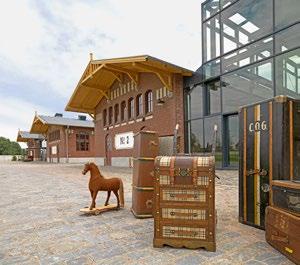


BUCERIUS KUNST FORUM
The concept of Kunst Forum was created by the Bucerius Foundation in the 1970s. It offered viewers old and contemporary art in a new
THE OLD TUNNEL ON ELBE

This well-known square structure, covered by a dome, is located near the St. Pauli district harbor. There are four large elevator mechanisms hidden beyond its walls that have been taking people and transport to the depth of 24 meters below since 1911. Two tunnels are dug here towards the south coast of Elbe, the Steinwerder Island. (Steinwerder).
This bridge, located in the old town has been connecting, Domstraße and St. Peter's Cathedral (Episcopal City) to the count’s city since 1266. The count’s city was founded by Gustav Adolf III, the count of Schauenburg, Stormarn, and Holstein.
Trostbrücke 1
The collection of the old masters consists of the Northern German (from 1400), Dutch (17th century), Italian (1350-1800) and French (17th – 18th centuries) art. Here you will find Rembrandt, Cranach the Elder, Rubens, the Romanticists of the 19th century, Cezanne, Monet, Mane, the German Impressionists and etc.
form. Four rotating annual exhibitions include 100 art pieces. They present familiar artists from a completely different angle. For example, in 2009 Matisse exhibition, the gallery curators displayed all portraits by the artist. Picasso, Kokoshka, Frida Kahlo and etc. are displayed under different concepts. One can view Mannerism and Etruscan art side by side on this exhibitions.
Open: every day - 11.00 am - 07.00 pm
Rathausmarkt 2
MUSEUM DER ARBEIT
BÖRSE
Founded in the 16th century, the building of Hamburg Stock Exchange is the oldest among such buildings in Germany. It is located near the town hall and is open to visitors.


The labor museum, located in the historic factory building, features unique machines, some of which are still in working condition; Printing workshops, accounting rooms from 1925, copper processing workshops, jewelry work tools and etc.
Open: Tuesday - Sunday - 10.00 am - 05.00 pm , Monday - 01.00 pm - 09.00 pm.
Admission price: 7.50 €
Wiesendamm 3
BALLINSTADT
The Hamburg Emigration Museum is the the very site which became the starting point for almost 5 million Europeans to travel to the "New World" during 1850-1939 period. Millions of people come here from all over the world here to seek details of their ancestors' adventures.

Veddeler Bogen 2

115 VOYAGER 9/2017 SIGHTSEEINGS / HAMBURG
MUSEUMSHAFEN OEVELGÖNNE

The harbor area contains a museum and old cargo ships and sailboats. The city takes good care of these old vessels and keeps some of them in working condition. Guests can take a tour of a small vessel or police boat.
SAMMLUNG FALCKENBERG
In 2007, Harold Falckenberg purchased one of the Phoenix halls and turned it into an exhibition space where approximately 2,000 pieces of contemporary art are displayed. The collection focuses on American and German works created over the last 30 years and on social caricatures distinguished by irony, cynicism and counterculture. Neon, illuminated works by Sigmar Polke, John Baldessari and Jonathan Meese seem like monuments drawn on the white walls of the hall.
Wilstorfer Str. 71
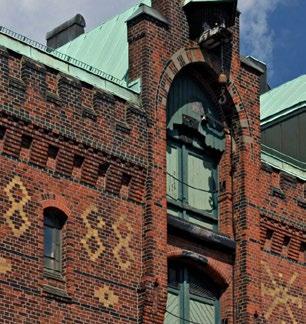
RÖMISCHER GARTEN
INTERNATIONALES MARITIMES MUSEUM

A 3,000-year maritime history is on display in this nine-story museum. There are thousands of ship models, pirate weapons, antique golden compasses and treasure from sunken ships, such as the Titanic.
Children will be very impressed by videos about sea diving, paintings of sea battles, and a six-meter high Lego model of the Titanic.
SOTHEBY’S HAMBURG

MINIATUR WUNDERLAND

This venue displays the biggest model railway line in the world. It has more than 1,000 trains with over 10,000 railway carriages, more than 400,000 bulbs and 10,000 cars.
Miniatur Wunderland is a very popular destination, so to avoid standing in a long line, book everything in advance through the website. It is better to visit in the morning or evening.

Kehrwieder 2-4/Block D
SPEICHERSTADT MUSEUM
Built in the 19th century, Speicherstadt is a real labyrinth of warehouses. There, quartermasters used to manage the inspection and storage of the precious commodities such as tea, coffee or tobacco that arrived in Hamburg. You’ll travel into the past at the Speicherstadt museum.
Am Sandtorkai 36, HafenCity
This park, located above the river Elbe, is reminiscent of an ancient amphitheater. The center of the rounded green area is used for theatrical performances. The most fascinating thing here is still the view of the river flowing in the background.
Kösterbergstraße 40E, Blankenese
PLANTEN UN BLOMEN
This fascinating, magical park features a botanical garden, greenhouse and Europe's largest Japanese garden. A small river takes you to a lake with a colorful musical fountain.

This branch of Sotheby’s has sold some of the most expensive paintings in the world, including Picasso's A boy with a pipe. The famous auction house was founded by Samuel Baker in 1744 in London. At present, it has 100 offices in different parts of the world, including this one in Hamburg. Visitors can see the
TIERPARK HAGENBECK

works in the exhibition halls before they get auctioned. Additionally, works of art can be appraised here, at no cost.

Tesdorpfstraße 22, Rotherbaum
This is Hamburg Zoo, where your little one can feed a giraffe, pet an elephant and see the Ara parrot. Monkeys, tigers and various other animals live in large open-air cages, almost in their natural habitat. The most distinctive of the wonders of the zoo is the Aquarium of Adventures, where visitors can dive into tropical waters and caves.
116 VOYAGER 9/2017
Ponton Neumühlen Ottense
Koreastraße 1
Lokstedter Grenzstraße 2
ATLANTIC KEMPINSKI
The recently renovated Atlantic has gained its place in the history of grand hotels since 1909. Over the years, it has become a favorite choice for luxury lovers traveling the Hamburg-America route.


Today, Atlantic is still famous, and there are several well-known guests who stay there regularly, including Udo Lindenberg, whose works adorn the hotel.

Room price: starting at €250
An der Alster 72-79, St. Georg
EAST
You will experience the sweet aromas of mandarin, cinnamon and jasmine in this hotel's corridors, which were designed by Jordan Mozer in strict accordance with the Feng Shui system. Meanwhile, outside, there is the typical commotion of the St. Pauli district, which makes the delicacy of the interior even more pleasant. There is a private cinema, lounges and clubs here, which is why hotel residents often stay up later than they would have wanted.
Room price: starting at €150
Simon-von-Utrecht-Straße 31, St. Pauli
GASTWERK HOTEL HAMBURG
Glass doorways and corridors create an inspiring atmosphere in this historic former coal warehouse. Red brick is harmoniously matched with carpets in studio-type rooms, while plain curtains make the enormous windows more attractive.
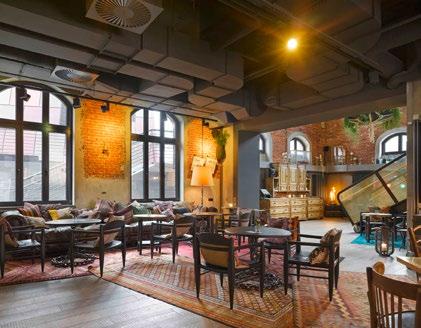
Room prices: starting at €120
Beim Alten Gaswerk 3, Bahrenfeld
HOTEL HAFEN HAMBURG
You can get to this hotel by a boat, as it is located directly by Landungsbrücken harbor, where many Elbe tourist cruise ships gather. With paintings of old ships, refined furniture and marine relics, this traditional building creates maritime associations for guests.

Room prices: starting at €130

Seewartenstraße 9, St. Pauli
25HOURS HOTEL ALTES HAFENAMT

Very often, the distinctiveness of a hotel is the small details. For example, all guests of 25Hours Hotel Altes Hafenamt unanimously agree that the local tap water is very tasty.
SUPERBUDE ST. GEORG
This hotel supports fresh drinking water development projects in Nepal. However, what attracts the eye the most is the preciously and carefully reconstructed historic port administration building. The interiors are inspired by captains’ quarters. Guests will encounter many surprises in NENI restaurant, which is celebrated in Berlin and Vienna for its Mediterranean-inspired cuisine. Room prices: starting at €140 Osakaallee 12, HafenCity

Most people will probably find the name of this hotel/hostel combination quite strange. The name – Superbude –means ‘super digs’. Astra beer boxes are used for chairs, and mouse traps have changed function and “trap” magazines and newspapers here. This hotel, known for its affordability, will let you get inside the Hansa subculture.
Room price: starting at €100
Spaldingstraße 152, Hammerbrook
117 VOYAGER 9/2017
MUSEUMS / HOTELS / HAMBURG
WASSERSCHLOSS SPEICHERSTADT

European
This magical place where you can enjoy delicious teas and sweets is located in the historic warehouse district, on an island. Here the courses are made not only with water but tea - for example, the pork fillet marinated in Rooibos tea, or green tea and polenta patty. Wasserschloss Speicherstadt has creative fish
dishes, burgers and brilliant tea menu. Each of them has its own history. You can also buy one of more than 200 tea varieties from different origins and other delicacies there.


Open: every day - 10.00 am - 10.00 pm
Dienerreihe 4, HafenCity
VLET
German
This gourmet space is located in the historic Speicherstadt district. Here you are offered novel interpretations of traditional Hamburg delicacies. The menu changes seasonally, but some classic dishes remain intact, for example, beef tartar, which will be prepared for you at your table. The meat comes from local farmers other ingredients are thoroughly selected as well. Open: Monday-Saturday - 06.00 pm -00.00 am, Closed on Sundays
Am
DIE BANK European
The interior of this restaurant is a distinct example of classical elegance with its high plastered ceiling, supported by columns, glass crystalline illumination, large wall mirrors, dark wood and leather. The building itself was built for a bank in 1897 than it was renovated, and the 1920s stayed here permanently.
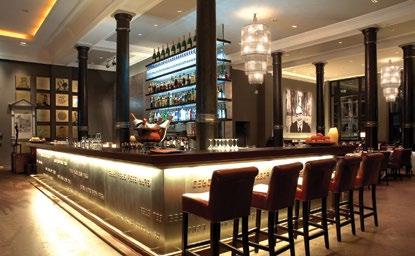
Open: Monday-Saturday - 11.00 am - 00.00 am.
FILLET OF SOUL
European
Despite the fact that the restaurant is located in the museum district of Deichtorhallen, where numerous expensive works of art are kept, you will not feel a whiff of formality here. In Fillet of Soul they talk to you frankly, while true miracles happen in the open kitchen. Young cooks offer you high-class meals, inspired by cuisines of different countries. If you have a special culinary
AU QUAI Fish restaurant
In the restaurant, you can enjoy Mediterranean cuisine "directly on the water", while looking at the bay and dockland views. The menu includes fish, meat, paste and risotto. In addition to this an affordable lunch is available from noon till 3 pm.

Open: Monday-Saturday - 05.30 pm -12.00 am, Closed on Sundays.
Große Elbstraße 145b-d, Altona-Altstadt
OFF CLUB
European
Following his first restaurant, Bul-lerei, Tim Malzer risked again and opened the Off Club. From an underground bar adorned with wooden tables and book shelves you can step into the wine cellar, which is called the "game room".
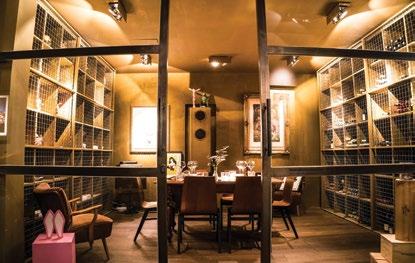


dream, it will come true here. Open: Tuesday-Sunday - 11.00 am -12.00 pm, on Monday it is closed.
Deichtorstraße 2, Alstadt
This is a private area decorated with images of cartoon characters. In the afternoon you will find delicacies in the menu: Chicken wings with hot sauce, risotto or salad. The menu consisting of several dishes in the red plush adorned Madam X saloon, change on monthly basis.
Open: Tuesday-Saturday - 06.00 pm -12.00 am, Closed on Sundays and Mondays.
Leverkusenstraße 54, Bahrenfeld
118 VOYAGER 9/2017
Sandtorkai 23-24, HafenCity
Hohe Bleichen 17, Neustadt
CLOUDS
Grill
Tanzenden Türme, located on the 23rd floor of the "dancing skyscrapers" is the most fashionable and the highest restaurant in Hamburg. Apart from enjoying the wonderful city views, the guests can also dine on meals inspired by the high class European and French cuisine. 18 gin varieties are served in a
bar with modern design, with elements of leather and wood. You will find one more bar on a rooftop with terrace, you will find another bar on the terrace, by which you can find some lounge chairs and a lounge. Make sure to reserve the table in advance.

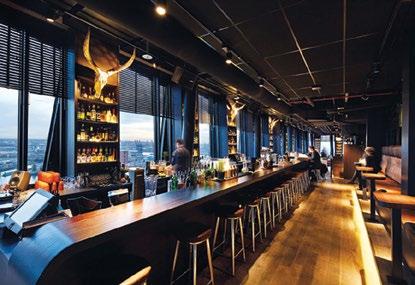
Open: every day - 05.00 pm -11.00 pm.
Reeperbahn 1, St. Pauli
(M)EATERY
Steakhouse
Meat has a prominent place in the restaurant – quite literally. You can see the meat that undergoes aging in a box through glass walls.The soft steaks from

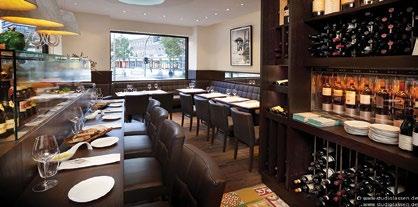


HENSSLER & HENSSLER
Japanese
The atmosphere here is distinguished by its simplicity and informality. The Japanese-international cuisine is full of contrasts - fried salmon sashimi will be served with strawberry biscuits and casserole and this is only one example of the inventive combinations of this restaurant. If you decide to dine in sushi bar, dining hall or terrace, make sure to book the place in advance.
Open: Monday-Saturday - 12.00 pm03.00 pm, 06.00 pm -1.00 pm; Closed on sundays.
Große Elbstraße 160, Altona-Alstradt
DAS SEEPFERDCHEN AM HAFEN
Fish restaurant
This restaurant, located between Fischmarkt and Altona's cruise center, directly on the Elbe walking shore offers guests to travel back in time to Hamburg’s “Hansa” period. The interior the old fish pavilion is modern but but with minimalistic design and pleasant atmosphere.
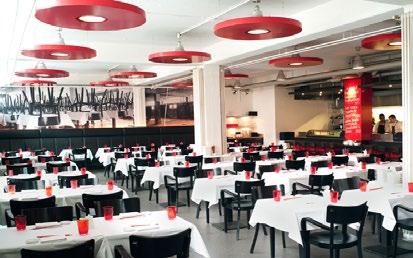
COAST BY EAST
Asian
Apart from the restaurant's convenient location, beside Marco Polo overlooking Elbphilharmonie concert hall, it is known for its distinctive cuisine.

Low carb Asian dishes, are made with excellent quality ingredients.
Fresh fish and seafood, sushi and vegetarian dishes “suit” the views very well. Open: every day - 12.00 pm10.00 pm
America, Argentina and Europe will be directly delivered to your table. There is a great choice of tartar here – you can try beef, calf, tinus and salmon tartar be combined with classical, Mediterranean, Middle East or Asian marinades. Dinner for 2 persons with a one drink: 80 €; Open: Monday-Friday - 12.00 pm -10.45 pm, Saturday-Sunday - 03.00 pm - 10.45 pm.
In a diverse menu, besides the fresh fish there is a wide selection of meat dishes regional products. You can dine at an open terrace.
Große Elbstraße 212
CORNELIA POLETTO
Italian
In 2011, the high class chef Cornelia Poletto fulfilled her dream and opened a traditional gastronomy. Italian cuisine lovers can buy various products here (cheese, spices, oils, salt, meat) as well as receive preparation instructions. The courses will be served in an eqsqusite atmosphere. The menu, which includes a list of classic and modern Mediterranean dishes, changes on daily basis.
Open: Tuesday-Saturday - 11.00 am -11.00 pm, Closed on Sundays and Mondays.
Eppendorfer Landstraße 80, Eppendor f
119 VOYAGER 9/2017 RESTAURANTS / HAMBURG
Drehbahn 49, Neustadt
Großer Grasbrook 14, HafenCity
FISCHMARKT

At Alton, the oldest open market in Hamburg, operating since 1703, you can buy anything you desire from 5 am (7 am in the winter) to 9.30 am.
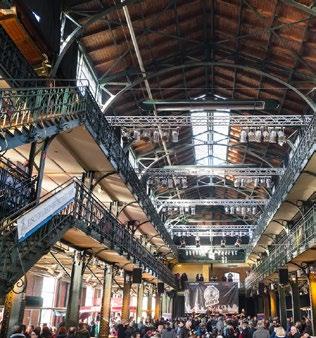
BRÜCKE 10
Fischmarkt has cheerful sellers of meat, fish, vegetables, clothes, house plants and antiques, among other things. The restored Fischauktionshalle (fish auction hall) is 100 years old. A lot of goods are traded there, from old porcelain to live geese. This market is famous for its delicious food and live music.
Große Elbstraße 9
In the period before Christmas, wooden sheds are put up in the crowded center of the city at Town Hall square (Rutausmark) for a market that takes place from late November to late December. Every Saturday, there is a spectacular show for children, a Hamburger Weihnachtsparade parade - a fun procession with Santa Claus, deer, elves and other characters. The St. Pauli district hosts a most amazing market where the boundaries between Christmas traditions and frivolous entertainment are erased.
If you go to the river through the port, visit this café, where they make the best fish sandwiches in Hamburg. The fact that Brücke 10 has the best sandwiches and the freshest fish is widely known, so you will meet many locals here. You will also find ship crew who come here as soon as they arrive on shore to have a quick bite and, of course, drink a beer.

Apart from the delicious dishes, you can watch the ships enter and leave the port. There are not so many tourists on this side of the port, which makes it ideal and the quietest place to watch the sunset.
Tip: Try a crab sandwich (Krabbenbrötchen), which is a bit expensive but I assure you it’s worth it.
Pauli Landungsbrucken
ISEMARKT
This market, stretched across one kilometer with more than 200 merchants, is the largest in Europe. If you are a fan of street food, the Food Truck Sessions is for you. Every Thursday, up to 15 food trucks offer experimental and tasty dishes. Tables are set up in the market for everybody across 100 meters, where you can eat, drink and get to know people.
Tip: Search for a stall selling little smoked pigs and definitely try one. This is a traditional German dish that will undoubtedly be to anybody’s liking.

Isestraße 1-73
The fairs are open: everyday - 11.00 am - 08.00 pm, Sundays01.00 pm - 08.00 pm; Closed on December 24th.
The tradition of Christmas tree decorating has spread from Germany to all over the world. There is a folktale that this tradition was started by German reformer Martin Luther.

In 1513, when he was returning home in the evening, he was mesmerized by the beauty of the starry sky, and it seemed as if the tree trunks were shining as well. Luther put a Christmas tree on a table and decorated it with candles and put up a star on the top as a symbol of the star of Bethlehem. In general, the Christmas tree was a sacred tree for ancient Germans, who believed that the spirit of the forest, which protected nature, lived in its needles.
COMMENT
More than 500 years ago, Martin Luther published his 95 Theses and radically changed the world as a result. This year marks the 500th anniversary of the Reformation in Germany.
The hammer is a typical symbol of the reformer – Luther has been immortalized in the image of him, on December 31, 1517, approaching the heavy wooden door of Wittenberg Cathedral and nailing his 95 Theses to it. In this document, Luther criticizes the Catholic Church and demands a change in the faith. The fact that Luther may not in fact have actually nailed his thesis to the door does not matter to Protestants. The main thing for them is Luther's persistence, irreconcilability, and the fact that he was not afraid to express his criticism - the courage that was expressed in words: "Here I stand, I can do no other."

120 VOYAGER 9/2017
St.
BUDAPESTER SCHUHE
The shop offers shoes from more than 200 brands (Crockett & Jones, Santoni, Giuseppe, Zanotti, Jimmy Choo, Gucci, Prada, Dsquared, Moreschi, Alden, Bottega Venetta) for women and men.

UNGER HAMBURG
This is the meeting place of tradition and high fashion. Located in the heart of Hamburg, Unger Hamburg houses exclusive designer brands from all around the world over in a 1,200 sq. m. area. Here, you’ll find everything from French haute couture to high-quality Italian everyday clothes to fashionable, luxurious American ready-made clothes.
Apart from the stunning selection of accessories, shoe, bags and other items, you can also visit exclusive Dior and Céline shops in the Unger Hamburg area.


Open: Friday - 09.00 am - 07.00 pm, Saturdays - 10.00 am -07.00 pm
Neuer Wall 35
SECONDELLA
This is the best vintage commercial space in Hamburg. You’ll find not only high-quality second-hand items but also first-class new items.
In two vintage stores stretched over 400 sq.m., you will find wondrous, high-quality items created by legendary designers. Secondella offers items from famous brands, while Secondella Depot sells mixed products by young designers. On the second floor of the store, you have the last chance to buy items for a price of €10 to €100.
OMEN
This world-famous brand was founded in Hamburg in 1968. Omen's clothes and accessories can only be purchased in this brand’s stores - Thomas I Punkt.

The women’s and men’s clothes are designed in Hamburg and are manufactured there in small factories. The products, created with love and professionalism, are of high quality. The focus is on the details.
Thomas I Punkt stores are especially loved by skaters – fans of handmade clothes and accessories – but you can see street and business-style clothes, shoes, backpacks and other interesting accessories side by side here.
Open: Monday - Saturday 10.00 a.m.08.00 p.m.
Mönckerbergstraße 21, Gänsemarkt 24
Open: Monday-Friday _ 10.00 am08.00 pm, Saturday 10.00 am -07.00 pm
Here you can find male, female and now children’s clothing and accessories created by more than 100 top designers. Among them you will find Hèrmes, Chanel, Prada, Gucci, Miu Miu, Marni, Louis Vuitton, Zegna, Omen, Yamamoto, Bottega Veneta, Nancy Gonzalez, Fendi, Balenciaga, Christian Louboutin Moncler, Bonpoint, Brunello Cucinelli and other brands.

Open: Monday-Friday 10.00 am -07.00 pm, Saturdays at 10.00 am - 06.00 pm
KEIL MASSSCHUHMACHEREI
Using traditional methods that have been passed down through the generations, Thomas Kyle makes leather shoes by hand. This cobbler’s store will take you back in time, and the tools and shoes create a special atmosphere. Due to a large store window, curious passers-by often stop and watch Kyle, who sits at his desk as he makes a shoe, polishing its surface and waxing and gluing it together.

Keplerstraße 20, Ottensen; www.keil-schuhe.de
PERLE
Customers will be delighted by the tastefully selected items from fashion collections in the Sabine Brandt concept store. You will find wonderful designer clothing and unique home accessories here – from unusually long matches and soaps with special aromas to exquisite presse-papiers. Perle is an ideal place for gift shopping.
Großneumarkt 22, Neustandt
121 VOYAGER 9/2017 MARKETS / SHOPPING / HAMBURG
Hohe Bleichen 5
Neuer Wall 30
BAR DACAIO
After The George Hotel opened in the location between the railway station and the Alster lake, this place officially became the gathering place for creative and fashionable people. The hotel is reminiscent of a British gentleman's club – you will definitely be served a 5 o’clock
LE LION
This bar is mentioned among the 50 best bars in the world. It is included in the annual ratings of many publications, so do not be surprised when you will need to ring a doorbell to get in. When you are let inside, you will find

tea at the bar. This place is also famous for after-dinner drinks. In summer, you can have a cocktail on the rooftop terrace and enjoy the view of Alster.
Barcastraße 3, St. Georg
yourself in a classic, dark bar, illuminated in all the necessary areas.

If you are lucky, you will meet the bar’s chef Jorg Meyer, who is also the owner of this joint and a world-class bartender. It was him who invented the Gin Smash cocktail with basil, which should be tried by everybody at least once.
Rathausstraße 3
MAD ABOUT JUICE
The bar is famous for its freshly squeezed juices which are served in small glass bottles with a straw. It is very difficult to choose among any of the tempting names, for instance - "Back to the roots" (beets, carrots and apples), "Gold Digga" (oranges, carrots and ginger) both have a unique taste.
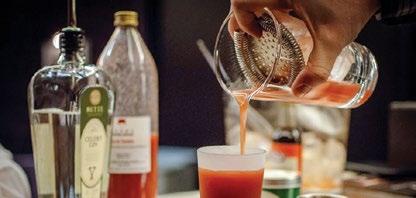
Even the sweet drinks offered here have healthy ingredients and if you are hungry, you can choose one of five different sandwiches.

Mühlenkamp 12, Winterhude
HEIMAT KÜCHE+BAR

You can enjoy fresh pastries and a home-style schnitzel, burger or fish chips in Heimat Küche + Bar. Guests can sit on cozy carpets or modern wooden chairs. There are huge windows here. The materials and elements used in the interior design are thematic extensions of the nearby port.
In the evening, Heimat Küche + Bar conducts live music evenings with young Hamburgian artists or dance nights with Ds.
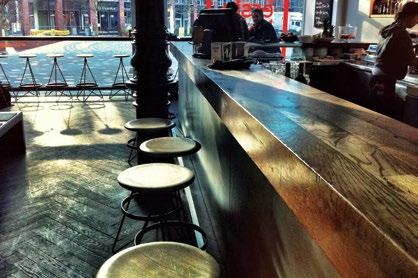
Überseeallee 5, HafenCity
STRANDPERLE
This beach bar constructed on the banks of the River Elbe, which survived all of the storms and floods, offers a wonderful environment. You can sit on the wooden terrace, plant your feet in the sand and watch the water while the cargo ships and cruise liners pass you by.
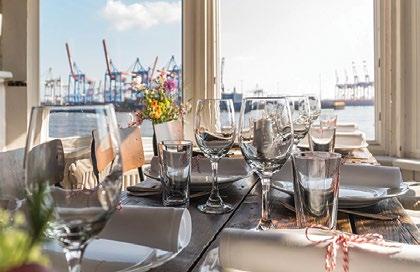
This great pleasure is coupled with delicious waffles and burgers – life is wonderful here.
COMMENT:
OSCHÄTZCHEN
Oschätzchen means "oh, the little treasure" and it's hard to believe that this is the real name of the owner. The treasure that he sells is mainly food: precious oils, exotic spices and hand-made chocolate; many varieties
ERSTE LIEBE BAR
This bar, which, apart from offering food and drink, devotes a large space to art and design, would ideally fit in London’s Soho district. The photos, street art, installations, textile design and works of world famous artists appear as part of ever-changing exhibitions. In the morning, they serve breakfast here; the often-updated lunch menu includes pasta, salads and hand-made pastries.
Michaelisbrücke 3, Neustadt
of tea line the old-style shelves. Hamburgian connoisseurs also adore his porcelain, canvases and decorative items.
The service personnel are true experts when it comes to packaging.
Hohe Bleichen 26, Neustadt
122 VOYAGER 9/2017
Övelgönne 60, Othmarschen
GOLEM
The local barmen are true alchemists. You can try the best cocktails in Hamburg here. The DJs play live. Suddenly, a secret door hidden between the shelves and cupboards opens, leading you to a semi-basement below, where you will find a second dance floor with other DJs playing dance music.
The best time to come here is from 11.00 p.m. to midnight.
Große Elbstraße 14
H1 CLUB
This great club gained its unprecedented popularity in a short space of time. Up to 900 people visit it on a weekly basis. People visit every week. The continuous party takes place over a 700 sq.m. area.
Open: Everyday - 11.00 p.m. - 06.00 a.m.
Conventstraße 8-10
PAL
This is a night club with three musical directions: electronic music, house and hip-hop. The atmosphere is amazingly joyful and people dance all night. Thanks to the distinctive music and constantly rotating DJs, it's easy to lose yourself to dance. If you are not looking for strong sensations and enjoy the bar and dancing till the dawn, then PAL is the ideal place for that.
Karolinenstraße 45
GOLDEN CUT
KLEINER DONNER
Kleiner Donner is located in the semi-basement; you will find yourself on the dance floor as soon as you walk down the stairs. Wooden walls, a well-lit bar and a DJ cabin – that is all that meets you here. The club is very small but if you love dancing, hip-hop and other similar rhythms, and like active movement and demonstrating various dance styles, then this is the ideal place for you. It's impossible not to dance. If there is no concert, the bar doors are open at midnight (on Fridays and Saturdays).
Schulterblatt 73
THE CULTURAL LIFE OF HAMBURG, CONSIDERED THE THIRD LARGEST MUSIC METROPOLIS IN THE WORLD AFTER NEW YORK AND LONDON, IS FULL OF UNEXPECTED SURPRISES. THE MUSICAL CAREER OF THE BEATLES WAS LAUNCHED IN THIS VERY CITY. THE BEATLES' STATUE STANDS ON THE INTERSECTION OF REEPERBAHN AND GROSSE FREIHEIT STREETS IN THE ST. PAULI DISTRICT. THIS IS THE AREA WHERE THE LEGENDARY BAND PERFORMED FOR THREE AND A HALF MONTHS IN 1960 IN INDRA, KAISERKELLER AND THE TOP TEN CLUB.
MOONDOO
The nightclub was previously called Top Ten, and The Beatles performed here. Currently a legendary New York DJ, Afrika Islam Moondoo, is working here. This club was opened in 2008 and is currently the most popular place in the city where many party lovers come to enjoy a modern combination of electronic, disco and funk music.
Reeperbahn 136, St. Pauli

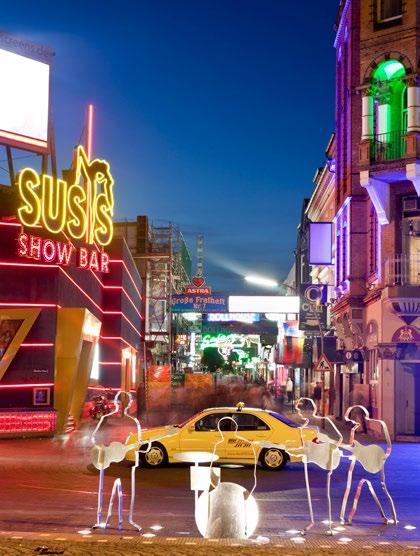
This is the most popular club among those located outside of Hamburg. Seven hundred people enjoy the weekend by partying hard to select and diverse music on both of its floors every Friday and Saturday.


Golden Cut - this is the meeting place of success-oriented people – those who appreciate the club's exclusivity.


Open: only on Fridays and Saturdays23.00 p.m. - 6.00 a.m.
Holzdamm 61
123 VOYAGER 9/2017 BARS / CLUBS / HAMBURG
IF YOU WANT TO FULLY EXPERIENCE THE ATTRACTION OF HAMBURG NIGHTLIFE, YOU SHOULD VISIT THE ST PAULI DISTRICT. ONCE AN ENTERTAINMENT AREA FOR THE SEAMEN, THIS NOTORIOUSLY "SINFUL PLACE" HAS SINCE BECOME MORE THAN JUST THE HOME OF EROTIC ESTABLISHMENTS. NOWADAYS THERE ARE MANY FAMOUS BARS, DISCOS AND CULT CLUBS HERE.
FRANKFURT AM MAIN
THE ECONOMIC CAPITAL OF GERMANY AND ONE OF THE WORLD'S LARGEST FINANCIAL CENTERS, FRANKFURT IS GOETHE’S HOME TOWN AND A CITY OF MANY OPPORTUNITIES. FRANKFURT INTERNATIONAL AIRPORT IS ONE OF EUROPE'S LARGEST HUBS AND SERVES MORE THAN 130 MILLION PASSENGERS ANNUALLY.
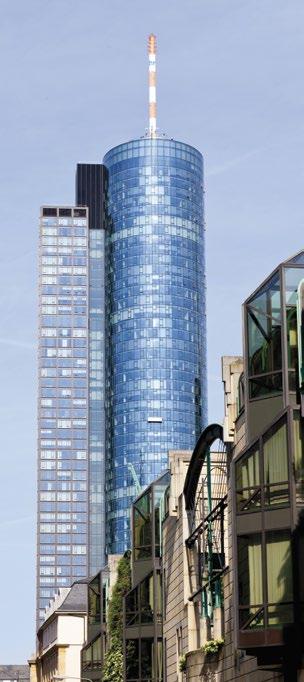


AMID THE TRADITIONAL-STYLE BUILDINGS.
GOETHEHAUS
The house of one of the greatest poets and writers of all time, Johann Wolfgang Goethe, where he was born on August 28, 1749, and lived until 1775, was completely

destroyed during World War II. It was the first building that the locals decided to rebuild in the devastated city. It’s now a museum: you can visit the original study room where the great writer created such masterpieces as "The Sorrows of Young Werther”, "Elective Affinities" and "Faust".
Open: Monday to Saturday – 10 a.m. – 6 a.m. and Sunday – 10a.m.- 5:30 p.m.
Price: 7€
Großer Hirschgraben 23-25
FRANKFURTER
RINDSWURST — This famous beef sausage, according to legend, was invented by the Frankfurtians in 1894 in order to have a sausage without pork.
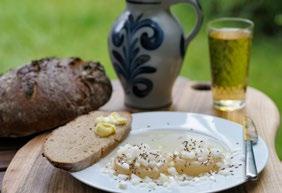
RIPPCHEN MIT KRAUT pork ribs, usually served with pickled cabbage, mashed potatoes and German mustard.
FRANKFURTER BETHMÄNNCHEN a local Christmas dessert made with marzipan, almond and rose water.
APFELWEIN low-alcohol apple wine, made of apple juice.
Every October, Frankfurt hosts the world's largest book fair. Authors, translators, illustrators, and agents from all over the world go to Frankfurt to seek new opportunities. Over 300,000 people visit the fair.
MAIN TOWER
The 205m-high skyscraper is named after the river Maine. Its construction was completed in 1999 and includes the offices of large corporations and banks, including Helaba, Merrill Lynch and Hessischer Rundfunk. The restaurant and bar on the top floor offer the city's most impressive panorama from its terrace. Visitors can take an elevator to the terrace that moves at a speed of seven meters per second.
Working hours: SundayThursday – 10 a.m. – 9 p.m. Friday-Saturday - 10 a.m. – 11 p.m.; The terrace is closed during strong winds and freezing temperatures. Price of skyscraper entrance: 5€
Neue MainzerStraße 47
Georgian publishers regularly attend the Frankfurt Book Fair. However, in recent years, this event has acquired special significance, since Georgia will have special guest status at the 2018 edition of the event.
In 2017, France held this honor, while next year Georgia will have special guest status.
IN THIS CITY OF SKYSCRAPERS, THE MEDIEVAL HISTORIC CENTER IS GREATLY CHERISHED. THE LARGEST INVESTMENTS IN MODERN ART AND CULTURE IN THE COUNTRY HAPPEN HERE.
THE MAIN SQUARE OF FRANKFURT’S HISTORICAL CENTER IS SCATTERED AROUND ROMERBERG CITY HALL, WHICH DATES BACK TO 1405. THE FAMOUS CHRISTMAS MARKET TAKES PLACES HERE
124 VOYAGER 9/2017
THE FOURTH LARGEST CITY IN GERMANY IS LOCATED IN THE NORTH RHINEWESTPHALIA REGION, A FEW DOZEN KILOMETERS FROM THE BORDER WITH BELGIUM AND THE NETHERLANDS. THE POPULATION OF THIS MEGAPOLIS EXCEEDS 10 MILLION. COLOGNE WAS FOUNDED BY THE ROMANS IN 30 AD. DISTINGUISHED FOR ITS VAST ARRAY OF CULTURAL HERITAGE SITES, COLOGNE IS ONE OF THE MOST IMPORTANT ARTS HUBS IN GERMANY.
KÖLNER DOM
This masterpiece of Gothic architecture – the Cathedral of St. Peter and Mary – is considered to be one of the most beautiful cathedrals in the world. The cathedral’s construction began in 1248 and ended in 1880.
During World War II, when 90% of the central part of the city was destroyed, it was the only building in the historic center of Cologne to survive, despite the fact that it was hit by 14 shells and consequently required partial reconstruction. The height of the cathedral is 157 meters. Its most important section is "The Altar of the Magi" where, according to legend, the


TO GET AN UNFORGETTABLE EXPERIENCE, WE RECOMMEND YOU TAKE A CRUISE ON THE RHINE RIVER. THIS WILL ALLOW YOU TO OBSERVE COLOGNE AS WELL AS THE BANKS OF THE NEARBY CITIES OF DUSSELDORF AND BONN FROM THE MIDDLE OF THE WATER. THE COST OF THE TOUR DEPENDS ON THE DURATION AND TYPE OF SERVICE. ONE-HOUR TOUR COSTS 12.53 €.
KÖLN
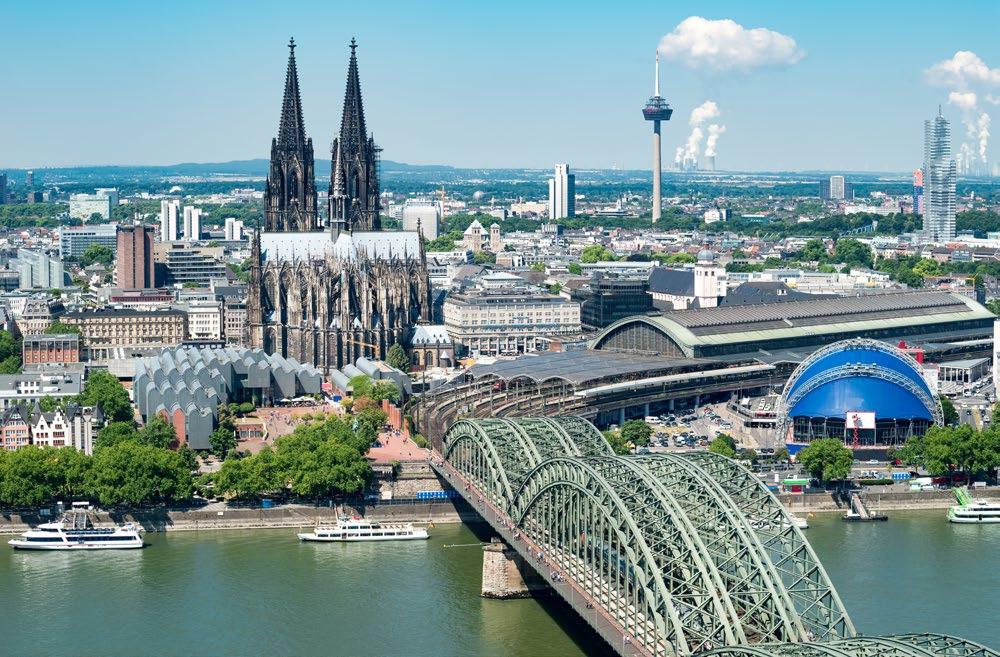
sacred parts of the Nativity Magi are stored. The cathedral floor was decorated in the 19th century by Villeroy & Boch mosaic, while the windows are decorated with glazing by the famous German painter Gerhard Richter. Since 1996, the cathedral has been listed on
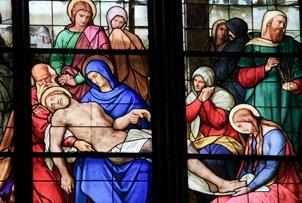
the UNESCO World Heritage Sites as a "genius work of human creativity".
Open: everyday from November to April - from 06.00 am to 07.30 pm. Climbing the cathedral tower (590 steps) costs 4 €, visiting the treasury - 5 €.
Domkloster 4
DUFTMUSEUM IM FARINA-HAUS
"I have found an aroma that reminds me of an Italian morning in the spring, mountain narcissus and orange tree flowers after the
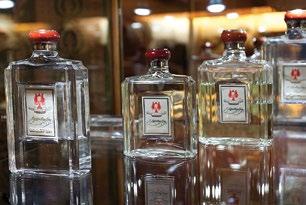
KÖLNER SEILBAHN
One of the oldest ropeways in Europe has served its customers since 1957. It connects two river banks. The length of the ropeway is 935 meters; crossing takes 7 minutes, and its most colorfully painted gondolas allow for beautiful views of the river and the city.

Riehler Str. 180
rain. This fragrance refreshes me and intensifies my feelings and imagination.” These words were written in 1708 by a young Johann Maria Farina from the city of Cologne to his brother Jean Baptiste about the fragrance known today as Eau de Cologne, produced by an Italian family in Germany. Among the consumers of these fragrances were emperors, kings, Mozart and Marlene Dietrich. Since copyright did not exist back than, the Farina formula had many imitators, even going as far as overtaking the name "Eau de Cologne" – the fragrance which was originally created in Cologne. In 1925 a museum was added to the fragrance factory.
Open: Monday- Sunday - 10.00 am -07.00 pm, Sunday - 11.00 am -05.00 pm
Obenmarspforten 21
125 VOYAGER 9/2017
PREVIOUSLY THE ROYAL RESIDENCE OF THE RULERS OF PRUSSIA AND ADMINISTRATIVE CENTER OF BRANDENBURG, CONTEMPORARY POTSDAM IS ONE OF GERMANY'S MOST BEAUTIFUL AND EXPENSIVE CITIES. THE CITY IS KNOWN FOR ITS LAKES, GARDENS, AND LUXURIOUS PALACES AND HAS BEEN A UNESCO WORLD HERITAGE SITE SINCE 1990. POTSDAM IS JUST 25KM AWAY FROM THE CENTER OF BERLIN. THE MOST CONVENIENT WAY TO GET THERE FROM BERLIN IS BY REGIONAL EXPRESS TRAIN (TRAVEL DURATION - 20 MINUTES) OR BERLIN SUBURBAN TRAIN (S-BANN; TRAVEL DURATION - 40 MIN).
SANSSOUCI
Built in 1745-1747, the former summer residence of the king of Prussia Friedrich II is the city’s the main attraction. Sanssouci is often referred to as the German Versailles. Friedrich the Great, infatuated with art, decided to build this royal palace partially using handdrawn sketches. He ordered the construction of the main residence in the Rococo style, to be designed by the great architect of that time Georg Wenzeslaus von Knobelsdorff. The inscription “Sanssouci”, which adorns the main facade of the building, means "carefree" in French.
The one-storey residence was built in 1745-1747. It is located in a 290-hectare park and is built on a hill, atop a terraced vineyard. In addition to Sanssouci palace, another Royal construction, the New Palace, was built as a part of the complex by Friedrich II. It is a good example of Prussian Baroque style. Friedrich II built it for noblemen and guests, but it became the royal residence of the third and last emperor of Prussia, Kaiser Wilhelm II.
The Sanssouci complex also includes a number of secular and religious buildings, royal gardens, fountains, green houses and galleries that host collections of works by Caravaggio, Van Dyck, Rubens and other great artists. The complex, unlike the historic center of the city, fortunately, survived World War II and still gives us a glimpse of the brilliance of the epoch's royal art.
FILMPARK BABELSBERG
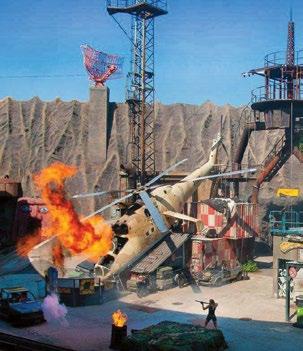
The world's oldest film studio was founded in 1912 and is still regarded as one of the most prestigious and high-budget cinematic centers. In the last decade, Quentin Tarantino, Roman Polanski, George Clooney and Wes Anderson have worked here.
CECILIENHOF
The Cecilienhof Palace is associated with many significant historic political events. One of them is the 1945 Potsdam Conference, where the world leaders of that time - Churchill, Stalin and Truman - met in the Keiser Wilhelm II palace, Cecilienhof, to decide the fate of the world.
 Im Neuen Garten 1
Im Neuen Garten 1
The Sanssouci residence is open from Tuesday to Sunday 10.00 am – 06.00 pm




Admission price: €12.00
Maulbeerallee

To delve deeper into the history of the film studio, you can visit Babelsberg Cinema museum, whose rich displays include stage designs, costumes, models and photos of such celebrities as Asta Nielsen, Marlene Dietrich and Manfred Krug.
Großbeerenstraße 200
POTSDAM'S DUTCH QUARTER IS THE BEST PLACE FOR LUNCH AND SHOPPING. TODAY, IT’S ONE OF THE MOST CROWDED AND YOUTHFUL DISTRICTS OF THE CITY, ITS 18THCENTURY BRICK BUILDINGS BEING HOME TO MANY CAFÉS, BOUTIQUES AND GALLERIES.
126 VOYAGER 9/2017
POTSDAM
DRESDEN, THE ADMINISTRATIVE CENTER OF SAXONY, BUILT ON THE BANKS OF THE RIVER ELBE, IS OFTEN CALLED NORTHERN FLORENCE. THE CITY IS LOCATED IN SOUTHWEST GERMANY, NEAR THE CZECH BORDER, 149 KILOMETERS AWAY FROM PRAGUE, AND 194 KM FROM BERLIN. THE CONSTRUCTION OF A LARGE PART OF THE CITY’S HISTORIC CENTER, RENOWNED FOR ITS RENAISSANCE AND BAROQUE BUILDINGS, WAS INFLUENCED BY ITALIAN ARCHITECTURE, WHILE THE CITY’S OUTSKIRTS ARE RADICALLY MODERN, BOTH IN APPEARANCE AND RHYTHM OF LIFE.
ZWINGER
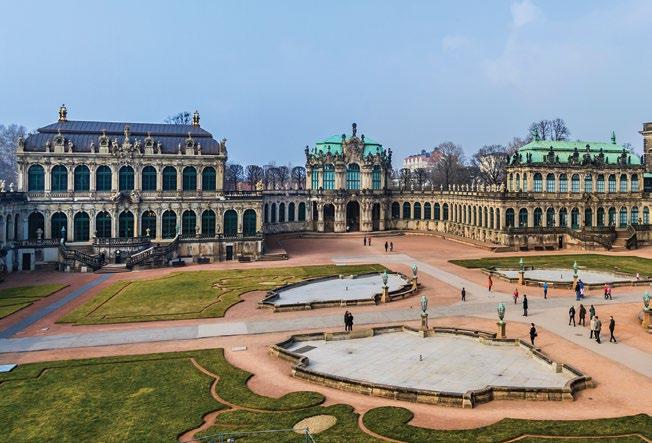
The architectural complex built by August II in the 18th century is one of the main attractions of the city. The local palace, greenhouse and gardens are a distinct example of the German Baroque. The museum hosts the Royal Pinacoteca, whose rich collection counts up to 3,000 paintings of the old masters. Among them are Giorgione's "Sleepinging Venus", Rembrandt's "The Abduction of Ganymede" and Rafael's "Sistine Madonna" – the main masterpiece of exposition. In addition to Pinacoteca, you can browse the collection of porcelain china and visit the Royal Cabinet of Mathematical and Physical Instruments.
Open: From Tuesday to Sunday - 10.00-18.00
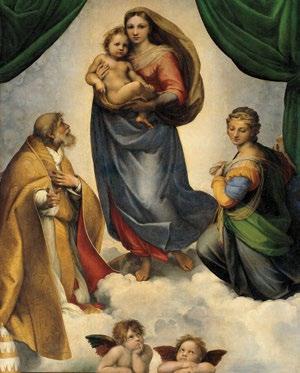
Theaterplatz 1
DRESDEN
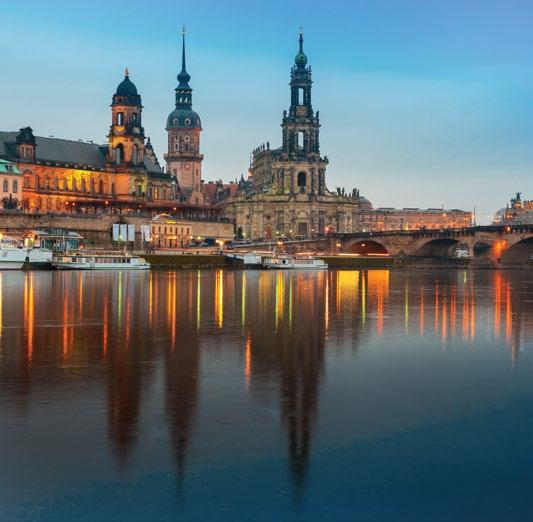

SEMPEROPER

The Saxon State Opera House is also called by its architect's name, "Semperoper". It simultaneously combines the Renaissance, Baroque and classical Greek architectural styles and is considered one of the most beautiful opera houses in the world. It hosted the premieres of such great composers as Wagner and Strauss. Today, the musical director of the theater is one the greatest conductors of our time - Christian Thielemann.
Theaterplatz 2
BRÜHL’S TERRACE
The terrace was built by Heinrich von Brühl in the 18th century on the ruins of the old city citadel. It is also referred to as "the balcony of Europe". This terrace, located between the Augustus and Carola bridges, overlooks the river Elbe and has the best panoramic view of Dresden, providing access to the most notable sights of the city. It was originally the private property of the nobility, but since 1814 has been a public space and is a favorite for both locals and tourists.
Georg-Treu-Platz 1
FRAUENKIRCHE
Dresden Cathedral dates back more than one thousand years: the original church was built here in the 11th century; a gothic cathedral stood on its foundations from the 13th century; and in the 18th century the architect George Bähr built the Church of Our Lady in the Baroque style. The Protestant Church was destroyed in 1945 towards the end of WWII. The cathedral’s reconstruction was completed in 2015. An organ crafted by the famous master - Daniel Kerns – has been housed in the cathedral since 2005 and classical music concerts are performed there frequently. Open: every day - 10 a.m. -6 p.m. , break time - 12 p.m. – 1 p.m.; admission is free, though visitors can make a donation to the cathedral.
Georg-Treu-Plats 3
127 VOYAGER 9/2017
DRESDEN AND THE RIVER ELBE VALLEY WERE INCLUDED IN THE UNESCO CULTURAL HERITAGE LIST UNTIL 2004. DUE TO INVASIVE CONSTRUCTION, THE UNITED NATIONS EDUCATIONAL, SCIENTIFIC AND CULTURAL ORGANIZATION WAS FORCED TO WITHDRAW THE CITY AND ITS MONUMENTS FROM THE LIST IN 2009.
"THE SUMMER CAPITAL OF EUROPE" – LOCATED IN THE SOUTHWEST OF GERMANY, BADEN-BADEN IS THE COUNTRY’S MOST CELEBRATED RESORT. ALONG WITH ITS THERMAL WATERS, FORESTS AND MOUNTAINS, THE RESORT’S POPULARITY WAS DRIVEN BY VISITS FROM CELEBRITIES SUCH AS MARLENE DIETRICH, LEV TOLSTOY, FRIEDRICH NIETZSCHE AND RICHARD WAGNER.



BADEN-BADEN
There are twelve thermal springs in the city, each offering different health benefits. People come here often to threat rheumatism, arthritis, respiratory tract and skin diseases, or just to enjoy spa procedures. The Romans called this city Aquae Aurelie - "the shining waters", so the ruins of the Roman baths are one of the most popular tourist attractions in Baden-Baden today. It is no coincidence that Baden-Baden is the setting for Dostoyevsky's "the Gambler": the city has many casinos, so apart from regular vacationers many gambling enthusiasts visit it. For the most part, people who choose to holiday in Baden-Baden are well to do and apart from the healthy environment and high-class service, the city offers other recreational activities such as a variety of cultural and sporting events also.
CAFÉ KÖNIG
Founded 250 years ago, Café König, the favorite café of Lev Tolstoy and Franz Liszt, attracts guests not only with its luxurious interior but with delicious pastries too. The local specialty is cake with berries: Schwarzwälder Kirschtorte
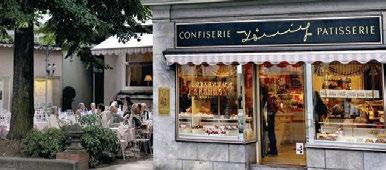
Lichtentaler Strasse 12
SCHWARZWALD
The "Black Forest National Park", 4 km from Baden-Baden center, is an ideal place for tracking or just walking or cycling in an ecologically clean environment. The park is full of waterfalls, lakes and streams, offering a magical panorama of the Rhine Valley and the Wogezy mountains.

FRIEDRICHSBAD
You may encounter a variety of animals or plant species included in the Red Book on the park’s territory.
This is a Roman-Irish thermal center where the Roman bath culture is combined with Irish sauna traditions. Depending on what one may need, visitors are offered 17 types of different health procedures. It is well known that after visiting this place, Mark Twain wrote to his friend: "After ten minutes in Baden-Baden baths, you will forget the existence of time, and in twenty minutes - the world itself."
This 140-year-old thermal center still retains its leadership status.

The thermal center opens every day from 9.00 am to 8.00 pm
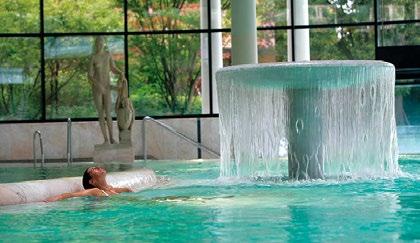
Price range depends on services: starting package - 25 €, Suites - 49 €, Luxury Plus - 59 €. Each service includes various types of massage.
TRINKHALLE
A neoclassical building in the center of the park, a Corinthian colonnade and a 90 m long painted portico. Previously a bath, this building now houses a tourist information center. Inside there is a spring of mineral water suitable for drinking, which as they say, is not only healthy but rejuvenating. We recommend you visit the local cafés and restaurants while in Baden-Baden.
Kaiserallee 3
Here, accompanied by a guide, you can visit the ruins of the Roman baths. The duration of the tour is 45 minutes, the cost - 4 €.
Römerpl. 1, 76530
128 VOYAGER 9/2017




BREMEN
GERMANY'S OLDEST PORT CITY IS MORE THAN 12 CENTURIES OLD.
ALTHOUGH BREMEN IS 60KM FROM THE NORTH SEA, IT IS BUILT ON THE WESER RIVER, AND THE CITY'S FAME IS HISTORICALLY ASSOCIATED WITH THE SEA.

The free town of Bremen is the second-largest German marine city after Hamburg. It used to be part of the Holy Roman Empire and Hanseatic League, a confederation of merchant guilds. With a population of 2.4 million, it is an industrial, student and cultural city all at the same time.

BREMER MARKTPLATZ
Bremen’s oldest and most attractive square was built in the time of the city’s founder Charlemagne. Its historical monuments - the Knight Roland statue and City Hall - are recognized as a UNESCO World Heritage Site. The largest and oldest fair, Bremer Freimarkt, is held every year in the second half of October and lasts 17 days.
BREMER RATHAUS
City Hall is the main attraction of the square. It was the residence of the senate and the city chair. It was originally built in the 15th century, in accordance with the rules of gothic architecture.
BREMER ROLAND
This symbol of freedom stands in front of City Hall. It depicts Roland, the legendary knight of Charlemagne and medieval hero. Roland was the defender and protector of Bremen. The height of the figure is 5.47 meters, and the whole sculpture exceeds 10 meters in length.

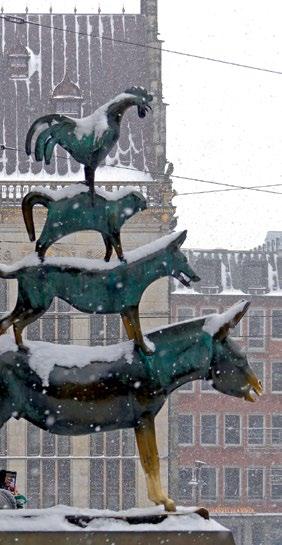
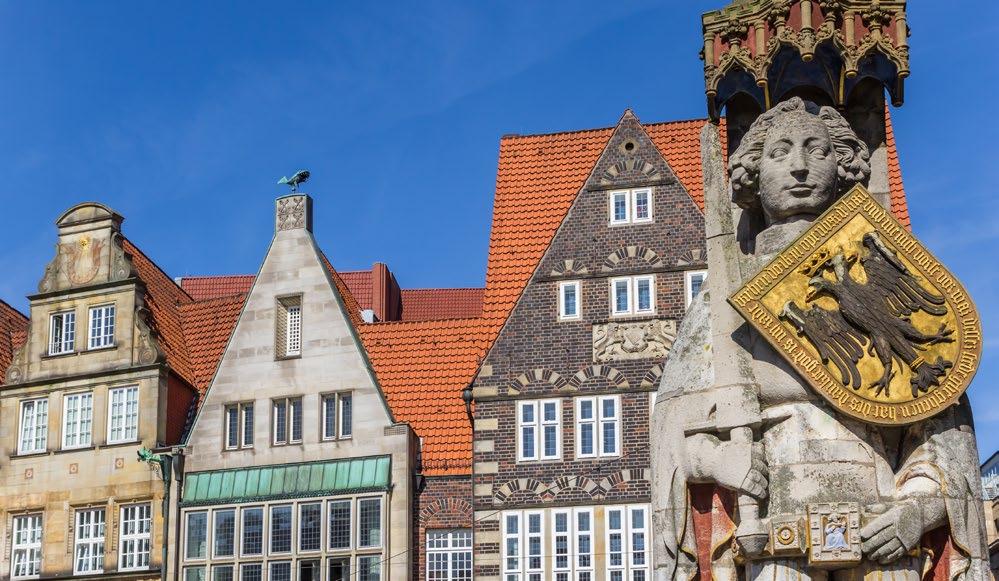
The Knight's shield has an inscription of the statement Roland made to the locals announcing that Charlemagne had liberated their city. The sculpture faces St. Peter’s Cathedral, as if presiding over the institution that was once the biggest threat to the independence of the settlement. According to legend, Bremen will be free as along as the sculpture of Roland stands in its square.
DIE BREMER STADTMUSIKANTEN
Another symbol of the city stands in front of the Die Bremer Stadtmusikanten’s west wall. This is a sculp-
At the beginning of the 17th century, it was changed to match the style of the Weser renaissance.
The building façade is decorated with sculptures and bas-reliefs of different eras. The Golden Hall and the 15th-century enotheca are especially interesting. St. Peter’s Cathedral, Bremen’s main cathedral, is located to the right of City Hall. The medieval church of the Virgin Mary is located on the left.
Am Markt 21
DAS VIERTEL
ture of the musicians of Bremen: a donkey, dog, cat and rooster who decided to go to Bremen and be musicians. Unfortunately, the fairytale dreamers did not reach their destination, but in 1953 sculptor Gerhard Marx made their dream come true and depicted the animals on each other’s back in Bremen's main square.
“Town Musicians of Bremen” is very popular among the tourists, and according to legend, if you touch the donkey’s leg and make a wish, it will come true.
This is an ideal place for shopping and nightlife. The city's most colorful and bohemian quarter simultaneously hosts theaters, concert halls, art galleries, pubs and bars that are open all night.
130 VOYAGER 9/2017





 ROBERT DE NIRO and BENJAMIN MILLEPIED, NY, 9am
ROBERT DE NIRO and BENJAMIN MILLEPIED, NY, 9am

























 Translation by Lika Barabadze
- Shutterstock GNTB
Translation by Lika Barabadze
- Shutterstock GNTB


















































































































































































































































 LASHA BUGADZE
LASHA BUGADZE
























 KAKHA TOLORDAVA
KAKHA TOLORDAVA





















































































































































































































 Im Neuen Garten 1
Im Neuen Garten 1




























